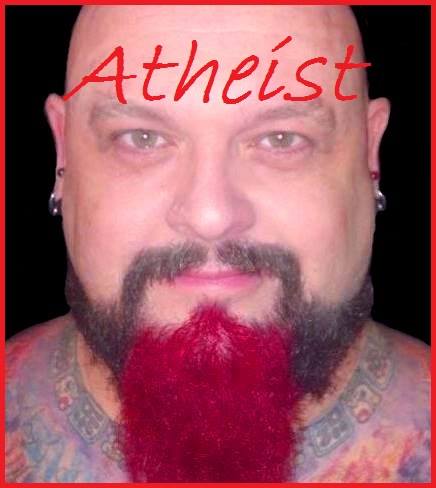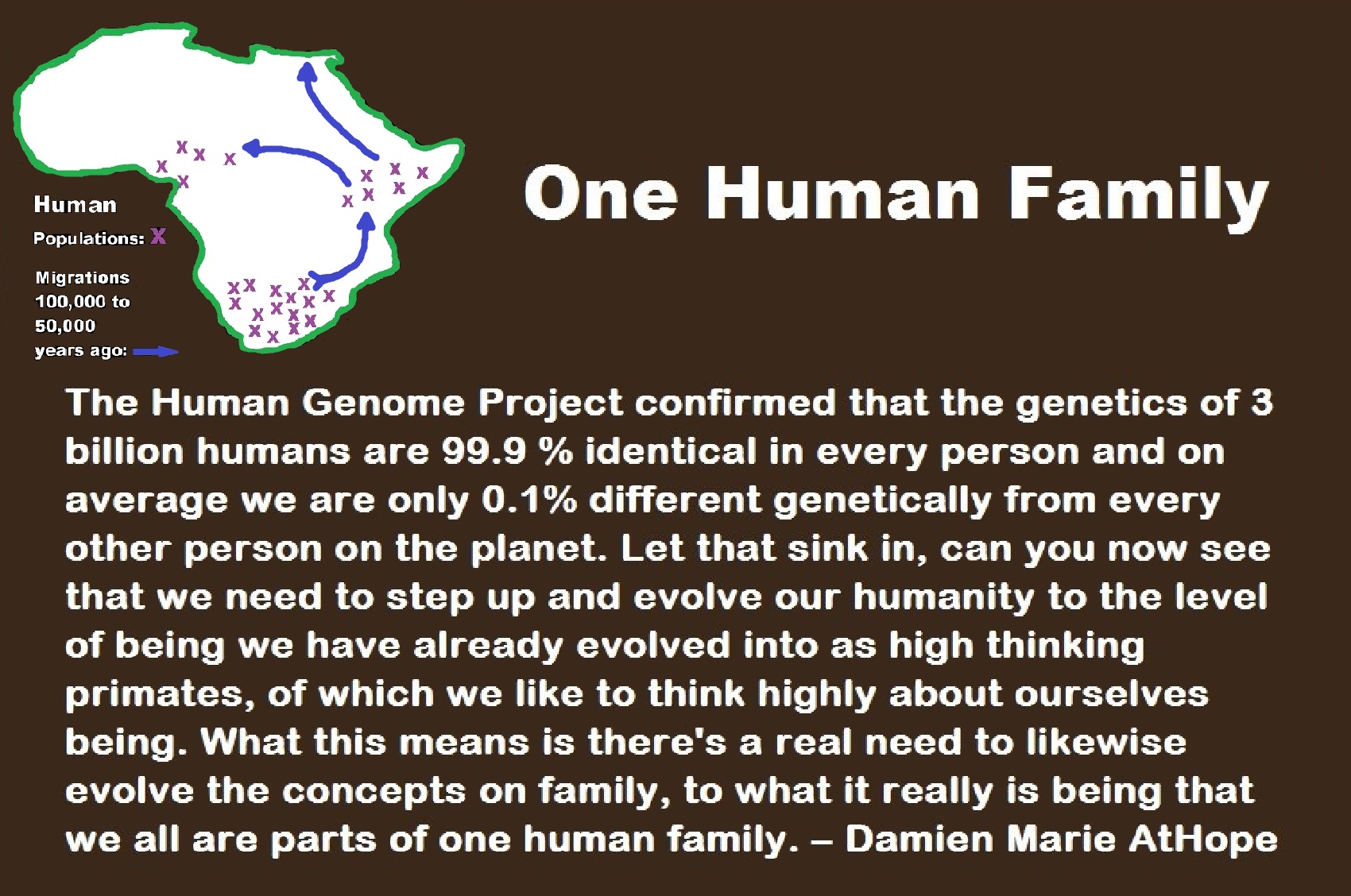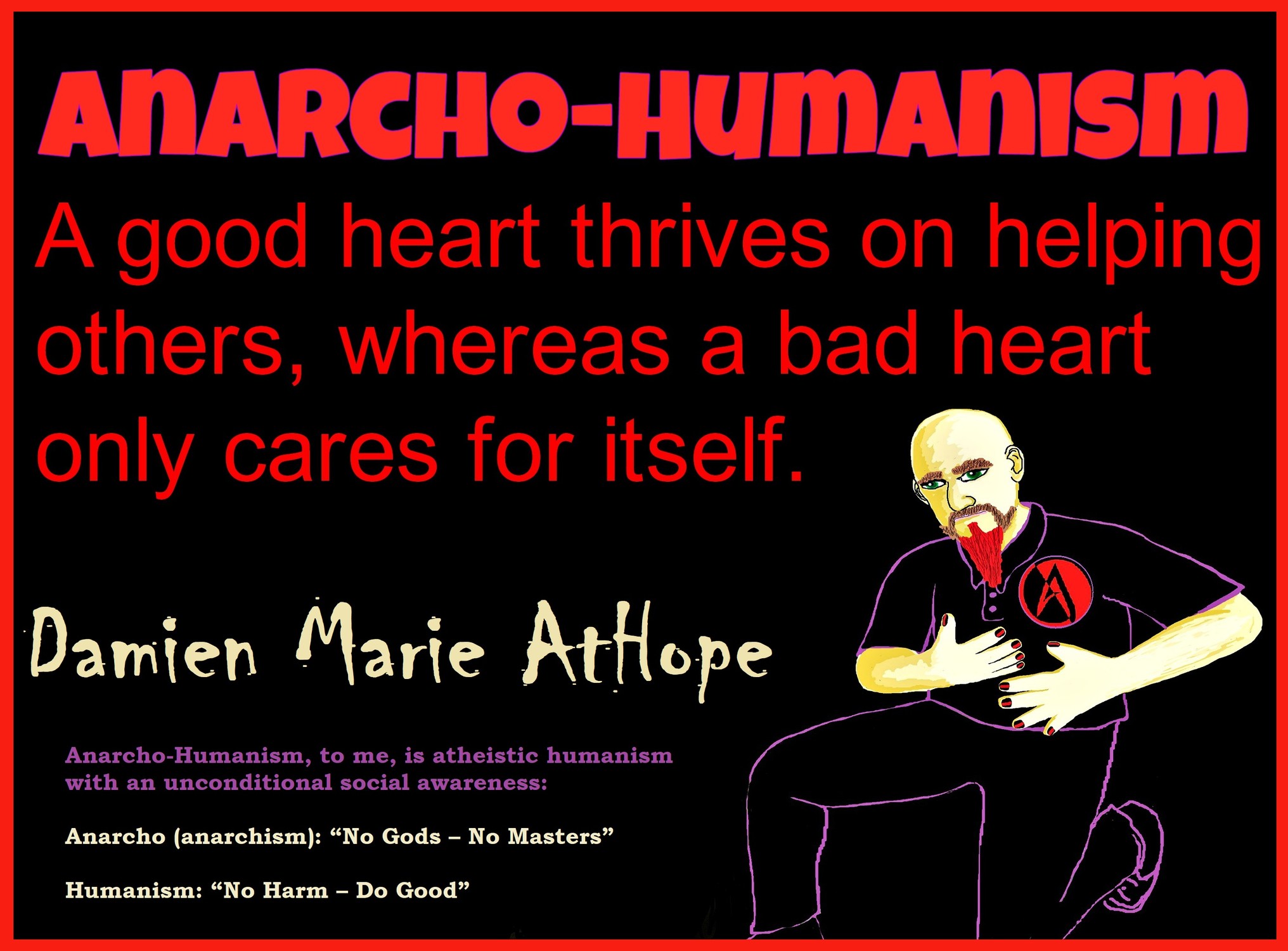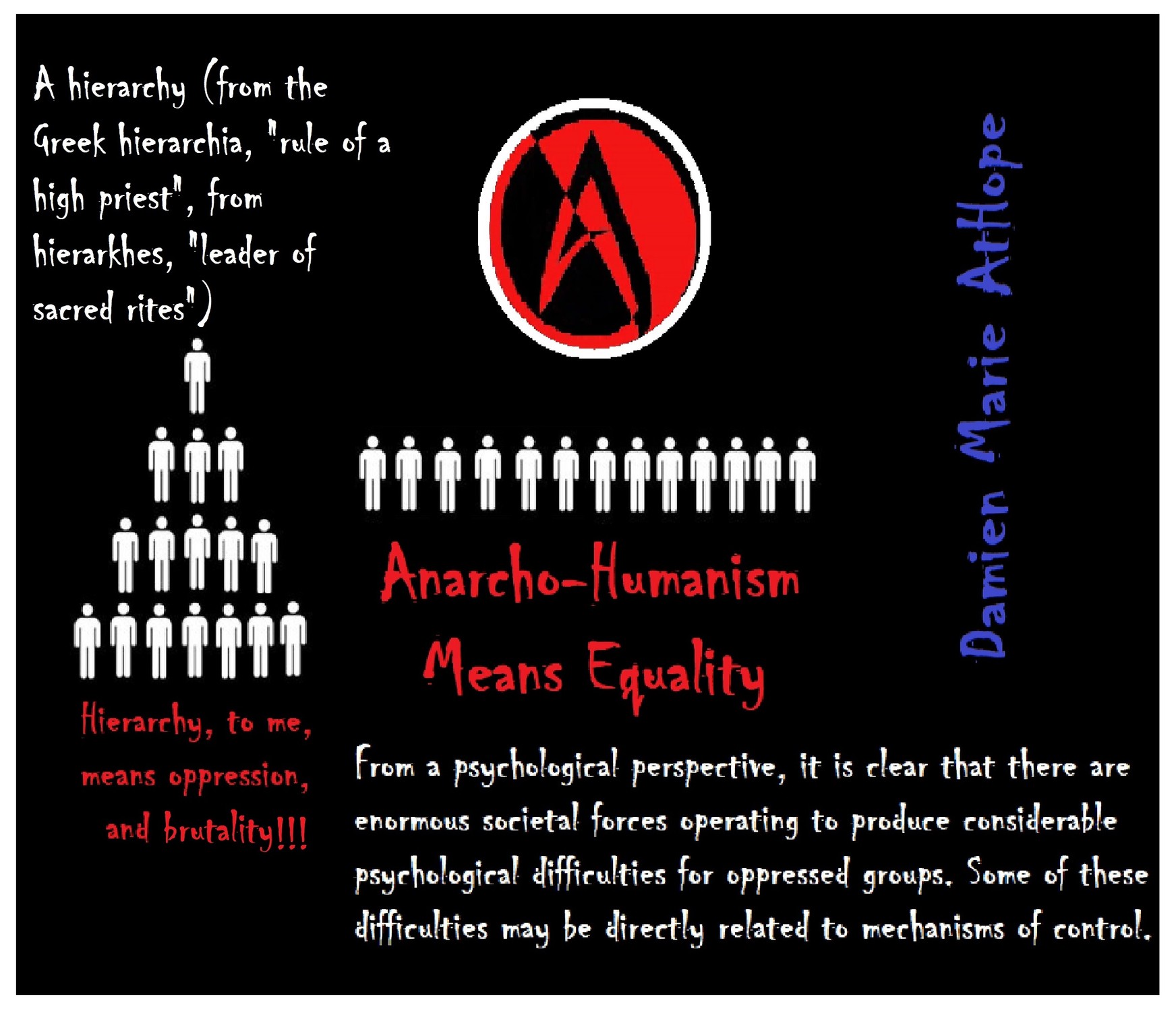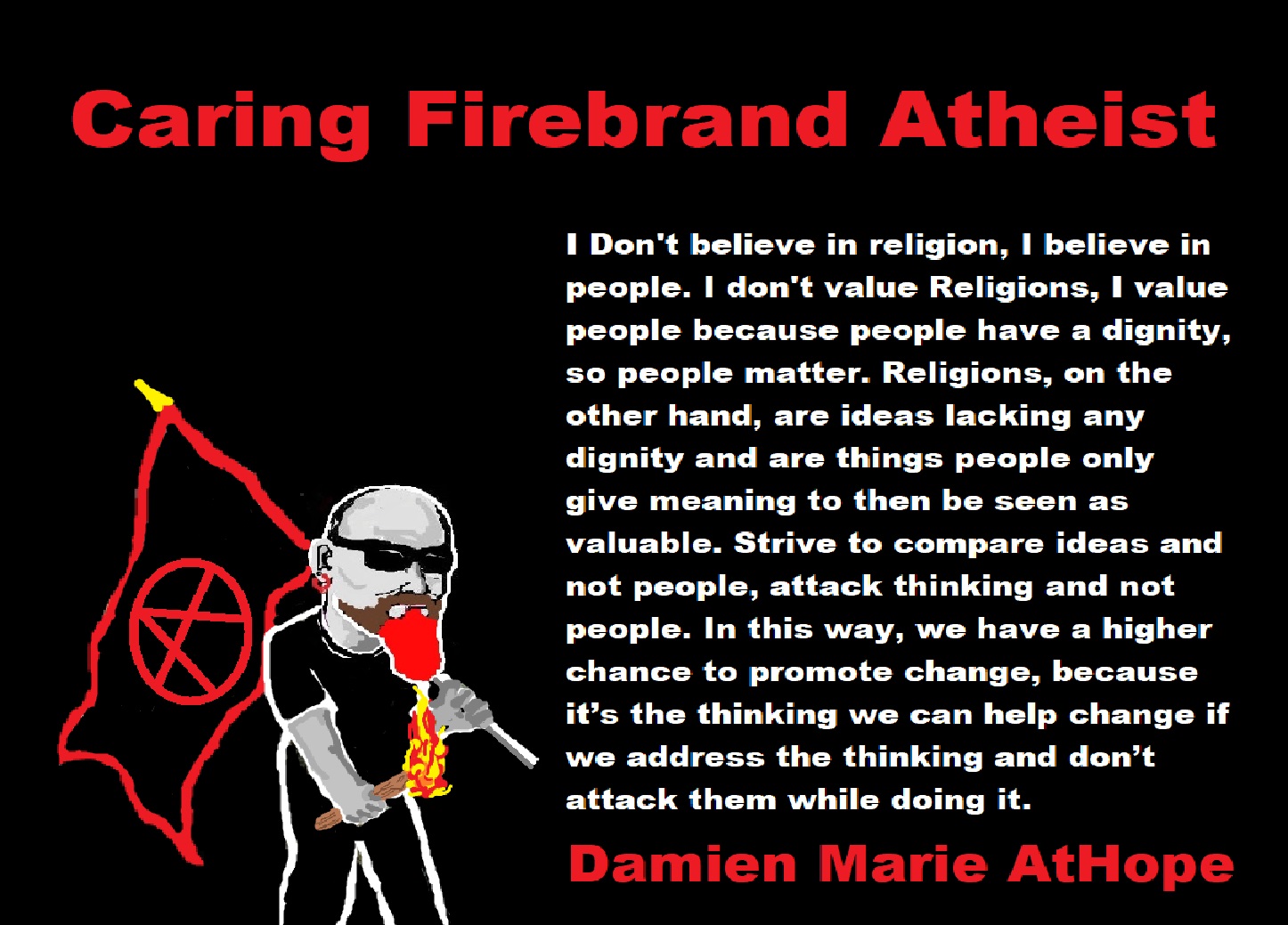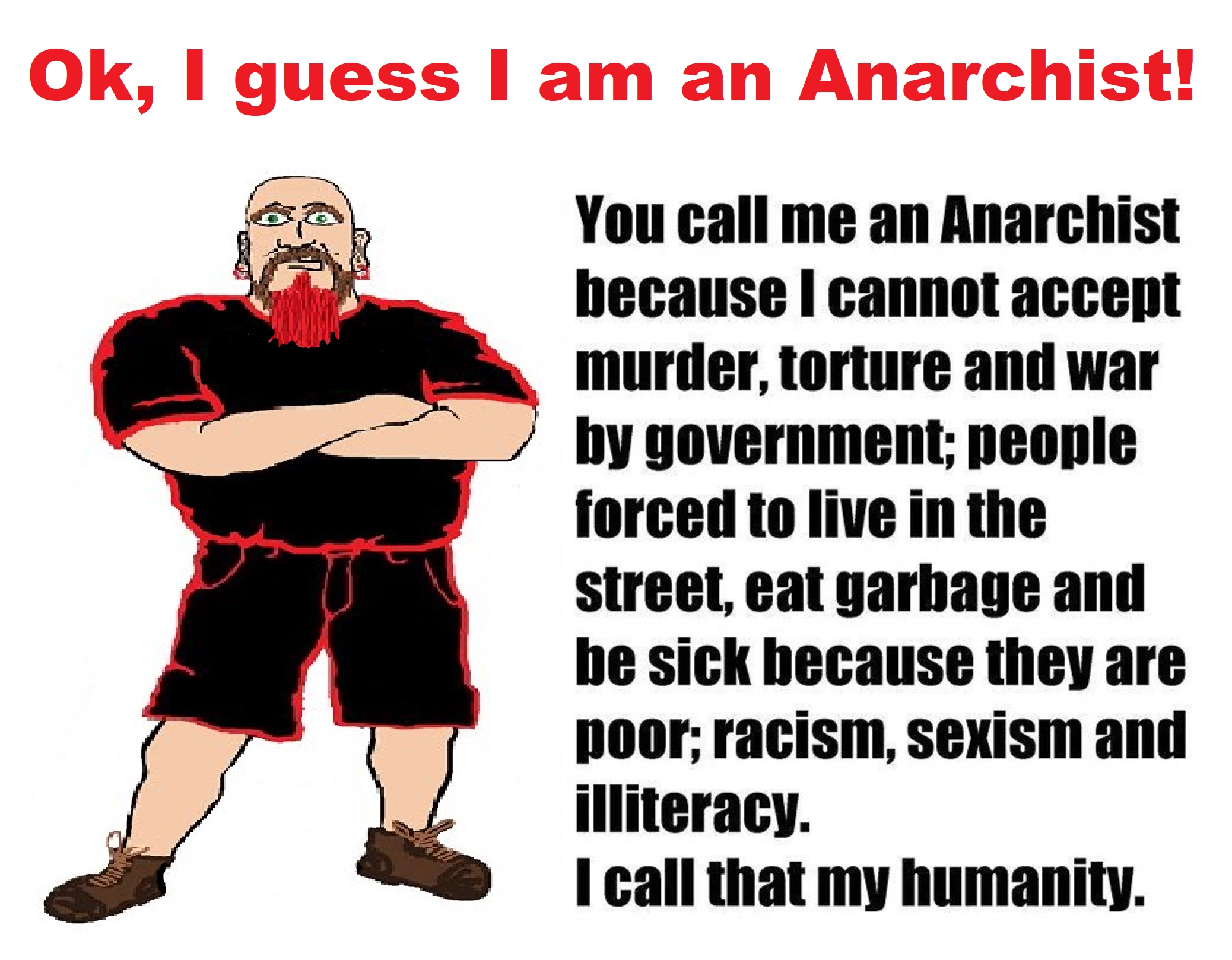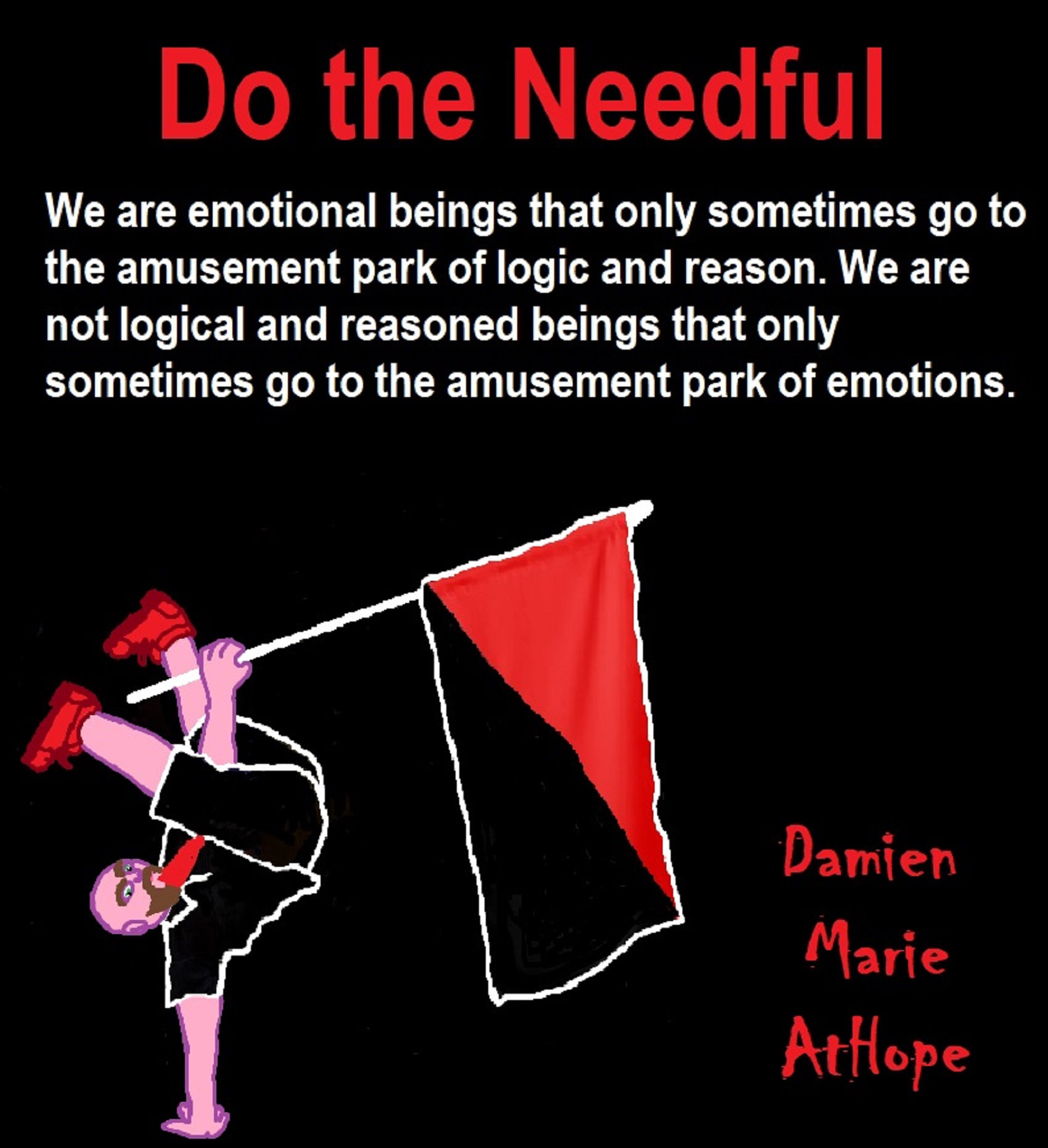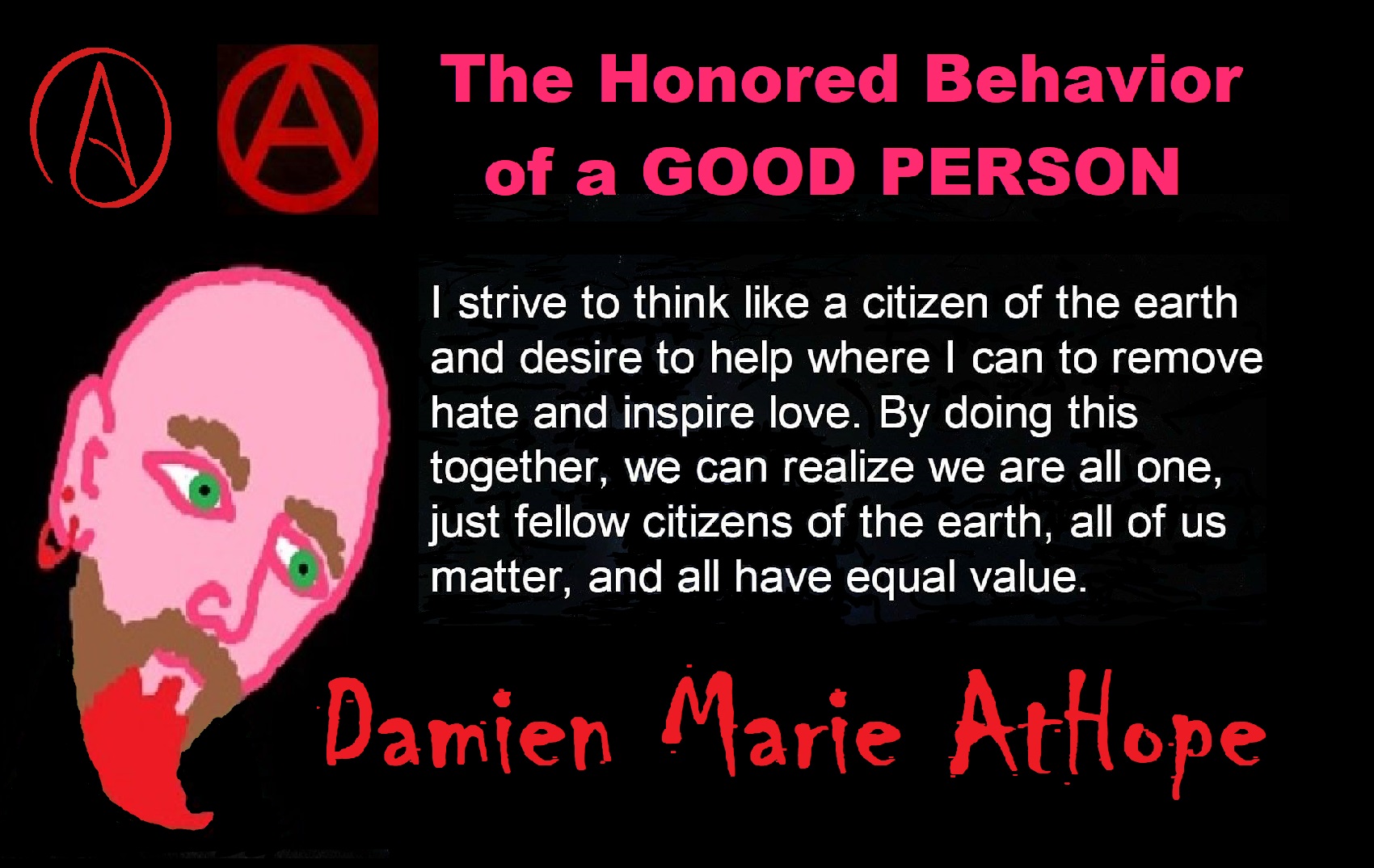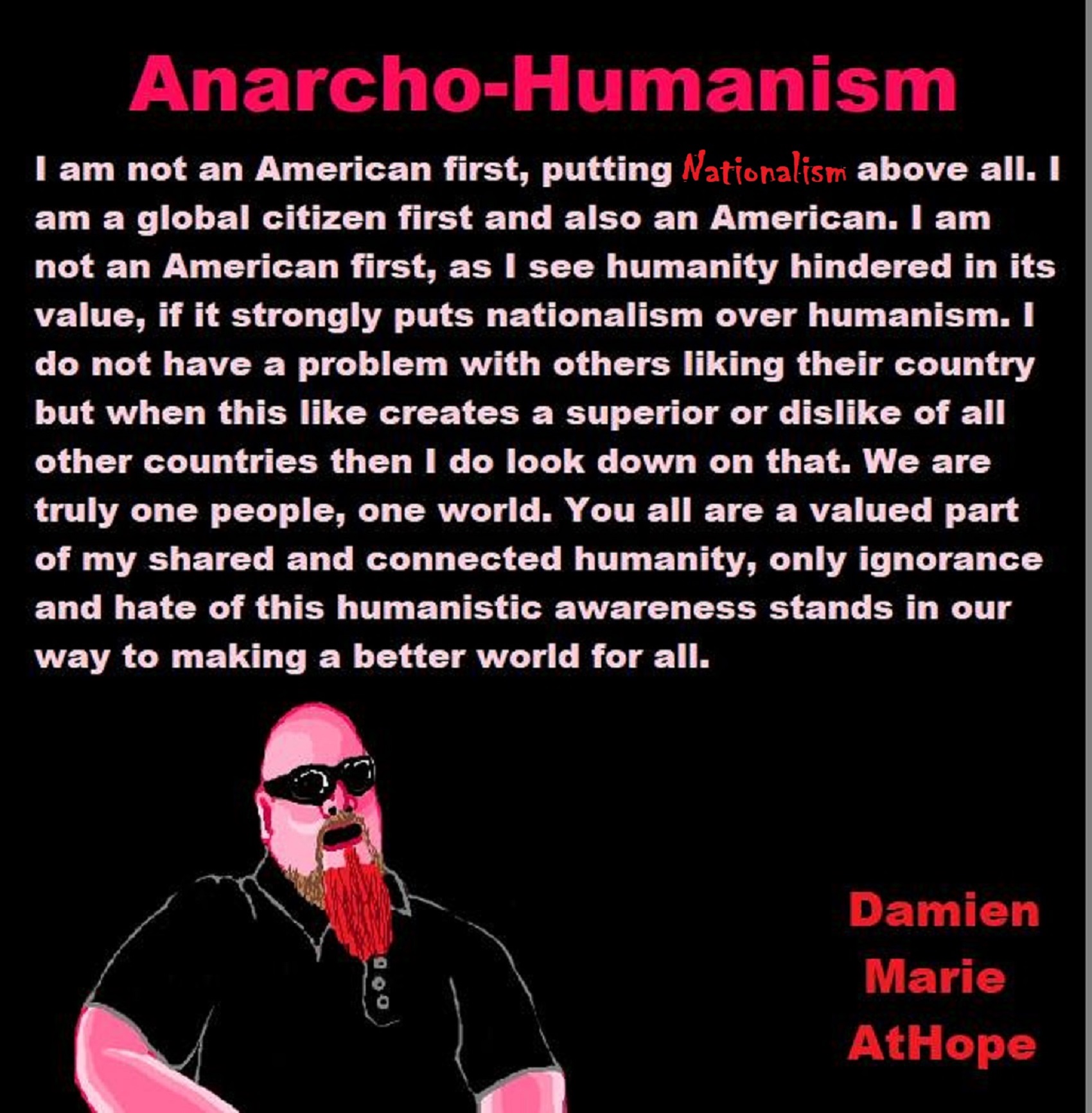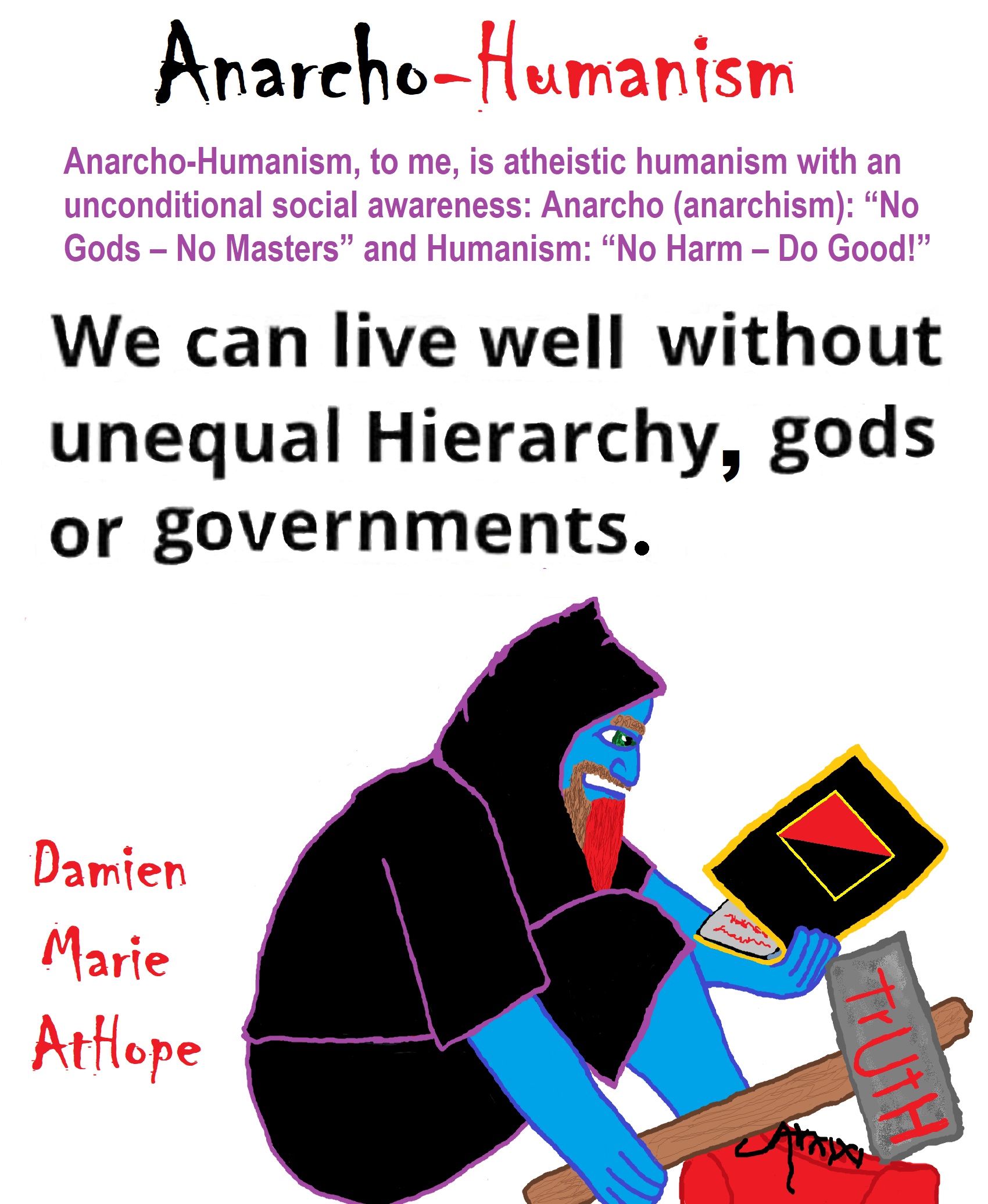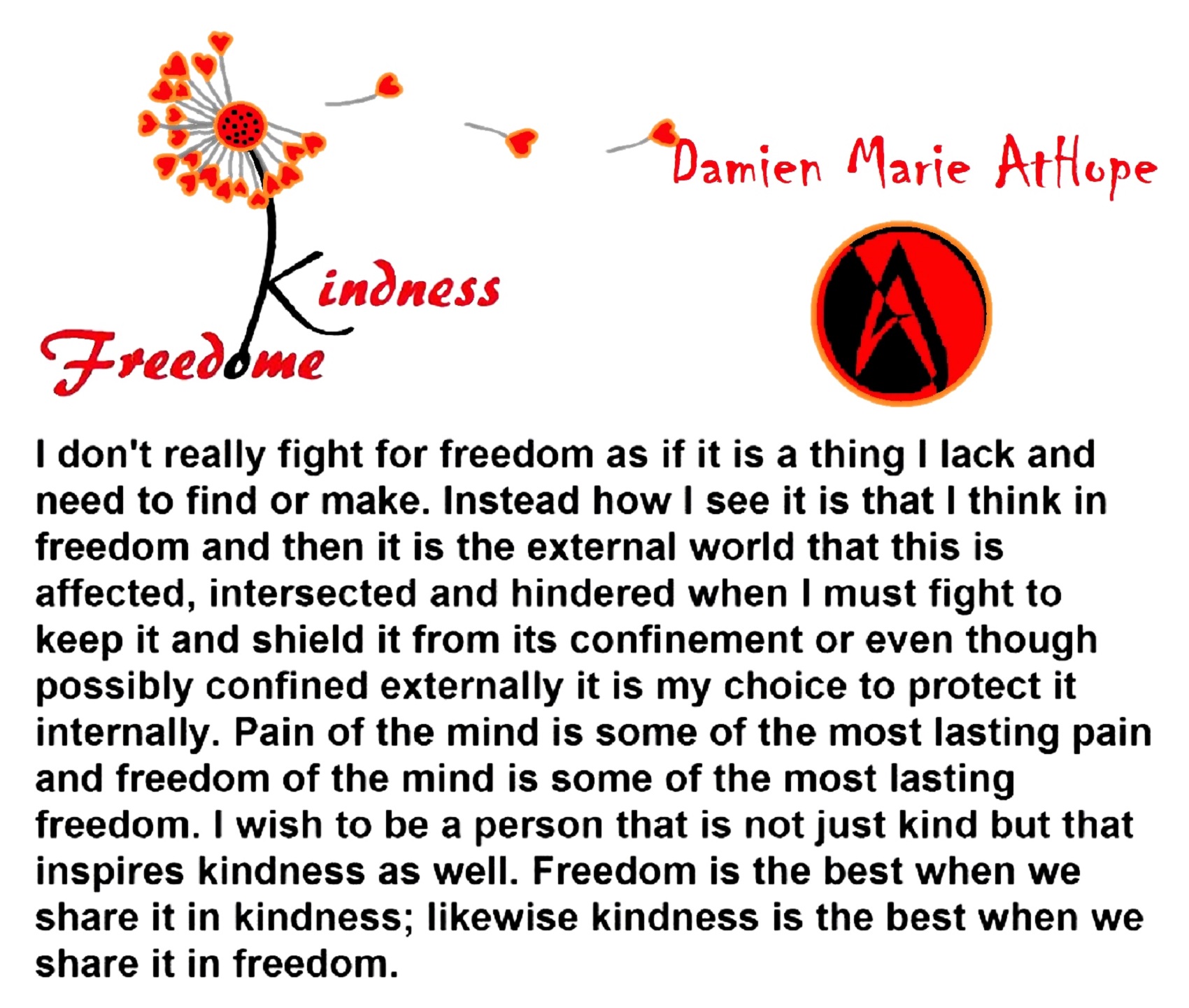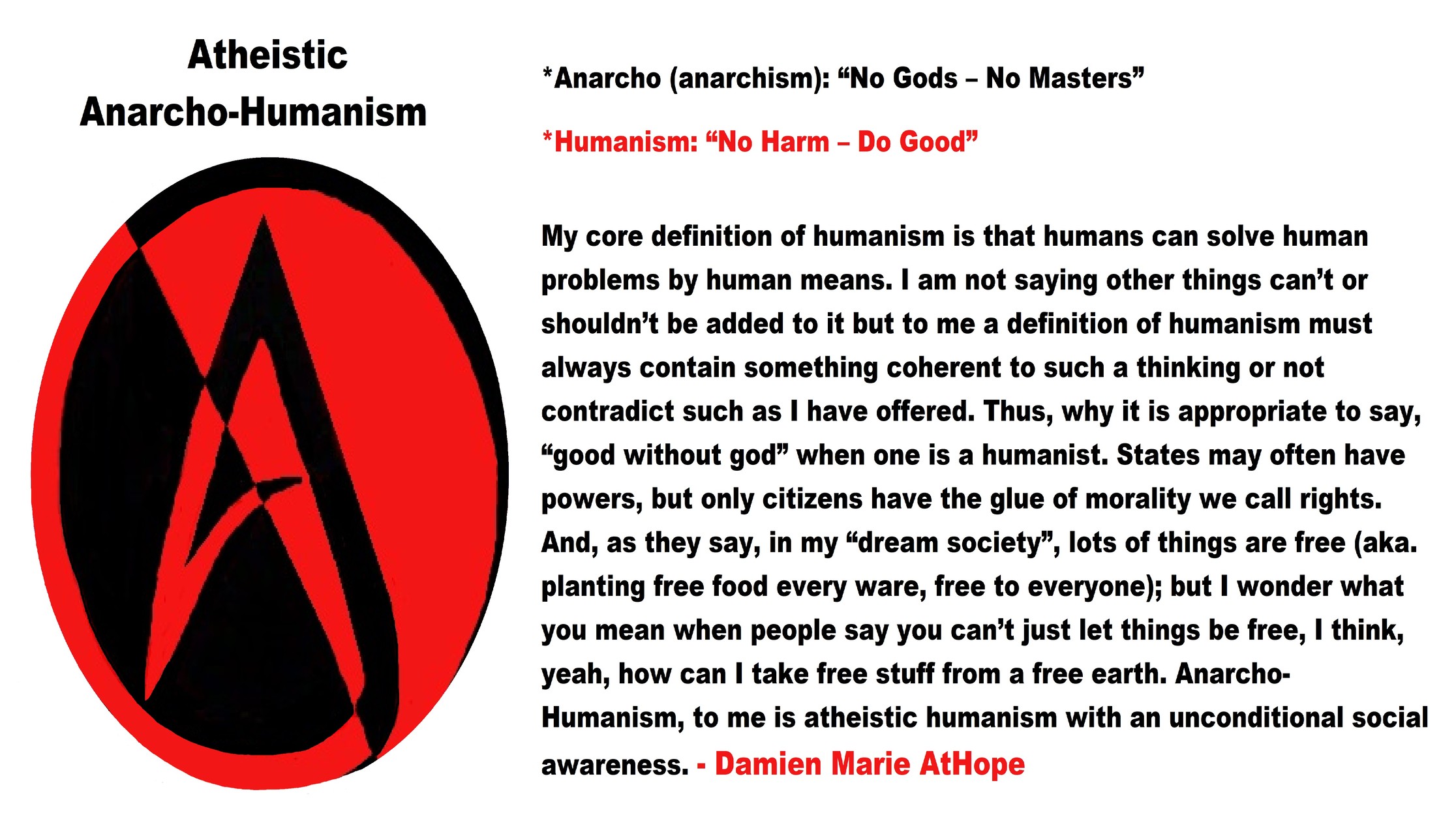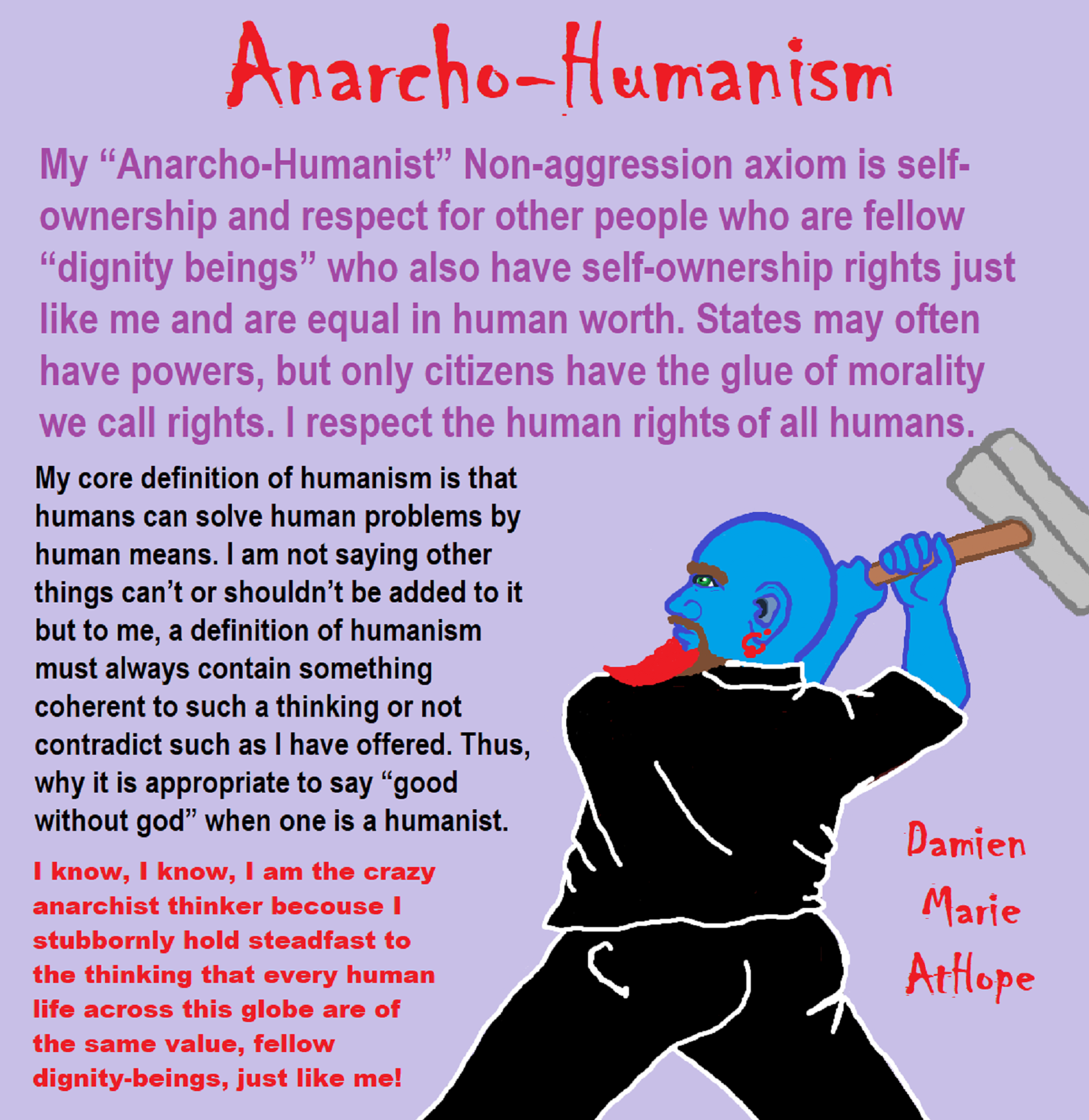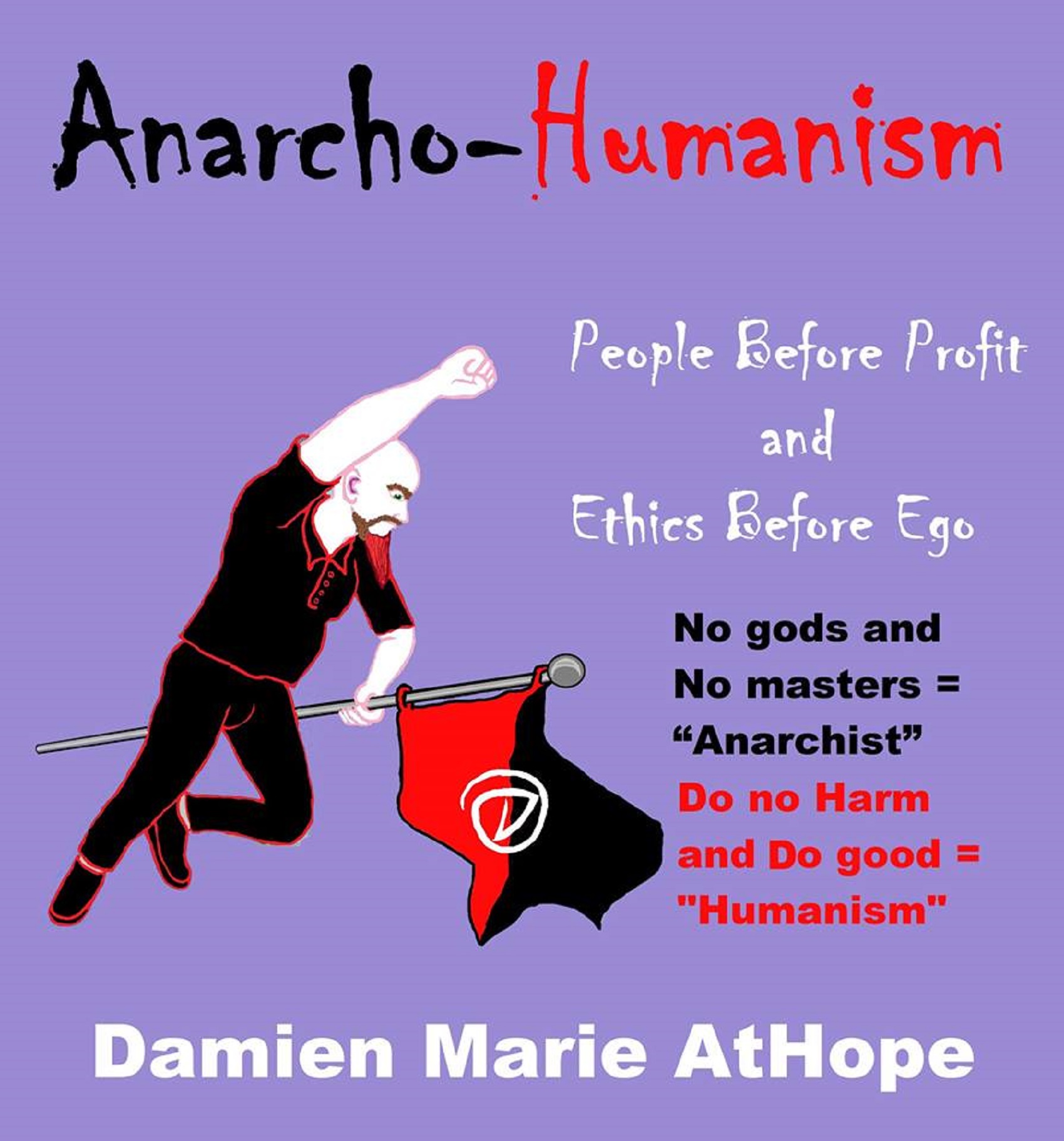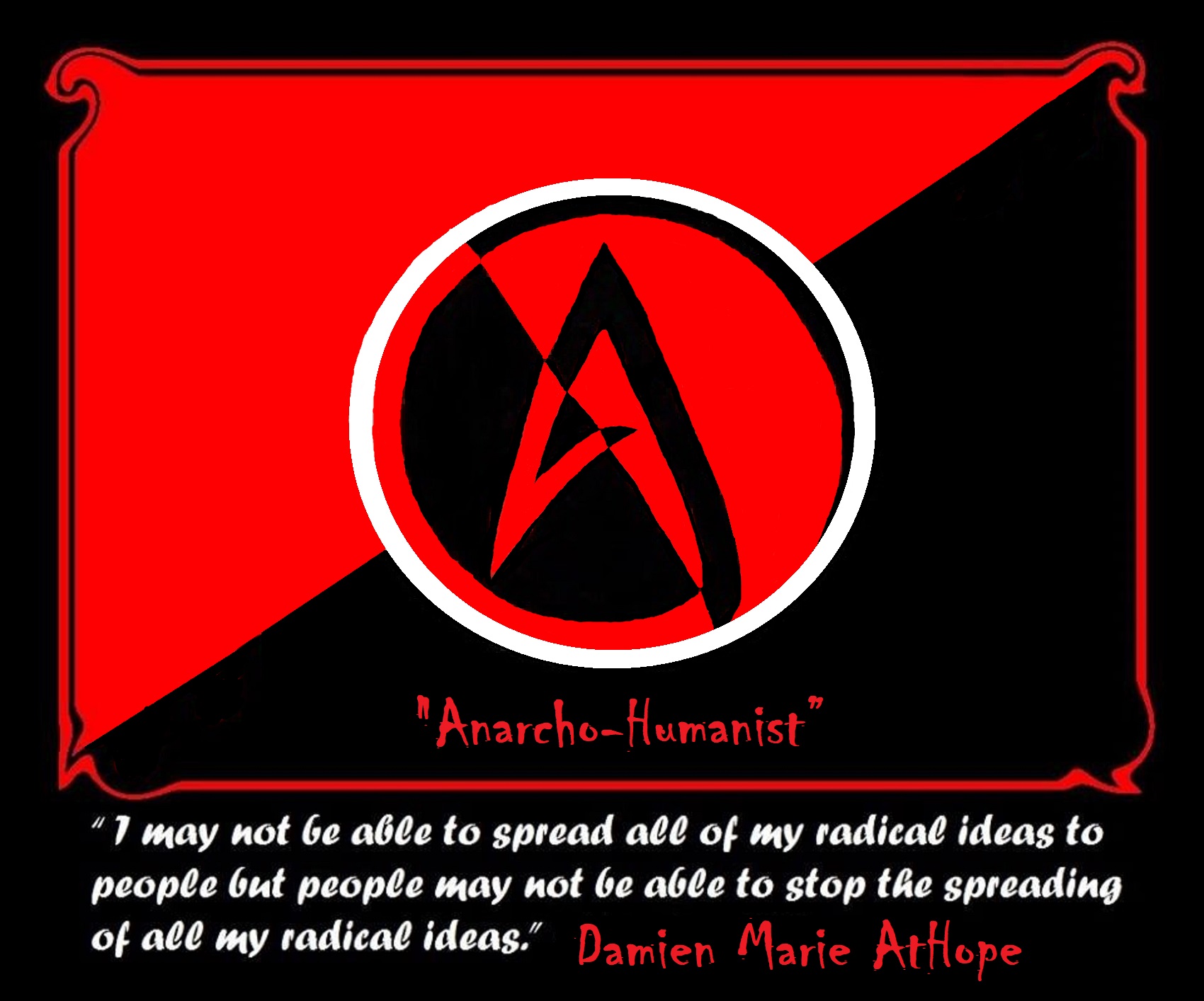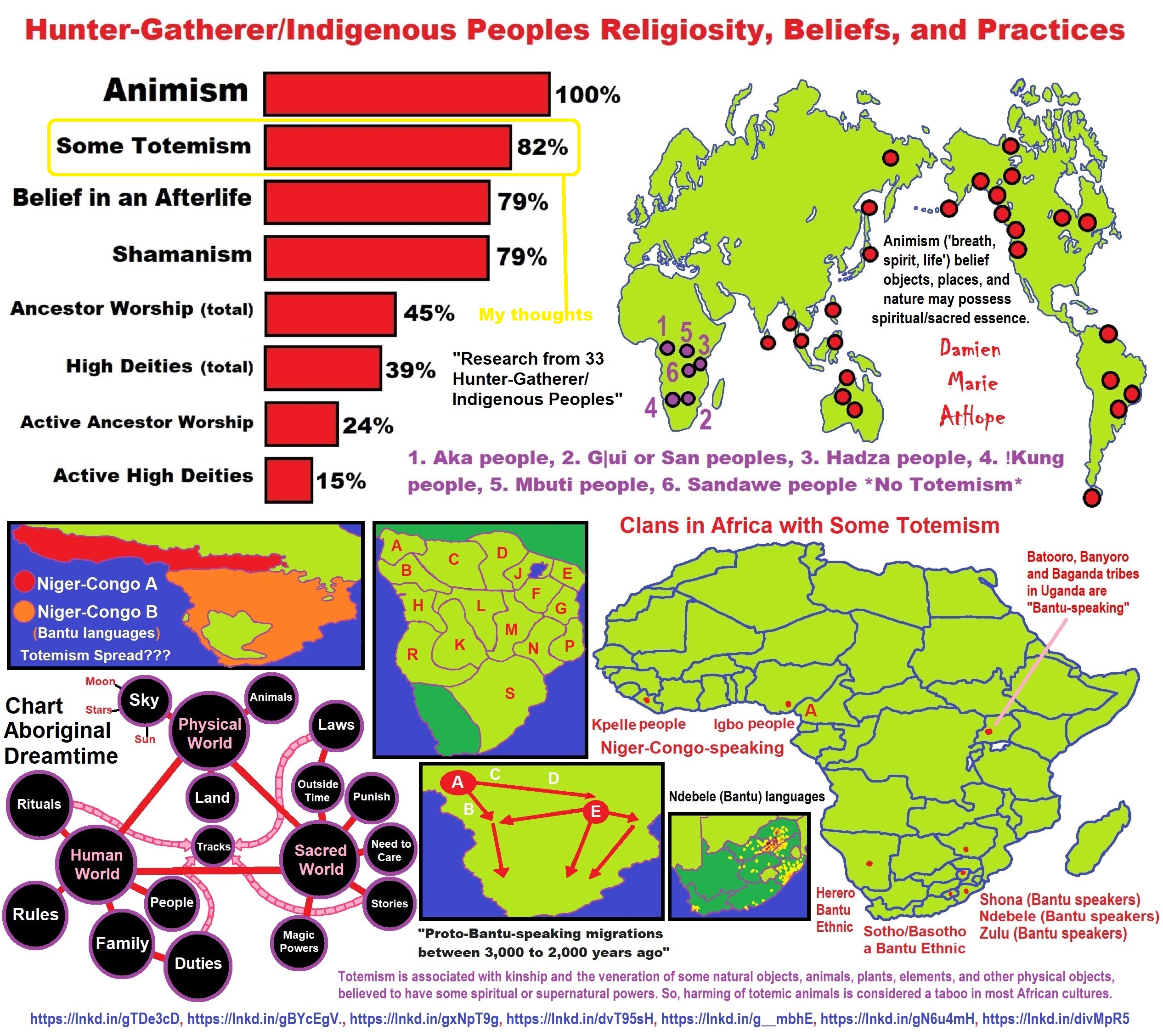“Anarchists may be motivated by humanism, enlightened self-interest, or any number of alternative ethical doctrines. As anarchism is a philosophy that embodies many diverse attitudes, tendencies, and schools of thought, disagreement over questions of values, ideology, and tactics is common. Its diversity has led to widely different uses of identical terms among different anarchist traditions which has created a number of definitional concerns in anarchist theory. Anarchists commonly employ direct action. This can take the form of disrupting and protesting against unjust hierarchy, or the form of self-managing their lives through the creation of counter-institutions such as communes and non-hierarchical collectives. Decision-making is often handled in an anti-authoritarian way, with everyone having equal say in each decision, an approach known as horizontalism.” ref
According to The Stanford Encyclopedia of Philosophy, “Anarchism is a political theory that is skeptical of the justification of authority and power. Anarchism is usually grounded in moral claims about the importance of individual liberty, often conceived as freedom from domination. Anarchists also offer a positive theory of human flourishing, based upon an ideal of equality, community, and non-coercive consensus building. Post-structuralism and trends in post-modernism and Continental philosophy can also be anarchistic and yet also so-called “post-anarchism.” Emerging trends in things like post-humanism make the anarchist critique of “the state” more complicated, since anarchism’s traditional celebration of liberty and autonomy are critically scrutinized and deconstructed (to Damien, this involves anarchist non-humanism thinking). The difference between post-anarchism and traditional anarchism can be seen in the realm of morality. Anarchism has traditionally been critical of centralized moral authority—but this critique was often based upon fundamental principles and traditional values, such as autonomy or liberty. But post-structuralism—calls these values and principles into question.” ref
“Humanism is a philosophical stance that emphasizes the individual and social potential, and agency of human beings, whom it considers the starting point for serious moral and philosophical inquiry. Humanism is strongly linked to rationality. For humanists, humans are reasonable beings, and reasoning and the scientific method are means of finding truth. Traces of humanism can be found in ancient Greek philosophy. Pre-Socratic philosophers were the first Western philosophers to attempt to explain the world in terms of human reason and natural law without relying on myth, tradition, or religion. The word “humanism” derives from the Latin word humanitas, which was first used in ancient Rome by Cicero and other thinkers to describe values related to liberal education. This etymology survives in the modern university concept of the humanities—the arts, philosophy, history, literature, and related disciplines. Humanism is moral; morality is a way for humans to improve their lives. Humanists engage in practical action to improve personal and social conditions. During the Age of Enlightenment, humanistic ideas resurfaced, this time further from religion and classical literature. Science and intellectualism advanced, and humanists argued that rationality could replace deism as the means with which to understand the world. Humanistic values, such as tolerance and opposition to slavery, started to take shape.” ref
“In the early 21st century, the term generally denotes a focus on human well-being and advocates for human freedom, autonomy, and progress. It views humanity as responsible for the promotion and development of individuals, espouses the equal and inherent dignity of all human beings, and emphasizes a concern for humans in relation to the world. Humanists tend to advocate for human rights, free speech, progressive policies, and democracy. Starting in the 20th century, some humanist movements are non-religious and aligned with secularism. Most frequently in contemporary usage, humanism refers to a non-theistic view centered on human agency, and a reliance only on science and reason rather than revelation from a divine source to understand the world. A non-theistic humanist worldview asserts that religion is not a precondition of morality, and objects to excessive religious entanglement with education and the state. The humanist attitude toward morality has changed since its beginning. A naturalistic criticism of humanistic morality is the denial of the existence of morality. For naturalistic skeptics, morality was not hardwired within humans during their evolution; humans are primarily selfish and self-centered. Antihumanism is a philosophical theory that rejects humanism as a pre-scientific ideology.” ref
Damien Marie AtHope’s Anarcho-Humanism
Damien calls himself an anarcho-humanist (basically a socialist-collectivist-mutualist-anarchist as well as rather liberal, progressive, and revolutionary, he wants all positive change, ultimately leading to his desired anarchist-socialist society).
“Hierarchy, to Damien, means oppression and brutality.”
I am an Anarchist Socialist:
*Anarchist, the radical idea you own yourself…
*Socialist, the radical idea of sharing…
*Anarchy is synonymous with Socialism. Because both signify the abolition of exploitation and of the domination of man over man, whether maintained by the force of arms or by the monopolization of the means of life.” – Errico Malatesta (anarchist propagandist and revolutionary socialist)
*Revolution that divests itself of ethical values thereby lays the foundation of injustice, deceit, and oppression for the future society.” – Emma Goldman (anarchist revolutionary)
What Inspires Damien’ Anarcho-Humanism:
- We are all one connected human family.
- No one owns the earth.
- If you can’t trust people with freedom, how can you trust them with power?
To Damien, anarcho-humanism has three core truths to its ethical anarchist persuasion:
- We are all one connected human family,proven by DNA showing we should treat each other as fellow dignity beings, supported equally (no gods and no masters = “Anarcho”).
- No one owns the earth, we may make claims to it even draw lines on maps thinking this makes the fantasy borders, illusion supported by force and the potential for threat. Thus, the ethical truth is we need to share the earth as communally as possible. And use the resources as safely and ethically as possible striving towards sharing and caring. (do no Harm and do good = Humanism)
- If you can’t trust people with freedom how can you trust them with power?Government is only as good as what they provide but I don’t trust ones that have rights over my body. How much more of a violation do you need to show their harm? I am not anti-society, I value good governance just don’t need the extra dead weight of government. There is not one thing a government is valued for that a non-government group with the same financial support and resources could not also do. I get we rise by helping each other and supporting universal betterment and human flourishing. Helping is Helpful: Valuing, Motivating, supporting humanity is limited by nationalism and the, us Vs them, as if you should feel connected to only a few humans just because people invented the mental concept of land ownership, you mean you assert that you will harm others for an amount of the earth’s surface. Seeing with anarcho-humanism eyes helps you see how to Grow in Our Positive Outcomes: Gratitude, Empathy and Kindness. We can become a more quality person by actively being aware and developing a gratitude for life, which supports as well as grows our feelings of empathy, that then motivates the behaviour of kindness. And kindness flourishes in openness and freedom. (No gods no masters as well as do no harm and do good = Anarcho-humanism)
States may often have powers, but only citizens have the glue of morality we call rights. As they say, in Damien’s “dream society”, lots of things are free (aka. planting free food everywhere, free to everyone); but I wonder what you mean when people say you can’t just let things be free, I think, yeah, how can I take free stuff from a free earth. Anarcho-Humanism, to me, is atheistic humanism with an unconditional social awareness. Damien’ core definition of humanism is that humans can solve human problems by human means. Not saying other things can’t or shouldn’t be added to it but to Damien, a definition of humanism must always contain something coherent to such a thinking or not contradict such as Damien has offered. Thus, why it is appropriate to say “good without god” when one is a humanist. We who are “good/ethical” shine bright in our humanity no matter the darkness, whether it be a toxic individual, an oppressive society, or the larger world of harm that may be inflicted on us. Be better than the uncaring around us all.
Alexei Borovoy’s Anarcho-Humanism
“Alexei Borovoy, a Russian anarchist thinker of the early 20th century and author of the anarcho-humanism theory, which presents anarchism as a constant striving towards an individual’s self-liberation through the negation of social reality; and this striving shall be seen as a universal condition for the development of all mankind rather than some social utopia project. Similar to the “anarchist ideal”, his approach offers an unlimited freedom to exercise human abilities, but fails to suggest any reasoned, specific, and consistent principles to serve as a basis of this law, and sticks to general and abstract formulas. Borovoy was a lawyer; accordingly, he believed that the expansion of human rights and freedoms, “a creative liberation of personality” and the removal of any hindrances thereto were extremely important for the development of each individual.” ref
“At the same time, Borovoy did not share the traditional associations of humanism with anthropocentrism, rationalism, and finalism. His anarcho-humanism refocused the legacy of industrial and progressive ideas of unexorcized Marxism on attaining an opposite goal — the maximum liberation of an individual from any social influence. Speaking of the influence of his compatriots, Borovoy traced his anarchist genealogy mainly to Mikhail Bakunin, “the sublime thinker and leader” whom he saw as “an absolute and indisputable lodestar”. In addition to Bakunin’s rebellious esthetics, Borovoy adopted his dialectical structure, his glorification of life, his worship of the human being and the critique of scientism, and the romanticisation of the world of politics. An individual simply cannot exist outside human society. Relations with others are an inevitable product of a stubborn instinct of self-preservation. An individual has more opportunities for self-realization in a broad social circle. Social relations foster meaningful moral ideals. Even human genius develops through relations with other people. Borovoy believes that this “anarchist law” consists of “the responsibility for both individual freedom and the freedom of others”. This suggests that it will be “unable to ensure “unlimited” freedom to everyone. Borovoy stated that anarchism, is not an imaginary dream, but a reality offering an effective and realistic solution to the revolt of the human spirit against violence, does not have to speak of fictions such as “absolute” freedom “unlimited” by anyone and anything, the negation of duty, a total lack of responsibility, and so on.” ref
Alice Neel, painter and anarcho humanist, 1900-1984 – Anticapitalist Resistance
“Disillusioned with the Stalinist regimes because of their poverty, corruption, and repression. Hence, she eventually defined herself as an Anarcho-humanist.” ref
Intellectual Cousins: Humanism and Anarchism
“When initially compared with humanism, anarchism embodies a dramatically different presentation, with substantively different means and commitments, seeking direct political action—at times violent and revolutionary—to achieve a radical emancipation from all forms of illegitimate authority. While class struggle has been imperative to all anarchist movements, the critique of religion was an indispensable part of anarchism’s philosophical ambition to strip away the authority of oppressive institutions. This radical skepticism of institutional and epistemological authorities, as well as a broad commitment to egalitarian human cooperation is what, Jack Pigram believes, has historically united anarchism with humanism.” ref
“Marxist humanism is a philosophical and political movement that interprets Karl Marx‘s works through a humanist lens, focusing on human nature and the social conditions that best support human flourishing. Marxist humanists argue that Marx himself was concerned with investigating similar questions. Contrary to the official dialectical materialism of the Soviet Union and to the structural Marxism of Louis Althusser, Marxist humanists argue that Marx’s work was an extension or transcendence of enlightenment humanism. Where other Marxist philosophies see Marxism as a natural science, Marxist humanism believes that humans are fundamentally distinct from the rest of the natural order, and should be treated so by Marxist theory. Marxist humanism emphasizes human agency, subjectivity and ethics, reaffirming the doctrine of “man is the measure of all things. Jean-Paul Sartre rejected Stalinism’s deterministic and scientistic approach, which they saw as suppressing human creativity and the emancipatory potential of Marxism. Instead, they sought to reinterpret Marxism as a theory rooted in human agency, creativity, and praxis. This independent, humanist Marxism sought to overcome the limitations of both Stalinist orthodoxy and bourgeois liberalism, focusing on the lived experiences of the oppressed.” ref
“Counter-humanism; has two foundational historical proponents, Aimé Césaire and Frantz Fanon, as well as that of Sylvia Wynter. Pre-modern societies that would come to birth humanism did not develop an all-inclusive idea of the human. Counter-humanism, exemplified in Sylvia Wynter’s approach, seeks to ground humanness in an abstract universal; to create a complete, alternate, model of humanness – it is as such a normative approach. The non-humanist approach has three kinds of claims constitutive of a nonnormative approach: It is skeptical that any model can ever be adequate to the complexity of reality, demonstrates that what we understand to be humanness today is simply the result of contingent historical processes which have since the beginning been harmful, and claims that one result of this models-based approach is that there is a tendency to police all that which does not fit within the model. Counter-humanist approaches are pervasive in postcolonial and race theory and, although diverse, they generally share the following characteristics, which will be attributed to specific theorists in later sections. They consider the Enlightenment humanism a “pseudo-humanism,” flawed for privileging (among other categories like gender and class) certain racial groups over others, excluding many from the human even when it purportedly includes all.” ref
“In social theory and philosophy, antihumanism or anti-humanism is a theory that is critical of traditional humanism, traditional ideas about humanity and the human condition. Central to antihumanism is the view that philosophical anthropology and its concepts of “human nature“, “man” or “humanity” should be rejected as historically relative, ideological or metaphysical. In the late 18th and 19th centuries, the philosophy of humanism was a cornerstone of the Enlightenment. Human history was seen as a product of human thought and action, to be understood through the categories of “consciousness“, “agency“, “choice“, “responsibility“, “moral values“. Criticism of humanism as over-idealistic began in the 19th century. For Friedrich Nietzsche, humanism was nothing more than an empty figure of speech – a secular version of theism. Max Stirner expressed a similar position in his book The Ego and Its Own, published several decades before Nietzsche’s work. Nietzsche argues in Genealogy of Morals that human rights exist as a means for the weak to constrain the strong; as such, they do not facilitate the emancipation of life, but instead deny it. The young Karl Marx is sometimes considered a humanist, as he rejected the idea of human rights as a symptom of the very dehumanization they were intended to oppose. Given that capitalism forces individuals to behave in an egoistic manner, they are in constant conflict with one another, and are thus in need of rights to protect themselves. True emancipation, he asserted, could only come through the establishment of communism, which abolishes private property.” ref
“Antihumanism is a philosophical theory that rejects humanism as a pre-scientific ideology. This argument developed during the 19th and 20th centuries in parallel with the advancement of humanism. Prominent thinkers questioned the metaphysics of humanism and the human nature of its concept of freedom. Nietzsche, while departing from a humanistic, pro-Enlightenment viewpoint, criticized humanism for illusions on a number of topics, especially the nature of truth. According to Nietzsche, objective truth is an anthropomorphic illusion and humanism is meaningless, and replacing theism with reason and science simply replaces one religion with another. According to Karl Marx, humanism is a bourgeois project that inaccurately attempts to present itself as radical. After the atrocities of World War II, questions about human nature and the concept of humanity were renewed. During the Cold War, influential Marxist philosopher Louis Althusser introduced the term “theoretical antihumanism” to attack both humanism and humanist-like socialist currents, eschewing more structural and formal interpretations of Marx. According to Althusser, Marx’s early writings resonate with the humanistic idealism of Hegel, Kant, and Feuerbach, but Marx radically moved toward scientific socialism in 1845, rejecting concepts such as the essence of man.” ref
“Central to antihumanism is the view that traditional philosophical anthropology and its concepts of “human nature”, “human condition”, “man”, “humanity”, “vitality”, and “agency”, etc., should be rejected as historically relative, ideological, or metaphysical. What it means by the statement is that while humanists believe in objective truth about human nature, anti-humanism seeks to deconstruct the meaning behind that “nature”. Anti-humanism is not to be confused with Misanthropy, though they can overlap and can be combined. Anti-humanists reject concepts such as humanism’s presuppositions about the nature of human beings, and reject and criticize socially constructed moral cultures.” ref
The Possibility of an Anti-Humanist Anarchism | The Anarchist Library
“A defense of Enlightenment ideals that is historically situated requires the examination of the concepts of humanism and naturalism, in order to demonstrate that the “gay” abandonment of such principles by “postmodern nihilism” is never fully extricable from the tradition that is rebelled against. The following points hope to illuminate the possibility of a “transhuman(t)” anarchism which is ecologically sensitive, tolerant of diversity, yet which sees the role of stewardship as essential for guiding the planet away from imminent collapse. Deleuze, Guattari, and Foucault are taken as representatives of the canon of PS and Bookchin’s thinking is taken as representative of green (anarchist) political philosophy which roots itself in the humanist and naturalist tradition of the Enlightenment. What is humanism? As a philosophical worldview humanism celebrates what it claims to be the highest and most distinct qualities of the human being.” ref
“Several standard interpretations of humanism argue axiologically that human beings possess superior value over other entities. Humans are seen as dignified creatures worthy of the highest consideration. The rational, autonomous self-free from the dictates of unconscious animality is cherished as the site of humanity’s unique potentiality. Bookchin’s insights into the predicament of modernity are illuminating. If Enlightenment is the bursting asunder of humanity’s “self-imposed tutelage” (Kant) then anti-Enlightenment is the return of the cultural dark ages of superstition, mysticism, and the irrational. Bookchin’s search for a re-enchantment of humanity traces the tendencies which desired the cold and manipulating instrumentalism that led to the gas chambers. What Bookchin’s thesis, in effect, boils down to is a defense of ecological subjectivity and the role it plays in the unfolding of self-consciousness. Malthusianism, sociobiology and deep ecology are chastised for their apparent antihumanism.” ref
“The Enlightenment is read by Bookchin largely in terms of a liberation movement away from superstition and domination. Historically, anarchism is derived from the Enlightenment belief in the powers of reason to rationally re-order society (revolution) and its placing of value in humanity as a unique species with unique capacities. Classical humanism is perceived by Bookchin as a largely regressive movement looking backwards historically towards ancient Greek society and their positive values concerning education and civilisation. Enlightenment humanism, on other hand, moved away from the classical viewpoint towards a more prospective position. It is here that anarchism and the Enlightenment share a common thread. Liberation from superstition also meant the prospective reconstruction of society along communistic lines. Thus spoke Bookchin: “Enlightened humanism is a hopeful message that society can be rendered not only rational but wise and not only ethical but passionately visionary.” ref
“Anarcho-Posthumanism is an Ideology that takes Anarcho-Transhumanism further, its main characteristic is the rejection of human narratives and the abolition of Hierarchies through technology. However, it doesn’t want to improve the human condition, but rather go past it and sees nothing special to humans or nature. Moreover, it may argue for using Post-artifism/Biomechanicalism to upgrade nature, creating a combination of the natural and artificial. IRL it manifests either as Cyber-Nihilism or as Soulism.” ref
“Transhumanism is the belief or movement in favor of human enhancement, especially beyond current human limitations and with advanced technology such as artificial intelligence, life extension, and nanotechnology.” ref
“Anarcho-Transhumanism is a philosophy concerned with social and material liberty as understood by both transhumanist views on material conditions and anarchist views on power dynamics in society. Central to anarcho-transhumanism is facilitating the equality of opportunity for all individuals to exercise self-determination. Conditions that unnecessarily limit either the viable options or the individuals able to exercise them are typically rejected, including arrangements based on equality of endowment or outcome. This leads to criticism of other groups in both parent philosophies that fail to address or even encourage such conditions. As many misconceptions about both anarchism and transhumanism persist, it is frequently confused with many other viewpoints and movements, such as technolibertarianism, anarcho-capitalism, liberal transhumanism, social futurism, or the Venus Project. Libertarian socialism and communism are commonly supported systems, possibly made more viable by a transition to post-scarcity.” ref
“Egoist anarchism or anarcho-egoism, often shortened as simply egoism, is a school of anarchist thought that originated in the philosophy of Max Stirner, a 19th-century philosopher whose “name appears with familiar regularity in historically orientated surveys of anarchist thought as one of the earliest and best known exponents of individualist anarchism“. Egoist anarchism places the individual at the forefront, crafting ethical standards and actions based on this premise. It advocates personal liberation and rejects subordination, emphasizing the absolute priority of self-interest. Max Stirner‘s philosophy is usually called “egoism”. He says that the egoist rejects pursuit of devotion to “a great idea, a good cause, a doctrine, a system, a lofty calling”, saying that the egoist has no political calling, but rather “lives themselves out” without regard to “how well or ill humanity may fare thereby”. Stirner held that the only limitation on the rights of the individual is one’s power to obtain what they desire. He proposes that most commonly accepted social institutions—including the notion of State, property as a right, natural rights in general and the very notion of society—were mere phantasms or “spooks” in the mind. Stirner wanted to “abolish not only the state but also society as an institution responsible for its members.” ref
Stirnerism (a type of “egoism”)
“Stirnerism or Stirnerite Egoism is the philosophy of Max Stirner, a German post-Hegelian philosopher, dealing mainly with the Hegelian notion of social alienation and self-consciousness. Stirnerism is often seen as one of the forerunners of Existentialism, Psychoanalytic Theory, and Post-Modernism. Stirnerite Egoism rejects the pursuit of devotion to “a great idea, a good cause, a doctrine, a system, a lofty calling.” According to Stirner, the egoist does not have a political calling but instead lives their life without concern for “how well or ill humanity may fare thereby.” He believed that the only limitation on an individual’s rights is their power to obtain what they desire. Stirner’s notion of self-interest is that individuals possess no objective or higher reason beyond their own reason and self-interest to believe or engage with any concept or idea. Stirner asserts that the individual alone determines the degree of interest in societal constructs such as law, property, and government, allowing for indifference to external claims regarding how one ought to think, act, or be.” ref
“The subject of egoist communism has been a favorite of contemporary egoists, the new readers of Stirner seem to have realized the implications of his findings. These implications, the abolition of the sacredness of all methods that uphold the state, including private property and morality as well as the concept of the state itself; if everyone or at least a majority thought through this psychology, would violate these abstractions to a degree which would most likely lead to the abolition of the state, private property, class, currency, etc. Not only do egoist communists see this as the logical conclusion of egoism on a material basis, but these conditions are in their favor, as they allow for a radical scope of freedom. Our idea has been under fire of course, with most criticisms based on the notion that egoist communism is the replacement of one system by another, that we aim for a goal system. On the contrary, egoist communism is not some sort of ideal for society to achieve, it is a practice. Egoist communism describes a voluntary mutually beneficial relationship between parties or of egoistic interest that utilizes common ownership for that interest and in implication the insurrection against the current state of things. That current state of things being the state and capitalism, as well as its spooky justifications.” ref
“Max Stirner‘s idea of the “union of egoists” (German: Verein von Egoisten) was first expounded in The Ego and Its Own. A union of egoists is understood as a voluntary and non-systematic association which Stirner proposed in contradistinction to the state. Each union is understood as a relation between egoists which is continually renewed by all parties’ support through an act of will. The Union requires that all parties participate out of a conscious egoism. Egoistical relationships have to be flexible enough so that it can be ended up at the will of the participant. The Union of egoists ceases to be one under specific conditions, i.e. “the party ceases to be a union at the same moment at which it makes certain principles binding and wants to have them assured against attacks; but this moment is the very birth-act of the party. As party it is already a born society, a dead union, an idea that has become fixed. As party of absolutism it cannot will that its members should doubt the irrefragable truth of this principle; they could cherish this doubt only if they were egoistic enough to want still to be something outside their party, i.e. non-partisans. Non-partisans they cannot be as party-men, but only as egoists. Whereas individuals in communism are obligated to one another in society, in egoism they are obligated only to themselves. Stirner saw this as the opposite of a state, government or society, which could use the individual for its own gain without benefiting the individual or truly being in his interest. Stirner does not develop in any detail the form of social organization that the Union of egoists might take, with some, such as Carlson, arguing that organization itself is anathema to Stirner’s Union.” ref
“Stirner admits that “complete freedom” is not possible, but he sees that the Union of egoists are the most free form of association that can be had: “Limitation of liberty is inevitable everywhere, for one cannot get rid of everything; one cannot fly like a bird merely because one would like to fly so, for one does not get free from his own weight…The union will assuredly offer a greater measure of liberty, as well as (and especially because by it one escapes all the coercion peculiar to State and society life) admit of being considered as “a new liberty”; but nevertheless it will still contain enough of unfreedom and involuntariness. In Stirner’s Critics, Stirner intended to respond to criticisms made to important arguments put forward in The Ego and Its Own. In it, Stirner tends to refer to himself in the third person. He defines the Union of egoists as follows: “Egoism, as Stirner uses it, is not opposed to love nor to thought; it is no enemy of the sweet life of love, nor of devotion and sacrifice; it is no enemy of intimate warmth, but it is also no enemy of critique, nor of socialism, nor, in short, of any actual interest. It doesn’t exclude any interest. It is directed against only disinterestedness and the uninteresting; not against love, but against sacred love, not against thought, but against sacred thought, not against socialists, but against sacred socialists, etc. The “exclusiveness” of the egoist, which some want to pass off as isolation, separation, loneliness, is on the contrary full participation in the interesting by—exclusion of the uninteresting. The writers of An Anarchist FAQ report that “many in the anarchist movement in Glasgow, Scotland, took Stirner’s “Union of egoists” literally as the basis for their anarcho-syndicalist organizing in the 1940s and beyond. ” ref
“Amorality (also known as amoralism) is an absence of, indifference towards, disregard for, or incapacity for morality. Some simply refer to it as a case of being neither moral nor immoral. Amoral should not be confused with immoral, which refers to an agent doing or thinking something they know or believe to be wrong. Morality and amorality in humans and other animals is a subject of dispute among scientists and philosophers. If morality is intrinsic to humanity, then amoral human beings either do not exist or are only deficiently human, a condition sometimes described as moral idiocy or anti-social behavior disorder. On the other hand, if morality is extrinsic to humanity, then amoral human beings can both exist and be fully human, and as such be amoral by default. Human capabilities may be thought of as amoral in that they can be used for either constructive or destructive purposes, i.e., for good or for ill.” ref
“Within the wide range of moral traditions, religious value-systems co-exist with contemporary secular frameworks such as consequentialism, freethought, humanism, utilitarianism, and others. Several studies have been conducted on the empirics of morality in various countries, and the overall relationship between faith and crime is unclear. A 2001 review of studies on this topic found “The existing evidence surrounding the effect of religion on crime is varied, contested, and inconclusive, and currently, no persuasive answer exists as to the empirical relationship between religion and crime.” Phil Zuckerman’s 2008 book, Society without God, based on studies conducted during 14 months in Scandinavia in 2005–2006, notes that Denmark and Sweden, “which are probably the least religious countries in the world, and possibly in the history of the world”, enjoy “among the lowest violent crime rates in the world [and] the lowest levels of corruption in the world.” Dozens of studies have been conducted on this topic since the twentieth century.” ref
“Moral intuitions may have genetic bases. A 2022 study conducted by scholars Michael Zakharin and Timothy C. Bates, and published by the European Journal of Personality, found that moral foundations have significant genetic bases. Another study, conducted by Smith and Hatemi, similarly found significant evidence in support of moral heritability by looking at and comparing the answers of moral dilemmas between twins. Genetics play a role in influencing prosocial behaviors and moral decision-making. Genetics contribute to the development and expression of certain traits and behaviors, including those related to morality. However, it is important to note that while genetics play a role in shaping certain aspects of moral behavior, morality itself is a multifaceted concept that encompasses cultural, societal, and personal influences as well.” ref
“The brain areas that are consistently involved when humans reason about moral issues have been investigated by multiple quantitative large-scale meta-analyses of the brain activity changes reported in the moral neuroscience literature. The neural network underlying moral decisions overlaps with the network pertaining to representing others’ intentions (i.e., theory of mind) and the network pertaining to representing others’ (vicariously experienced) emotional states (i.e., empathy). This supports the notion that moral reasoning is related to both seeing things from other persons’ points of view and to grasping others’ feelings. These results provide evidence that the neural network underlying moral decisions is probably domain-global (i.e., there might be no such things as a “moral module” in the human brain) and might be dissociable into cognitive and affective sub-systems. Moral cognition refers to cognitive processes implicated in moral judgment and decision making, and moral action. It consists of several domain-general cognitive processes, ranging from perception of a morally salient stimulus to reasoning when faced with a moral dilemma. While it is important to mention that there is not a single cognitive faculty dedicated exclusively to moral cognition, characterizing the contributions of domain-general processes to moral behavior is a critical scientific endeavor to understand how morality works and how it can be improved.” ref
“A 2005 study by Gregory S. Paul published in the Journal of Religion and Society stated that, “In general, higher rates of belief in and worship of a creator correlate with higher rates of homicide, juvenile and early adult mortality, STD infection rates, teen pregnancy, and abortion in the prosperous democracies,” and “In all secular developing democracies a centuries long-term trend has seen homicide rates drop to historical lows” with the exceptions being the United States (with a high religiosity level) and “theistic” Portugal. In a response, Gary Jensen builds on and refines Paul’s study. he concludes that a “complex relationship” exists between religiosity and homicide “with some dimensions of religiosity encouraging homicide and other dimensions discouraging it”. In April 2012, the results of a study which tested their subjects’ pro-social sentiments were published in the Social Psychological and Personality Science journal in which non-religious people had higher scores showing that they were more motivated by their own compassion to perform pro-social behaviors. Religious people were found to be less motivated by compassion to be charitable than by an inner sense of moral obligation.” ref
“Enlightened self-interest is a philosophy in ethics which states that persons who act to further the interests of others (or the interests of the group or groups to which they belong) ultimately serve their own self-interest. It has often been simply expressed by the belief that an individual, group, or even a commercial entity will “do well by doing good”. The term enlightened self-interest has been criticized as a mere ideological or semantic device of neoclassical economic theory to justify this type of behavior. It has been considered at best a variant of self-interest that is unsuitable for the establishment of personal and public relations because – like the definition of self-interest in the standard rational-choice model – it fails to characterize human behavior ethically, psychologically, and cognitively. In contrast to enlightened self-interest is simple greed, or the concept of “unenlightened self-interest”, in which it is argued that when most or all persons act according to their own myopic selfishness, the group suffers loss as a result of conflict, decreased efficiency and productivity because of lack of cooperation, and the increased expense each individual pays for the protection of their own interests. If a typical individual in such a group is selected at random, it is not likely that this person will profit from such a group ethic. Enlightened self-interest is also different from altruism, which calls for people to act in the interest of others often at the expense of their own interests and with no expectation of material benefit for themselves in the future. Some advocates of enlightened self-interest might argue that pure altruism promotes inefficiency as well.” ref
“In ethical philosophy, ethical egoism is the normative position that moral agents ought to act in their own self-interest. It differs from psychological egoism, which claims that people can only act in their self-interest. Ethical egoism also differs from rational egoism, which holds that it is rational to act in one’s self-interest. Ethical egoism holds, therefore, that actions whose consequences will benefit the doer are ethical. Ethical egoism contrasts with ethical altruism, which holds that moral agents have an obligation to help others. Egoism and altruism both contrast with ethical utilitarianism, which holds that a moral agent should treat one’s self (also known as the subject) with no higher regard than one has for others (as egoism does, by elevating self-interests and “the self” to a status not granted to others). But it also holds that one is not obligated to sacrifice one’s own interests (as altruism does) to help others’ interests, so long as one’s own interests (i.e., one’s own desires or well-being) are substantially equivalent to the others’ interests and well-being, but they have the choice to do so. Egoism, utilitarianism, and altruism are all forms of consequentialism, but egoism and altruism contrast with utilitarianism, in that egoism and altruism are both agent-focused forms of consequentialism (i.e., subject-focused or subjective). Ethical egoism is often used as the philosophical basis for support of right-libertarianism and individualist anarchism.” ref
“Rational egoism (also called rational selfishness) is the principle that an action is rational if and only if it maximizes one’s self-interest. As such, it is considered a normative form of egoism, though historically has been associated with both positive and normative forms. In its strong form, rational egoism holds that to not pursue one’s own interest is unequivocally irrational. Its weaker form, however, holds that while it is rational to pursue self-interest, failing to pursue self-interest is not always irrational. Originally an element of nihilist philosophy in Russia, it was later popularised in English-speaking countries by Russian-American author Ayn Rand. Rational egoism emerged as the dominant social philosophy of the Russian nihilist movement, having developed in the works of nihilist philosophers Nikolay Chernyshevsky and Dmitry Pisarev.” ref
“The Russian nihilist movement was a philosophical, cultural, and revolutionary movement in the Russian Empire during the late 19th and early 20th centuries, from which the broader philosophy of nihilism originated. In Russian, the word nigilizm (‘nihilism’, from Latin nihil ‘nothing’) came to represent the movement’s unremitting attacks on morality, religion, and traditional society. Russian anarchist Peter Kropotkin, as stated in the Encyclopædia Britannica, “defined nihilism as the symbol of struggle against all forms of tyranny, hypocrisy, and artificiality and for individual freedom.” As only an early form of nihilist philosophy, Russian nihilism saw all the morality, philosophy, religion, aesthetics, and social institutions which were in place as worthless and meaningless but did not necessarily see meaninglessness in all ethics, knowledge, and human life. It did however, incorporate theories of hard determinism, atheism, materialism, positivism, and egoism in an aim to assimilate and distinctively recontextualize core elements of the Age of Enlightenment into Russia while dropping the Westernizer approach of the previous generation. Although most commonly associated with revolutionary activism, most nihilists were in fact not political and instead discarded politics as an outdated stage of humanity. They held that until a destructive program had overcome the current conditions no constructive program could be properly formulated, and although some nihilists did begin to develop communal principles their formulations in this regard remained vague.” ref
“In philosophy, nihilism is any viewpoint, or a family of views, that rejects generally accepted or fundamental aspects of human existence, namely knowledge, morality, or meaning. There have been different nihilist positions, including that human values are baseless, that life is meaningless, that knowledge is impossible, or that some other highly regarded concepts are in fact meaningless or pointless. Contemporary understanding of the idea stems largely from the Nietzschean ‘crisis of nihilism’, from which derive the two central concepts: the destruction of higher values and the opposition to the affirmation of life. In popular use, the term commonly refers to forms of existential nihilism, according to which life is without intrinsic value, meaning, or purpose. Other prominent positions within nihilism include the rejection of all normative and ethical views (§ Moral nihilism), the rejection of all social and political institutions (§ Political nihilism), the stance that no knowledge can or does exist (§ Epistemological nihilism), and a number of metaphysical positions, which assert that non-abstract objects do not exist (§ Metaphysical nihilism), that composite objects do not exist (§ Mereological nihilism), or even that life itself does not exist. Nietzsche characterized nihilism as emptying the world and especially human existence of meaning, purpose, comprehensible truth, or essential value. One such reaction to the loss of meaning is what Nietzsche calls passive nihilism, which he recognizes in the pessimistic philosophy of Schopenhauer. Schopenhauer’s doctrine, which Nietzsche also refers to as Western Buddhism, advocates separating oneself from will and desires in order to reduce suffering. Nietzsche characterizes this attitude as a “will to nothingness“, whereby life turns away from itself, as there is nothing of value to be found in the world. This mowing away of all value in the world is characteristic of the nihilist, although in this, the nihilist appears inconsistent: this “will to nothingness” is still a form of valuation or willing.” ref
“The anarcho-nihilist position is essentially that we are done for it. That the current manifestation of human society (civilization, leviathan, industrial society, global capitalism, whatever) is beyond salvation, and so our response to it should be one of unmitigated hostility. There are no demands to be made, no utopic visions to be upheld, no political programs to be followed – the path of resistance is one of pure negation. In short, “that conditions in the social organization are so bad as to make destruction desirable for its own sake independent of any constructive program or possibility.” Anarcho-Nihilism is a faction founded off the values of the Nihilist Movement. It involves rejection of all government, authority, and morality. The Nihilist movement was a Russian movement in the 1860s which rejected all authorities. It is derived from the Latin nihil, meaning “nothing”. After the assassination of Tsar Alexander II in 1881, the Nihilists were known throughout Europe as proponents of the use of violence in order to bring about political change.” ref
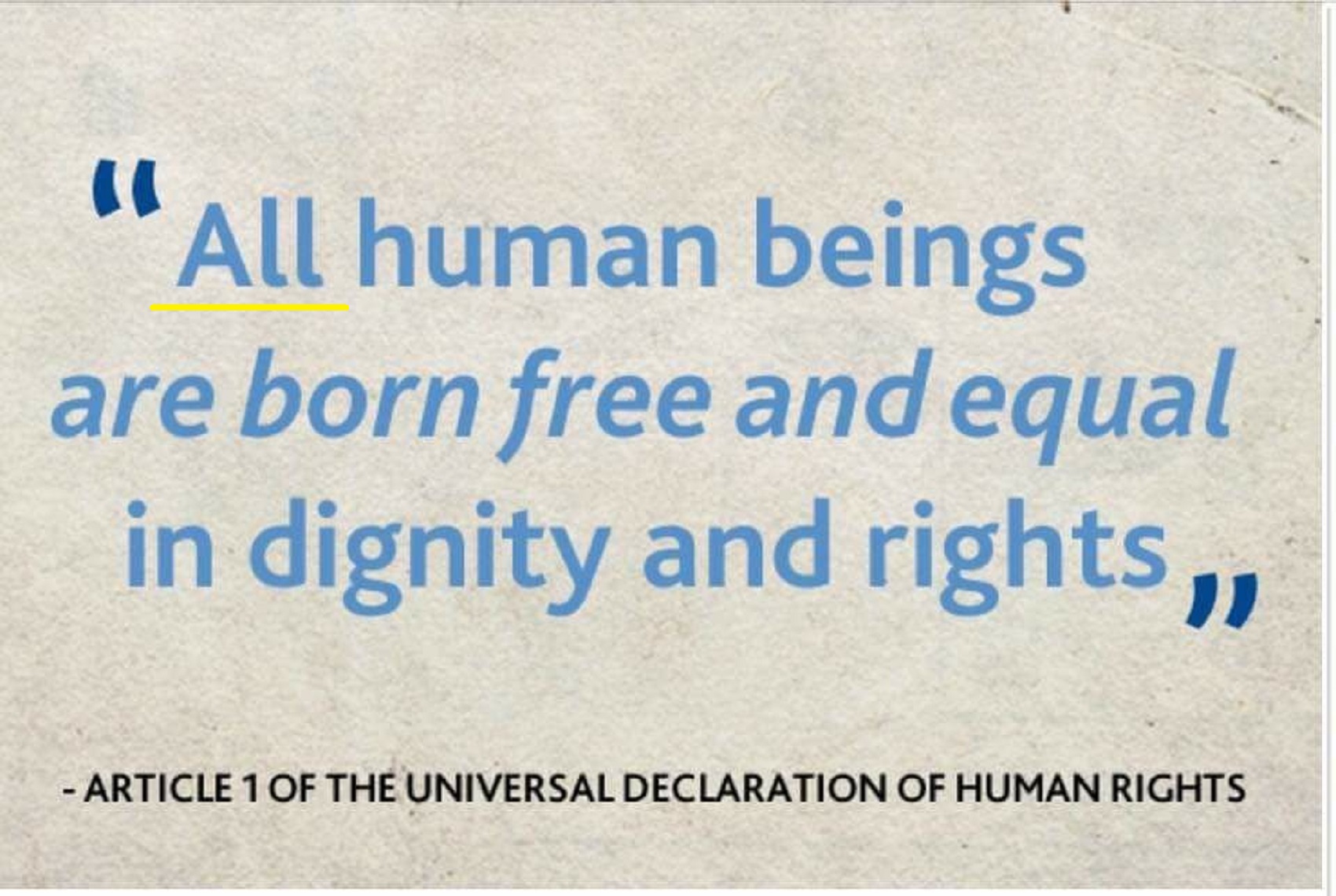
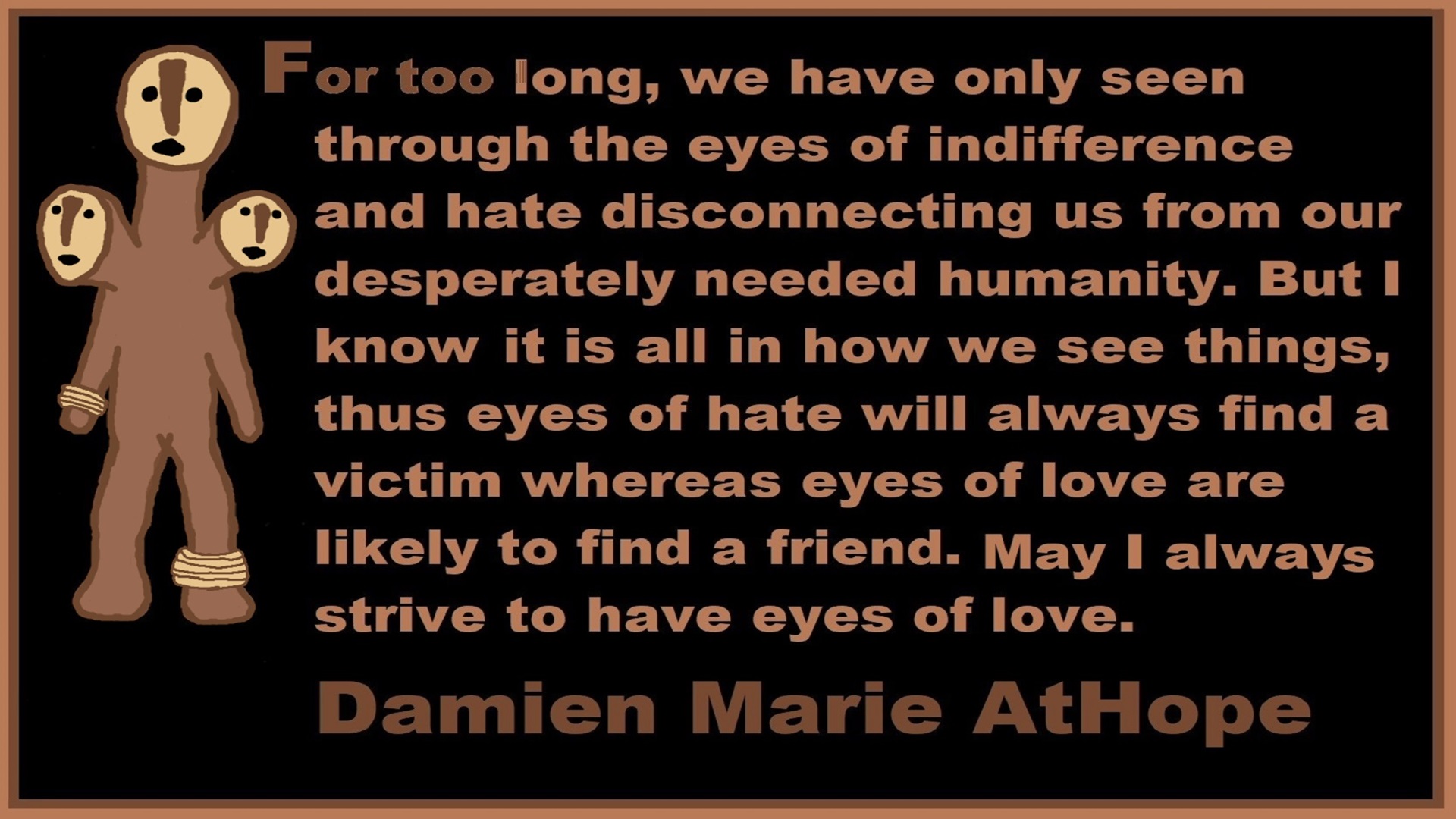
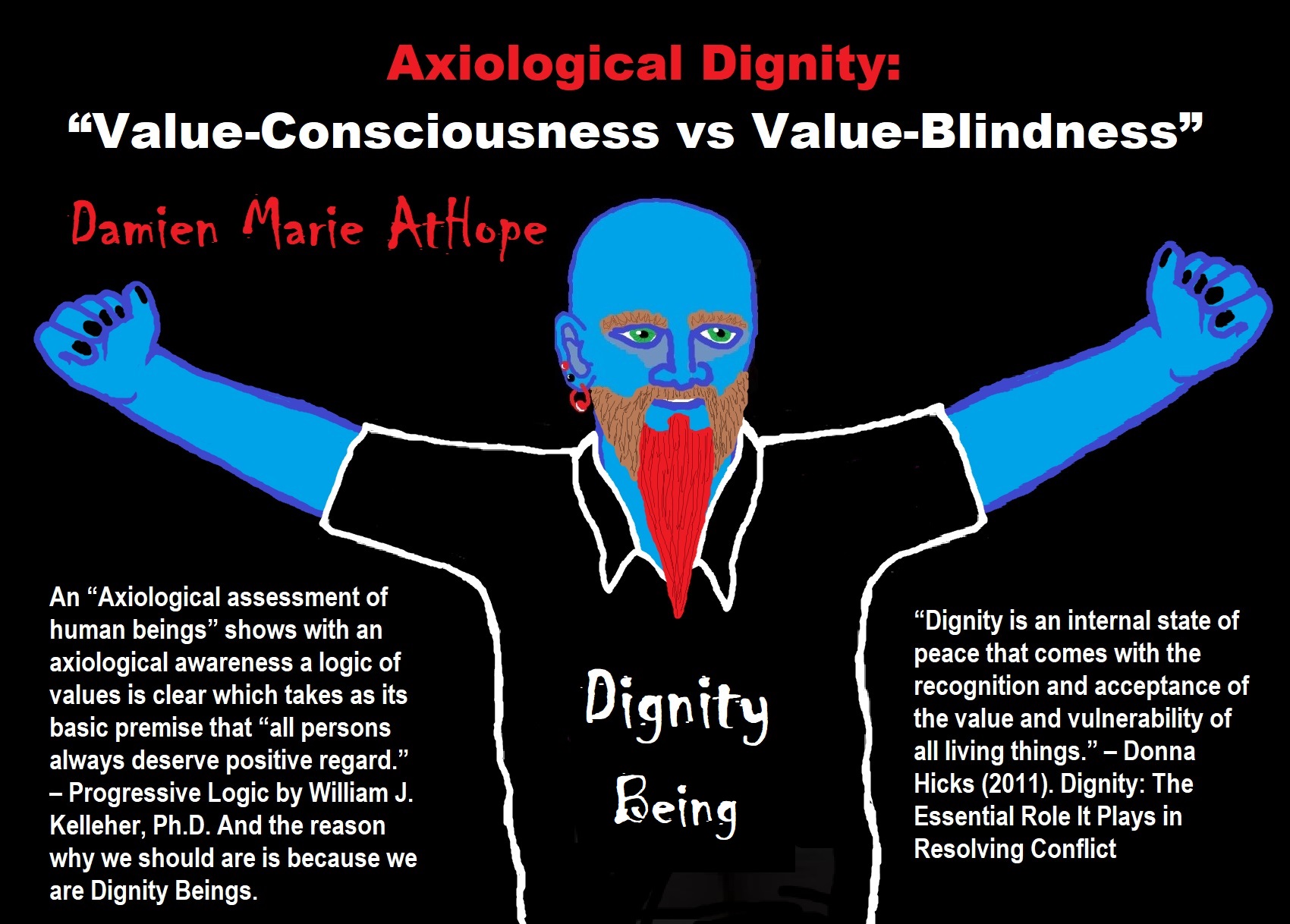
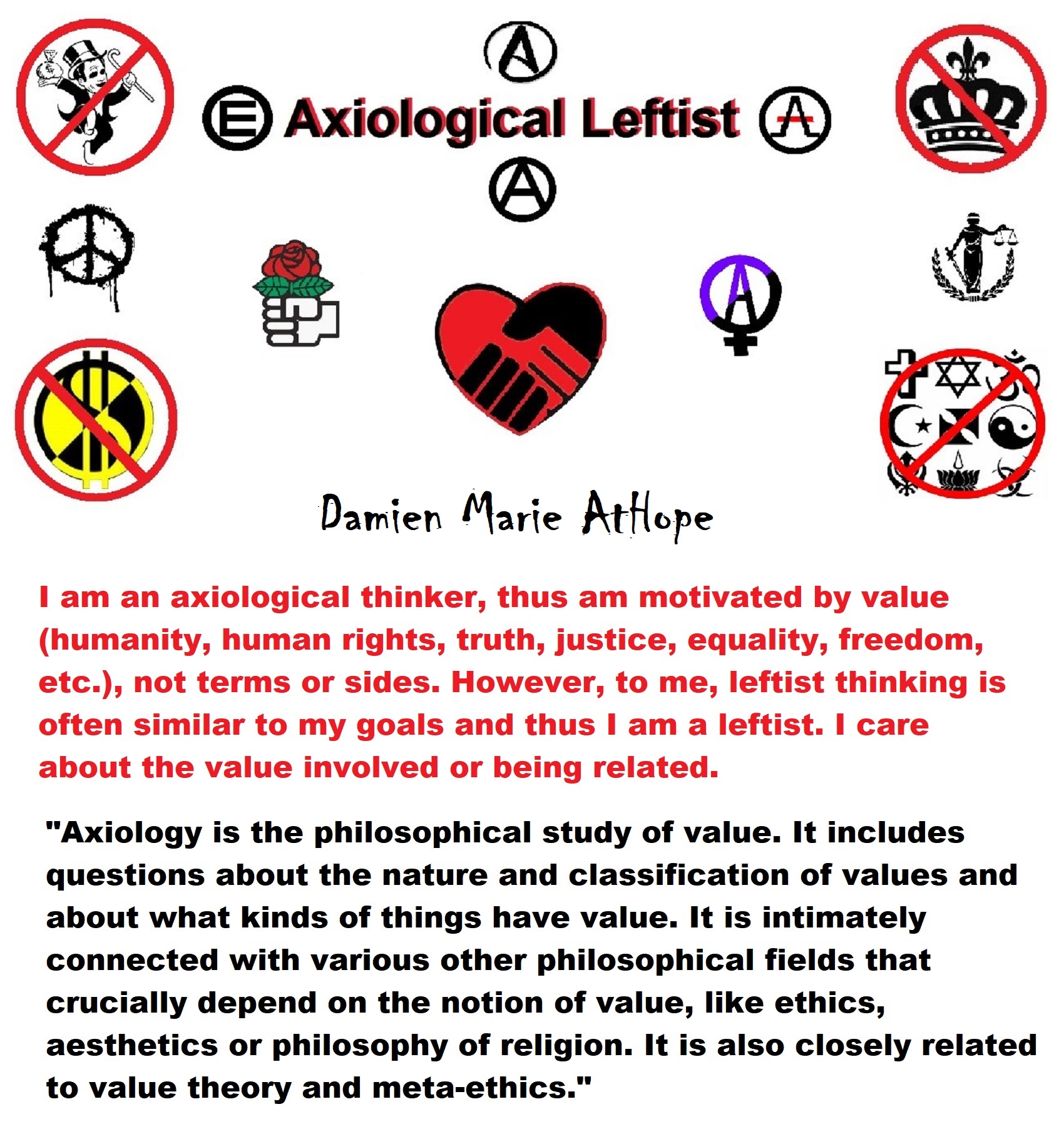
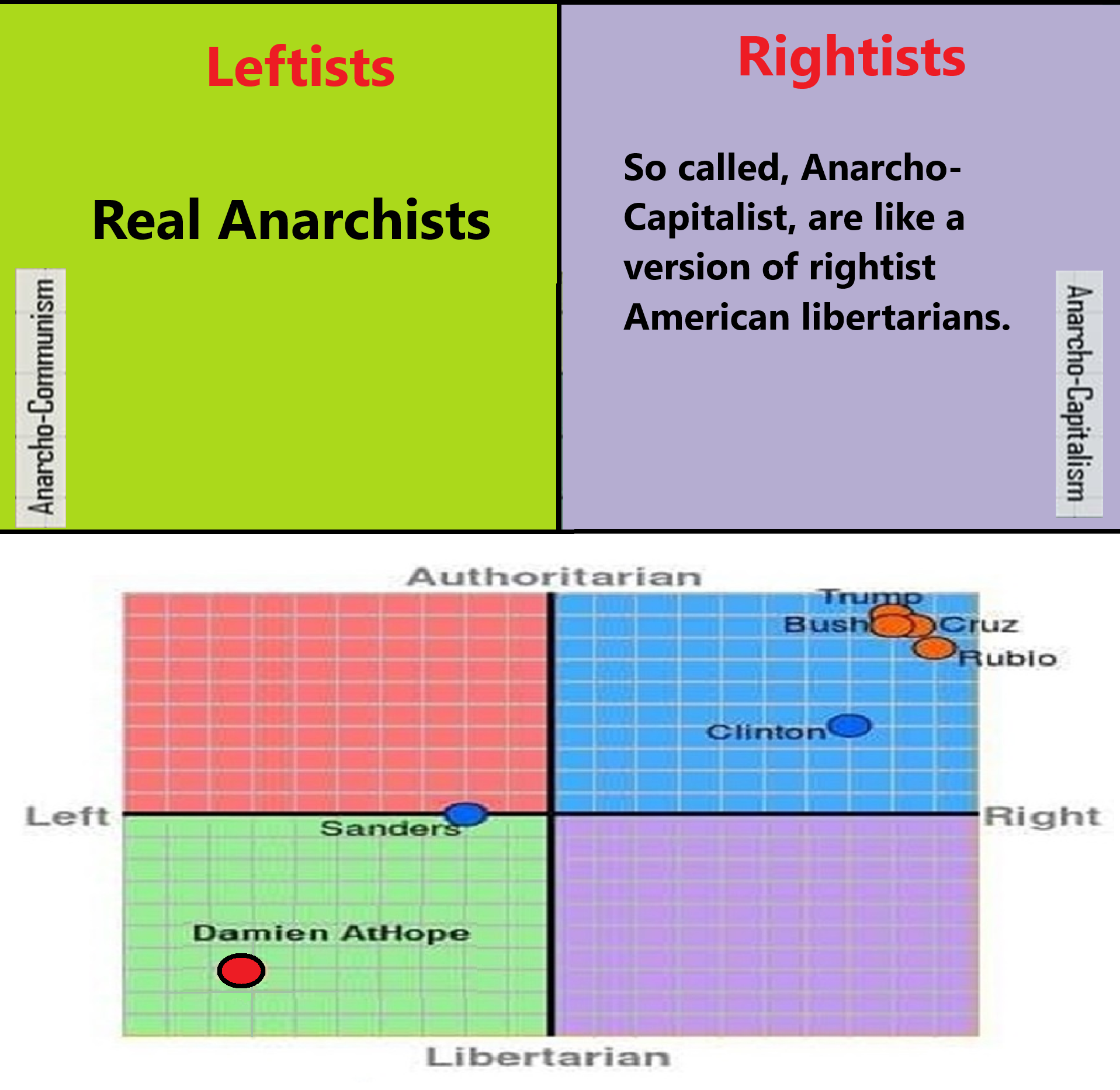
“Left-libertarianism, also known as left-wing libertarianism, is a political philosophy and type of libertarianism that stresses both individual freedom and social euality. Left-libertarianism represents several related yet distinct approaches to political and social theory. Its classical usage refers to anti-authoritarian varieties of left-wing politics such as anarchism, especially social anarchism. While right-libertarianism is widely seen as synonymous with libertarianism in the United States, left-libertarianism is the predominant form of libertarianism in Europe. In the United States, left-libertarianism is the term used for the left wing of the American libertarian movement, including the political positions associated with academic philosophers Hillel Steiner, Philippe Van Parijs, and Peter Vallentyne that combine self-ownership with an egalitarian approach to natural resources. Although libertarianism in the United States has become associated with classical liberalism and minarchism, with right-libertarianism being more known than left-libertarianism, political usage of the term libertarianism until then was associated exclusively with anti-capitalism, libertarian socialism, and social anarchism; in most parts of the world, such an association still predominates. While all libertarians begin with a conception of personal autonomy from which they argue in favor of civil liberties and a reduction or elimination of the state, left-libertarianism encompasses those libertarian beliefs that claim the Earth’s natural resources belong to everyone in an egalitarian manner, either unowned or owned collectively. Like other forms of libertarianism, left-libertarian views on the state range from minarchism, which argues for a decentralised and limited government, to anarchism, which advocates for the state to be abolished entirely.” ref
“In its oldest form, “left-libertarianism” was used synonymously with social anarchism. Social anarchism, also known as left-wing anarchism or socialist anarchism, is an anarchist tradition that sees individual liberty and social solidarity as mutually compatible and desirable. It advocates for a social revolution to eliminate hierarchical power structures, such as capitalism and the state. In their place, social anarchists encourage social collaboration through mutual aid and envision non-hierarchical forms of social organization, such as voluntary associations. Identified with the socialist tradition of Pierre-Joseph Proudhon, Mikhail Bakunin, and Peter Kropotkin, social anarchism is often contrasted with individualist anarchism. Although social anarchism and other forms of left-libertarianism share similar roots and concerns, social anarchism has distinguished itself as a distinct ideological tradition, due to its fundamental rejection of the state. In contrast to individualist tendencies, social anarchism rejects private property and market relations, which they believe will be eliminated with the abolition of the state. Social anarchism, originally associated with the libertarianism of Joseph Déjacque, has historically encompassed collectivist anarchism, anarchist communism, and anarcho-syndicalism; each of which became influential tendencies in the Russian and Spanish Revolutions. The contemporary left-libertarian Murray Bookchin advocated for the replacement of the state with a libertarian communist society, which he saw as a decentralized confederation of municipalities, in which decisions would be made by direct democracy. Bookchin was also harshly critical of individualist anarchism, which he held responsible for the failure of left-libertarianism to take a prominent place in public discourse.” ref, ref
“Right-libertarianism, also known as libertarian capitalism, or right-wing libertarianism, is a libertarian political philosophy that supports capitalist property rights and defends market distribution of natural resources and private property. The term right-libertarianism is used to distinguish this class of views on the nature of property and capital from left-libertarianism, a variant of libertarianism that combines self-ownership with an egalitarian approach to property and income. In contrast to socialist libertarianism, right-libertarianism supports free-market capitalism. Like most forms of libertarianism, it supports civil liberties, especially natural law, negative rights, the non-aggression principle, and a significant transformation of the modern welfare state. Right-libertarian political thought is characterized by the strict priority given to liberty, with the need to maximize the realm of individual freedom and minimize the scope of public authority. Right-libertarians typically see the state as the principal threat to liberty. This anti-statism differs from anarchist doctrines in that it is based upon strong individualism that places less emphasis on human sociability or cooperation. Right-libertarian philosophy is also rooted in the ideas of individual rights and laissez-faire economics. The right-libertarian theory of individual rights generally follows the homestead principle and the labor theory of property, stressing self-ownership and that people have an absolute right to the property that their labor produces.” ref
“Economically, right-libertarians make no distinction between capitalism and free markets and view any attempt to dictate the market process as counterproductive, emphasizing the mechanisms and self-regulating nature of the market whilst portraying government intervention and attempts to redistribute wealth as invariably unnecessary and counter-productive. Although all right-libertarians oppose government intervention, there is a division between anarcho-capitalists, who view the state as an unnecessary evil and want property rights protected without statutory law through market-generated tort, contract, and property law; and minarchists, who support the need for a minimal state, often referred to as a night-watchman state, to provide its citizens with courts, military, and police. Like libertarians of all varieties, right-libertarians refer to themselves simply as libertarians. Being the most common type of libertarianism in the United States, right-libertarianism has become the most common referent of libertarianism there since the late 20th century, while historically and elsewhere, it continues to be widely used to refer to anti-state forms of socialism such as anarchism and more generally libertarian communism/libertarian Marxism and libertarian socialism. Around the time of Murray Rothbard, who popularized the term libertarian in the United States during the 1960s, anarcho-capitalist movements started calling themselves libertarian, leading to the rise of the term right-libertarian to distinguish them. Rothbard himself acknowledged the co-opting of the term and boasted of its “capture […] from the enemy”. Anarcho-capitalism (colloquially: ancap or an-cap) is a political philosophy and economic theory that seeks to abolish centralized states in favor of stateless societies with systems of private property enforced by private agencies. According to its proponents, various historical theorists have espoused philosophies similar to anarcho-capitalism. While the earliest extant attestation of “anarchocapitalism” [sic] is in Karl Hess‘s essay “The Death of Politics” published by Playboy in March 1969, American economist Murray Rothbard was credited with coining the terms anarcho-capitalist and anarcho-capitalism in 1971.” ref, ref
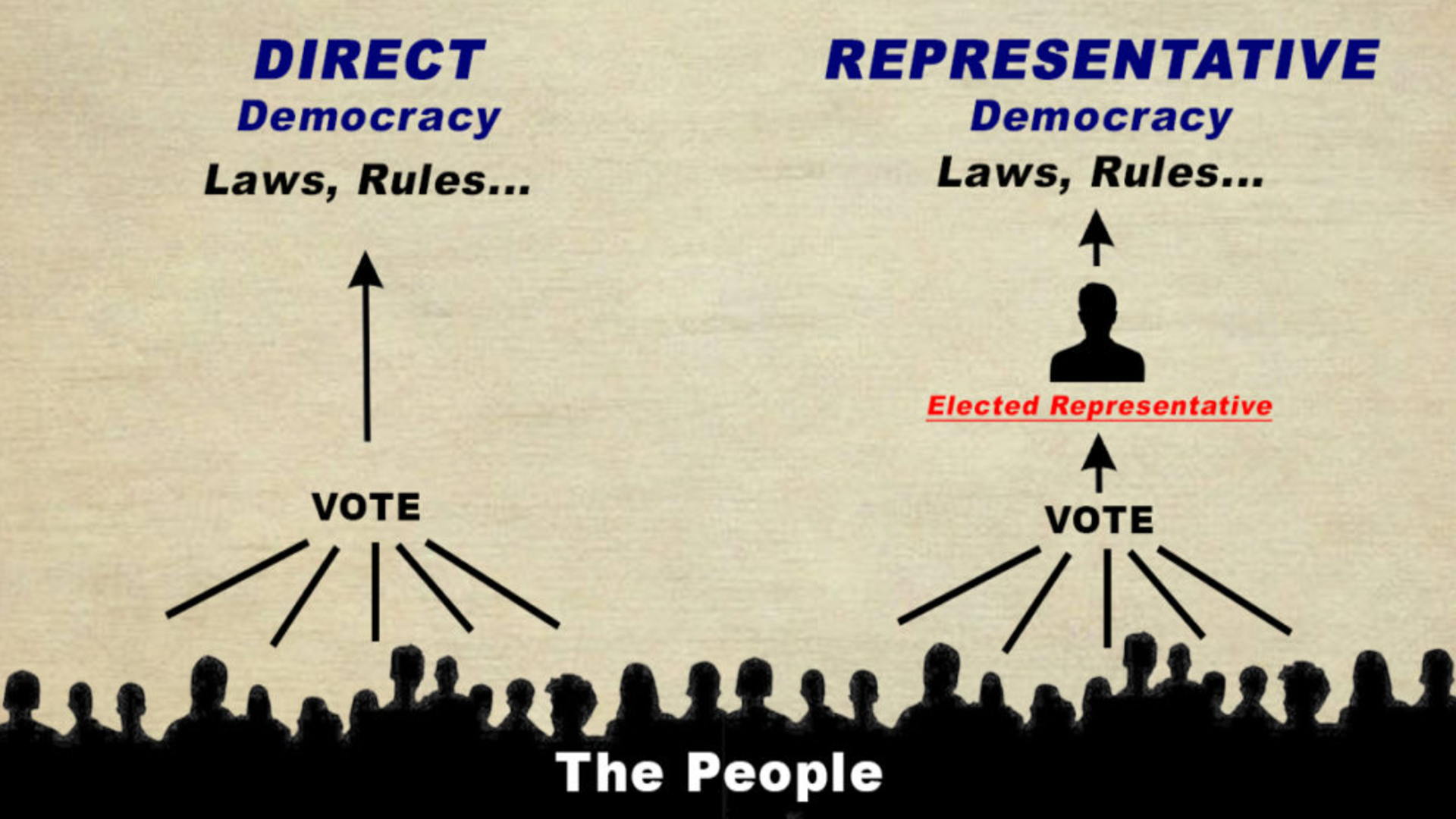
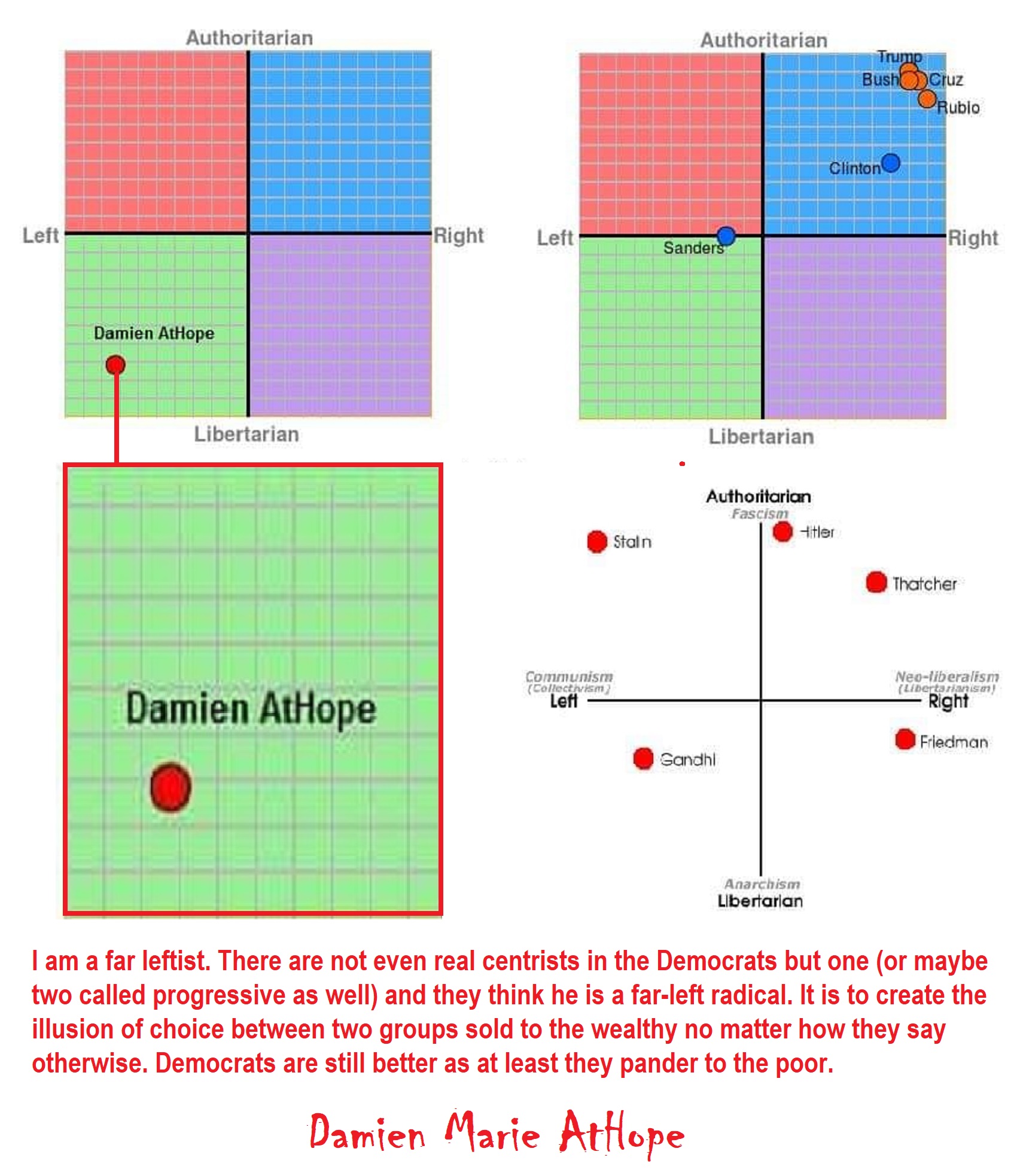
I am not an academic, I am a revolutionary sharing education and reason to inspire more deep thinking.
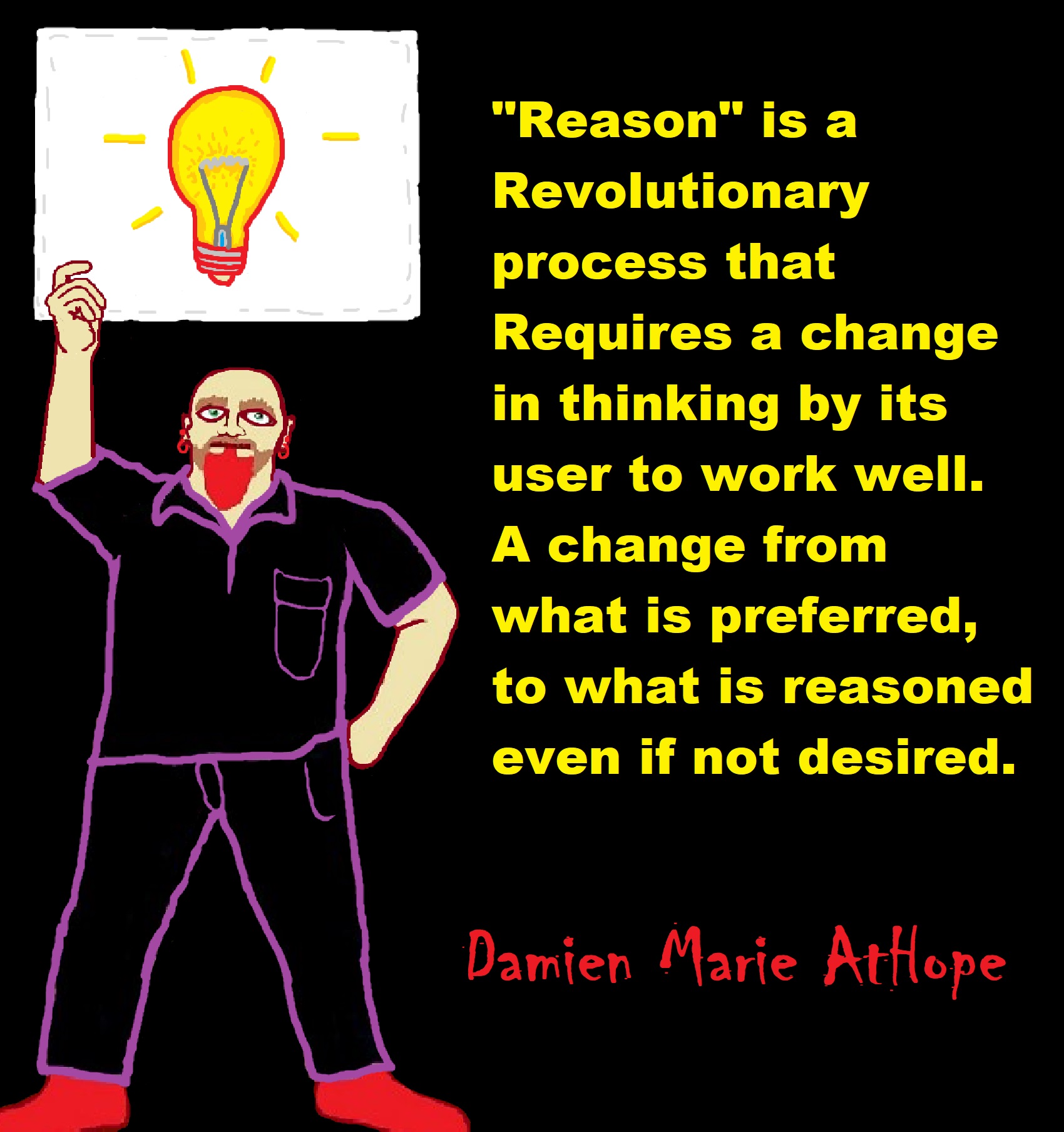
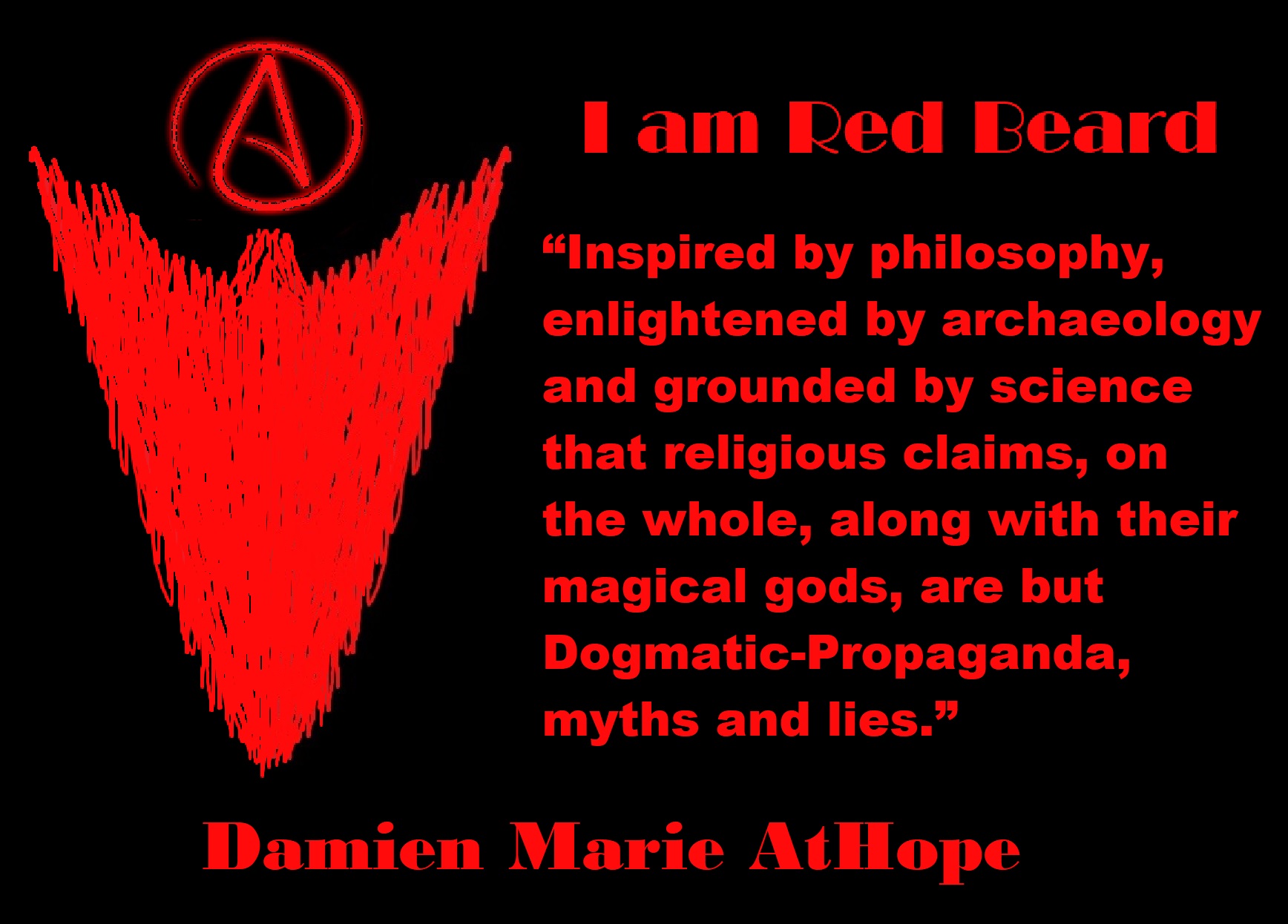
People don’t commonly teach religious history, even that of their own claimed religion. No, rather they teach a limited “pro their religion” history of their religion from a religious perspective favorable to the religion of choice.
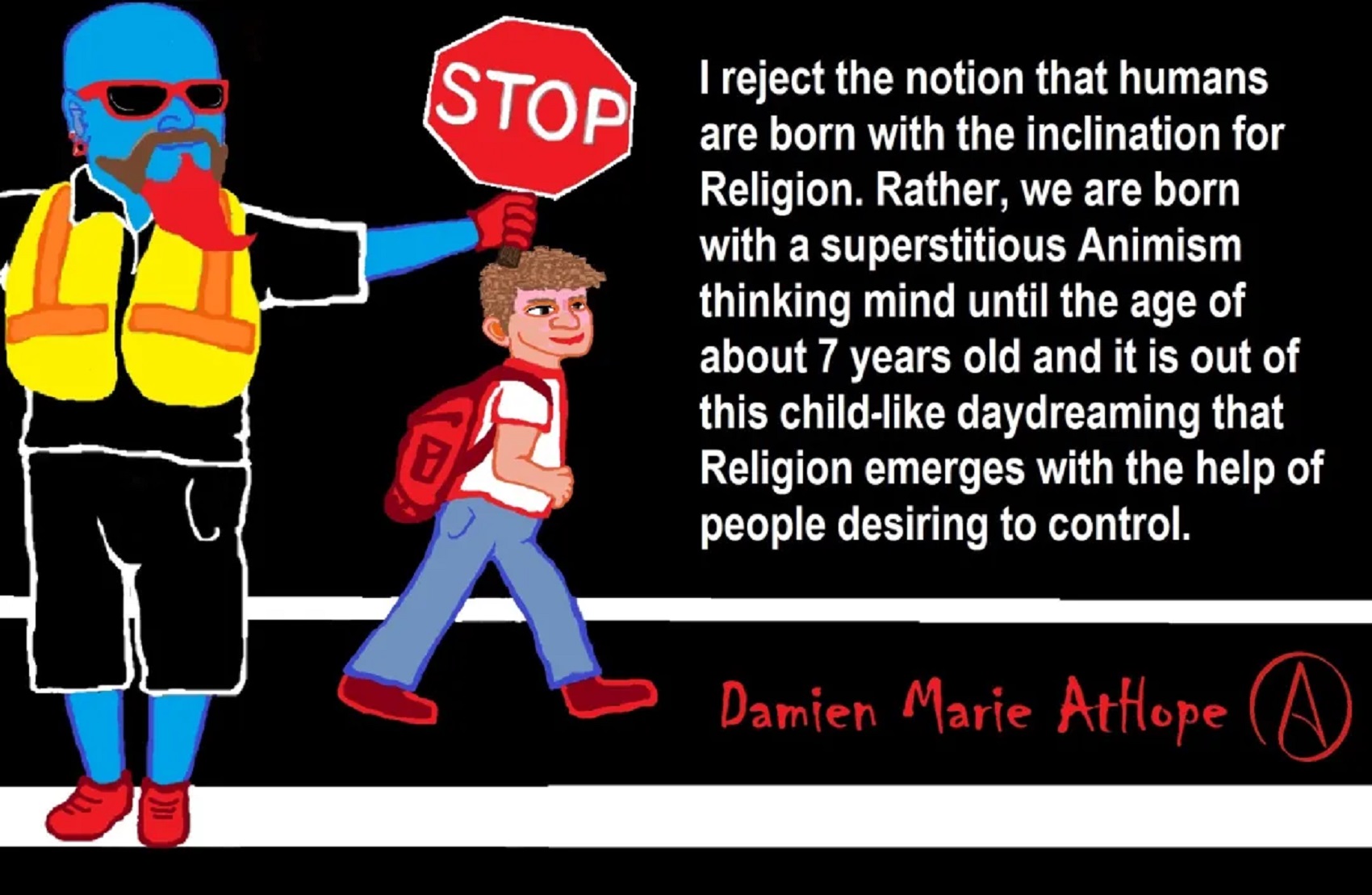
Do you truly think “Religious Belief” is only a matter of some personal choice?
Do you not see how coercive one’s world of choice is limited to the obvious hereditary belief, in most religious choices available to the child of religious parents or caregivers? Religion is more commonly like a family, culture, society, etc. available belief that limits the belief choices of the child and that is when “Religious Belief” is not only a matter of some personal choice and when it becomes hereditary faith, not because of the quality of its alleged facts or proposed truths but because everyone else important to the child believes similarly so they do as well simply mimicking authority beliefs handed to them. Because children are raised in religion rather than being presented all possible choices but rather one limited dogmatic brand of “Religious Belief” where children only have a choice of following the belief as instructed, and then personally claim the faith hereditary belief seen in the confirming to the belief they have held themselves all their lives. This is obvious in statements asked and answered by children claiming a faith they barely understand but they do understand that their family believes “this or that” faith, so they feel obligated to believe it too. While I do agree that “Religious Belief” should only be a matter of some personal choice, it rarely is… End Hereditary Religion!
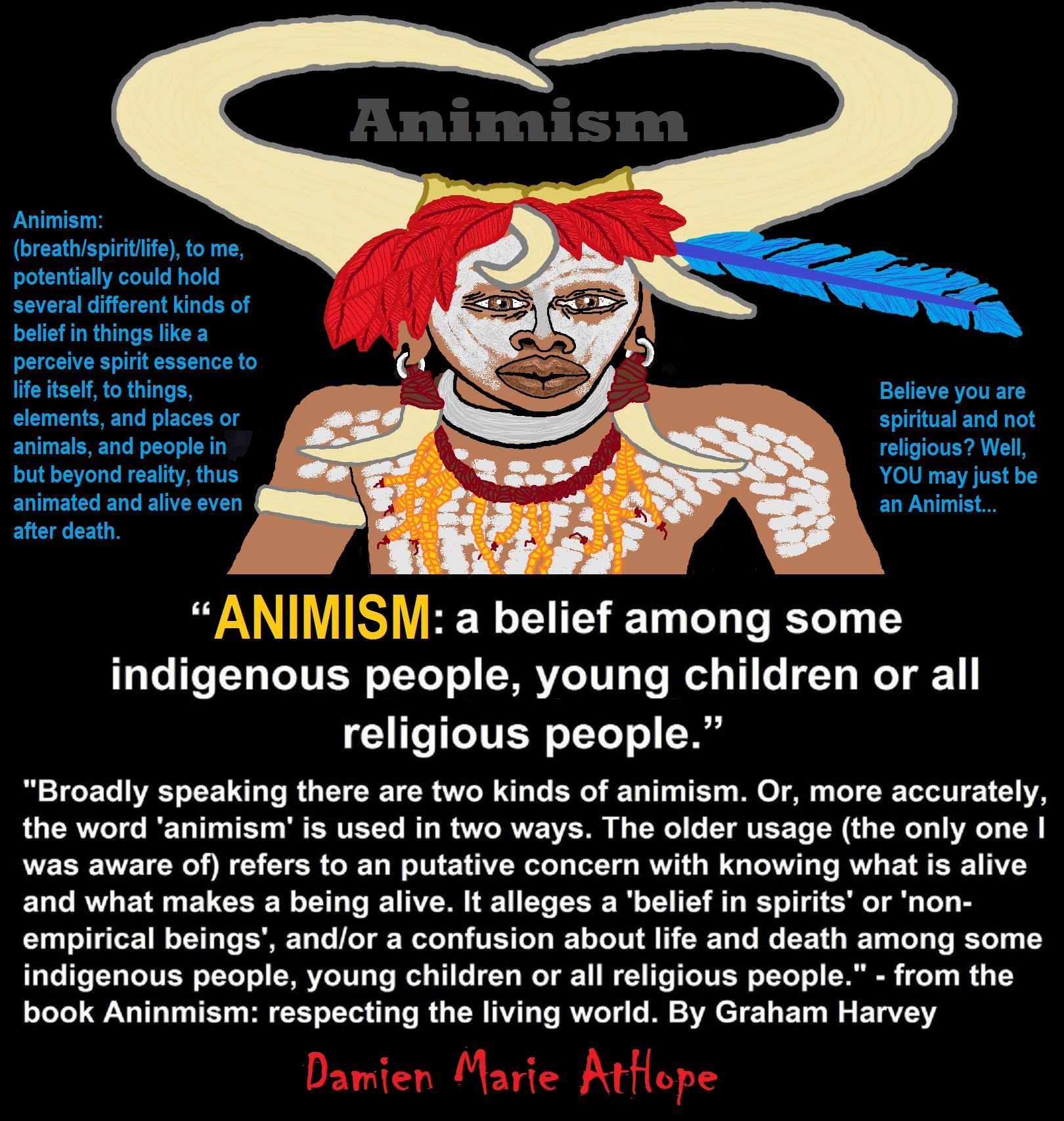
Animism: Respecting the Living World by Graham Harvey
“How have human cultures engaged with and thought about animals, plants, rocks, clouds, and other elements in their natural surroundings? Do animals and other natural objects have a spirit or soul? What is their relationship to humans? In this new study, Graham Harvey explores current and past animistic beliefs and practices of Native Americans, Maori, Aboriginal Australians, and eco-pagans. He considers the varieties of animism found in these cultures as well as their shared desire to live respectfully within larger natural communities. Drawing on his extensive casework, Harvey also considers the linguistic, performative, ecological, and activist implications of these different animisms.” ref
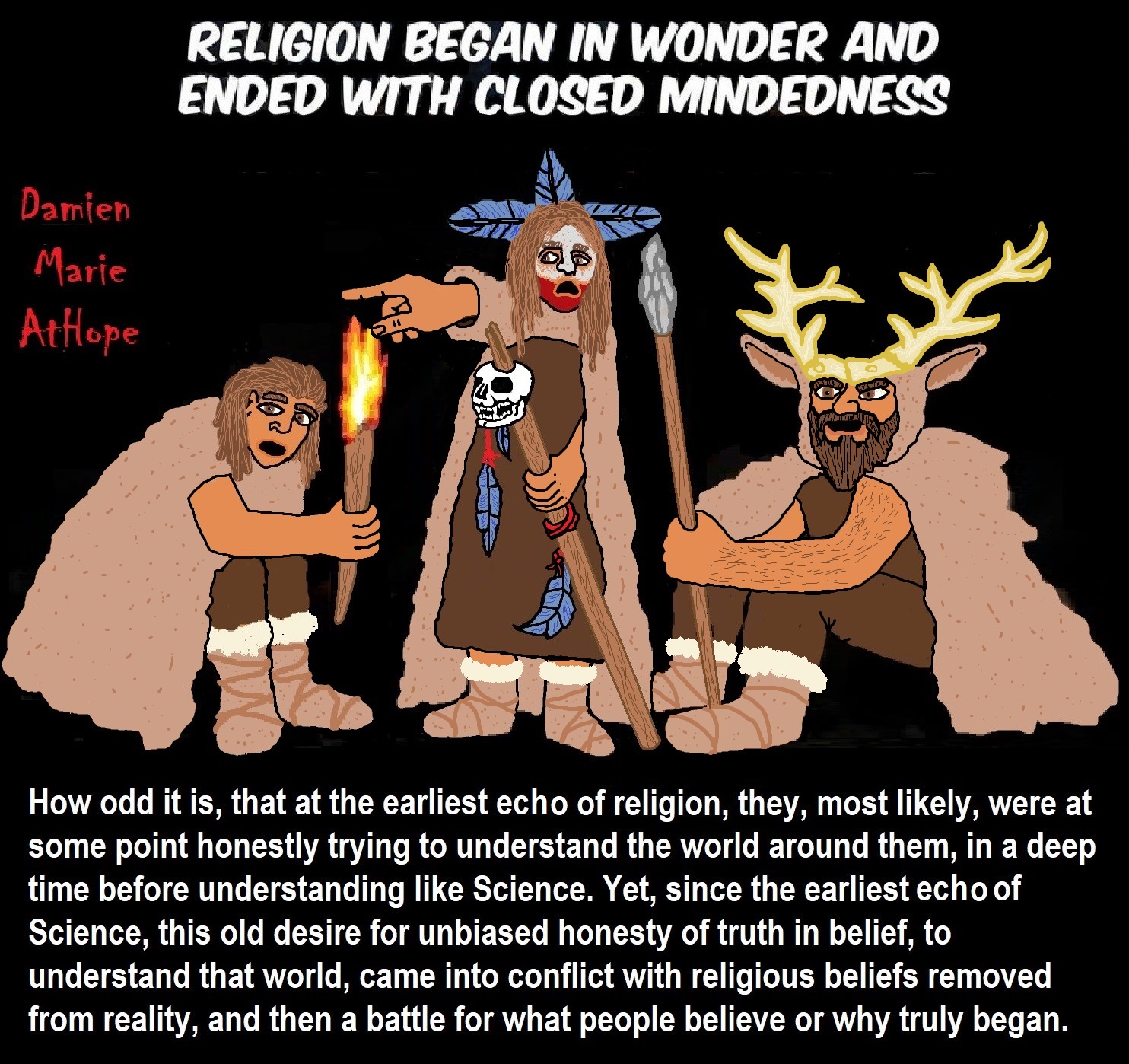
We are like believing machines we vacuum up ideas, like Velcro sticks to almost everything. We accumulate beliefs that we allow to negatively influence our lives, often without realizing it. Our willingness must be to alter skewed beliefs that impend our balance or reason, which allows us to achieve new positive thinking and accurate outcomes.
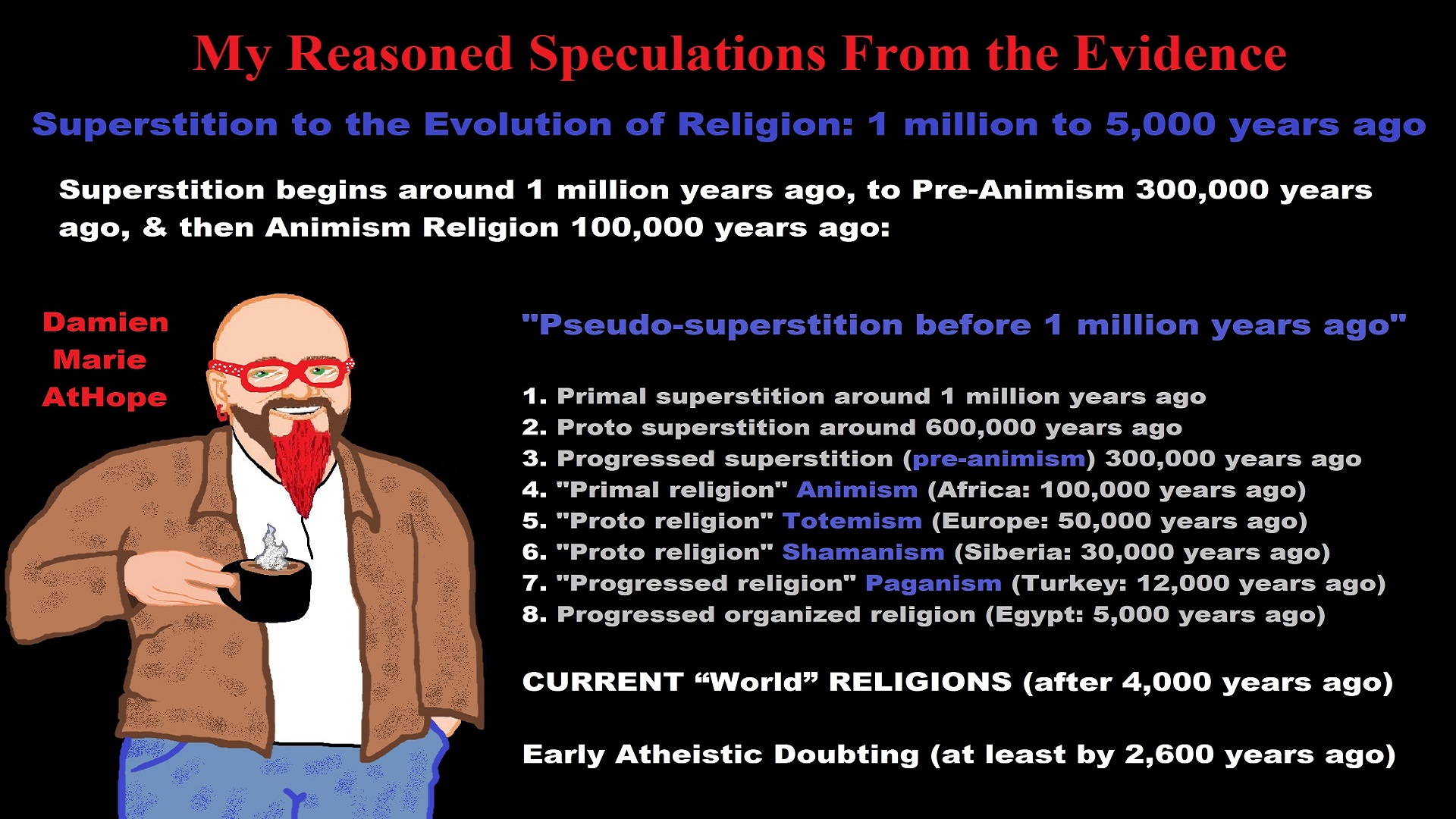
My thoughts on Religion Evolution with external links for more info:
- (Pre-Animism Africa mainly, but also Europe, and Asia at least 300,000 years ago), (Pre-Animism – Oxford Dictionaries)
- (Animism Africa around 100,000 years ago), (Animism – Britannica.com)
- (Totemism Europe around 50,000 years ago), (Totemism – Anthropology)
- (Shamanism Siberia around 30,000 years ago), (Shamanism – Britannica.com)
- (Paganism Turkey around 12,000 years ago), (Paganism – BBC Religion)
- (Progressed Organized Religion “Institutional Religion” Egypt around 5,000 years ago), (Ancient Egyptian Religion – Britannica.com)
- (CURRENT “World” RELIGIONS after 4,000 years ago) (Origin of Major Religions – Sacred Texts)
- (Early Atheistic Doubting at least by 2,600 years ago) (History of Atheism – Wikipedia)
“Religion is an Evolved Product” and Yes, Religion is Like Fear Given Wings…
Atheists talk about gods and religions for the same reason doctors talk about cancer, they are looking for a cure, or a firefighter talks about fires because they burn people and they care to stop them. We atheists too often feel a need to help the victims of mental slavery, held in the bondage that is the false beliefs of gods and the conspiracy theories of reality found in religions.
Understanding Religion Evolution:
- Pre-Animism (at least 300,000 years ago)
- Animism (Africa: 100,000 years ago)
- Totemism (Europe: 50,000 years ago)
- Shamanism (Siberia: 30,000 years ago)
- Paganism (Turkey: 12,000 years ago)
- Progressed organized religion (Egypt: 5,000 years ago), (Egypt, the First Dynasty 5,150 years ago)
- CURRENT “World” RELIGIONS (after 4,000 years ago)
- Early Atheistic Doubting (at least by 2,600 years ago)
“An Archaeological/Anthropological Understanding of Religion Evolution”
It seems ancient peoples had to survived amazing threats in a “dangerous universe (by superstition perceived as good and evil),” and human “immorality or imperfection of the soul” which was thought to affect the still living, leading to ancestor worship. This ancestor worship presumably led to the belief in supernatural beings, and then some of these were turned into the belief in gods. This feeble myth called gods were just a human conceived “made from nothing into something over and over, changing, again and again, taking on more as they evolve, all the while they are thought to be special,” but it is just supernatural animistic spirit-belief perceived as sacred.
Quick Evolution of Religion?
Pre-Animism (at least 300,000 years ago) pre-religion is a beginning that evolves into later Animism. So, Religion as we think of it, to me, all starts in a general way with Animism (Africa: 100,000 years ago) (theoretical belief in supernatural powers/spirits), then this is physically expressed in or with Totemism (Europe: 50,000 years ago) (theoretical belief in mythical relationship with powers/spirits through a totem item), which then enlists a full-time specific person to do this worship and believed interacting Shamanism (Siberia/Russia: 30,000 years ago) (theoretical belief in access and influence with spirits through ritual), and then there is the further employment of myths and gods added to all the above giving you Paganism (Turkey: 12,000 years ago) (often a lot more nature-based than most current top world religions, thus hinting to their close link to more ancient religious thinking it stems from). My hypothesis is expressed with an explanation of the building of a theatrical house (modern religions development). Progressed organized religion (Egypt: 5,000 years ago) with CURRENT “World” RELIGIONS (after 4,000 years ago).
Historically, in large city-state societies (such as Egypt or Iraq) starting around 5,000 years ago culminated to make religion something kind of new, a sociocultural-governmental-religious monarchy, where all or at least many of the people of such large city-state societies seem familiar with and committed to the existence of “religion” as the integrated life identity package of control dynamics with a fixed closed magical doctrine, but this juggernaut integrated religion identity package of Dogmatic-Propaganda certainly did not exist or if developed to an extent it was highly limited in most smaller prehistoric societies as they seem to lack most of the strong control dynamics with a fixed closed magical doctrine (magical beliefs could be at times be added or removed). Many people just want to see developed religious dynamics everywhere even if it is not. Instead, all that is found is largely fragments until the domestication of religion.
Religions, as we think of them today, are a new fad, even if they go back to around 6,000 years in the timeline of human existence, this amounts to almost nothing when seen in the long slow evolution of religion at least around 70,000 years ago with one of the oldest ritual worship. Stone Snake of South Africa: “first human worship” 70,000 years ago. This message of how religion and gods among them are clearly a man-made thing that was developed slowly as it was invented and then implemented peace by peace discrediting them all. Which seems to be a simple point some are just not grasping how devastating to any claims of truth when we can see the lie clearly in the archeological sites.
I wish people fought as hard for the actual values as they fight for the group/clan names political or otherwise they think support values. Every amount spent on war is theft to children in need of food or the homeless kept from shelter.
Here are several of my blog posts on history:
- To Find Truth You Must First Look
- (Magdalenian/Iberomaurusian) Connections to the First Paganists of the early Neolithic Near East Dating from around 17,000 to 12,000 Years Ago
- Natufians: an Ancient People at the Origins of Agriculture and Sedentary Life
- Possible Clan Leader/Special “MALE” Ancestor Totem Poles At Least 13,500 years ago?
- Jewish People with DNA at least 13,200 years old, Judaism, and the Origins of Some of its Ideas
- Baltic Reindeer Hunters: Swiderian, Lyngby, Ahrensburgian, and Krasnosillya cultures 12,020 to 11,020 years ago are evidence of powerful migratory waves during the last 13,000 years and a genetic link to Saami and the Finno-Ugric peoples.
- The Rise of Inequality: patriarchy and state hierarchy inequality
- Fertile Crescent 12,500 – 9,500 Years Ago: fertility and death cult belief system?
- 12,400 – 11,700 Years Ago – Kortik Tepe (Turkey) Pre/early-Agriculture Cultic Ritualism
- Ritualistic Bird Symbolism at Gobekli Tepe and its “Ancestor Cult”
- Male-Homosexual (female-like) / Trans-woman (female) Seated Figurine from Gobekli Tepe
- Could a 12,000-year-old Bull Geoglyph at Göbekli Tepe relate to older Bull and Female Art 25,000 years ago and Later Goddess and the Bull cults like Catal Huyuk?
- Sedentism and the Creation of goddesses around 12,000 years ago as well as male gods after 7,000 years ago.
- Alcohol, where Agriculture and Religion Become one? Such as Gobekli Tepe’s Ritualistic use of Grain as Food and Ritual Drink
- Neolithic Ritual Sites with T-Pillars and other Cultic Pillars
- Paganism: Goddesses around 12,000 years ago then Male Gods after 7,000 years ago
- First Patriarchy: Split of Women’s Status around 12,000 years ago & First Hierarchy: fall of Women’s Status around 5,000 years ago.
- Natufians: an Ancient People at the Origins of Agriculture and Sedentary Life
- J DNA and the Spread of Agricultural Religion (paganism)
- Paganism: an approximately 12,000-year-old belief system
- Paganism 12,000 years old: related to “Anarchism and Socialism” (Pre-Capitalism)
- Shaman burial in Israel 12,000 years ago and the Shamanism Phenomena
- Need to Mythicized: gods and goddesses
- 12,000 – 7,000 Years Ago – Paleo-Indian Culture (The Americas)
- 12,000 – 2,000 Years Ago – Indigenous-Scandinavians (Nordic)
- Norse did not wear helmets with horns?
- Pre-Pottery Neolithic Skull Cult around 11,500 to 8,400 Years Ago?
- 10,400 – 10,100 Years Ago, in Turkey the Nevail Cori Religious Settlement
- 9,000-6,500 Years Old Submerged Pre-Pottery/Pottery Neolithic Ritual Settlements off Israel’s Coast
- Catal Huyuk “first religious designed city” around 9,500 to 7,700 years ago (Turkey)
- Cultic Hunting at Catal Huyuk “first religious designed city”
- Special Items and Art as well as Special Elite Burials at Catal Huyuk
- New Rituals and Violence with the appearance of Pottery and People?
- Haplogroup N and its related Uralic Languages and Cultures
- Ainu people, Sámi people, Native Americans, the Ancient North Eurasians, and Paganistic-Shamanism with Totemism
- Ideas, Technology and People from Turkey, Europe, to China and Back again 9,000 to 5,000 years ago?
- First Pottery of Europe and the Related Cultures
- 9,000 years old Neolithic Artifacts Judean Desert and Hills Israel
- 9,000-7,000 years-old Sex and Death Rituals: Cult Sites in Israel, Jordan, and the Sinai
- 9,000-8500 year old Horned Female shaman Bad Dürrenberg Germany
- Neolithic Jewelry and the Spread of Farming in Europe Emerging out of West Turkey
- 8,600-year-old Tortoise Shells in Neolithic graves in central China have Early Writing and Shamanism
- Swing of the Mace: the rise of Elite, Forced Authority, and Inequality begin to Emerge 8,500 years ago?
- Migrations and Changing Europeans Beginning around 8,000 Years Ago
- My “Steppe-Anatolian-Kurgan hypothesis” 8,000/7,000 years ago
- Around 8,000-year-old Shared Idea of the Mistress of Animals, “Ritual” Motif
- Pre-Columbian Red-Paint (red ochre) Maritime Archaic Culture 8,000-3,000 years ago
- 7,522-6,522 years ago Linear Pottery culture which I think relates to Arcane Capitalism’s origins
- Arcane Capitalism: Primitive socialism, Primitive capital, Private ownership, Means of production, Market capitalism, Class discrimination, and Petite bourgeoisie (smaller capitalists)
- 7,500-4,750 years old Ritualistic Cucuteni-Trypillian culture of Moldova, Romania, and Ukraine
- Roots of a changing early society 7,200-6,700 years ago Jordan and Israel
- Agriculture religion (Paganism) with farming reached Britain between about 7,000 to 6,500 or so years ago and seemingly expressed in things like Western Europe’s Long Barrows
- My Thoughts on Possible Migrations of “R” DNA and Proto-Indo-European?
- “Millet” Spreading from China 7,022 years ago to Europe and related Language may have Spread with it leading to Proto-Indo-European
- Proto-Indo-European (PIE), ancestor of Indo-European languages: DNA, Society, Language, and Mythology
- The Dnieper–Donets culture and Asian varieties of Millet from China to the Black Sea region of Europe by 7,022 years ago
- Kurgan 6,000 years ago/dolmens 7,000 years ago: funeral, ritual, and other?
- 7,020 to 6,020-year-old Proto-Indo-European Homeland of Urheimat or proposed home of their Language and Religion
- Ancient Megaliths: Kurgan, Ziggurat, Pyramid, Menhir, Trilithon, Dolman, Kromlech, and Kromlech of Trilithons
- The Mytheme of Ancient North Eurasian Sacred-Dog belief and similar motifs are found in Indo-European, Native American, and Siberian comparative mythology
- Elite Power Accumulation: Ancient Trade, Tokens, Writing, Wealth, Merchants, and Priest-Kings
- Sacred Mounds, Mountains, Kurgans, and Pyramids may hold deep connections?
- Between 7,000-5,000 Years ago, rise of unequal hierarchy elite, leading to a “birth of the State” or worship of power, strong new sexism, oppression of non-elites, and the fall of Women’s equal status
- Paganism 7,000-5,000 years old: related to “Anarchism and Socialism” (Capitalism) (World War 0) Elite & their slaves
- Hell and Underworld mythologies starting maybe as far back as 7,000 to 5,000 years ago with the Proto-Indo-Europeans?
- The First Expression of the Male God around 7,000 years ago?
- White (light complexion skin) Bigotry and Sexism started 7,000 years ago?
- Around 7,000-year-old Shared Idea of the Divine Bird (Tutelary and/or Trickster spirit/deity), “Ritual” Motif
- Nekhbet an Ancient Egyptian Vulture Goddess and Tutelary Deity
- 6,720 to 4,920 years old Ritualistic Hongshan Culture of Inner Mongolia with 5,000-year-old Pyramid Mounds and Temples
- First proto-king in the Balkans, Varna culture around 6,500 years ago?
- 6,500–5,800 years ago in Israel Late Chalcolithic (Copper Age) Period in the Southern Levant Seems to Express Northern Levant Migrations, Cultural and Religious Transfer
- KING OF BEASTS: Master of Animals “Ritual” Motif, around 6,000 years old or older…
- Around 6000-year-old Shared Idea of the Solid Wheel & the Spoked Wheel-Shaped Ritual Motif
- “The Ghassulian Star,” a mysterious 6,000-year-old mural from Jordan; a Proto-Star of Ishtar, Star of Inanna or Star of Venus?
- Religious/Ritual Ideas, including goddesses and gods as well as ritual mounds or pyramids from Northeastern Asia at least 6,000 years old, seemingly filtering to Iran, Iraq, the Mediterranean, Europe, Egypt, and the Americas?
- Maykop (5,720–5,020 years ago) Caucasus region Bronze Age culture-related to Copper Age farmers from the south, influenced by the Ubaid period and Leyla-Tepe culture, as well as influencing the Kura-Araxes culture
- 5-600-year-old Tomb, Mummy, and First Bearded Male Figurine in a Grave
- Kura-Araxes Cultural 5,520 to 4,470 years old DNA traces to the Canaanites, Arabs, and Jews
- Minoan/Cretan (Keftiu) Civilization and Religion around 5,520 to 3,120 years ago
- Evolution Of Science at least by 5,500 years ago
- 5,500 Years old birth of the State, the rise of Hierarchy, and the fall of Women’s status
- “Jiroft culture” 5,100 – 4,200 years ago and the History of Iran
- Stonehenge: Paganistic Burial and Astrological Ritual Complex, England (5,100-3,600 years ago)
- Around 5,000-year-old Shared Idea of the “Tree of Life” Ritual Motif
- Complex rituals for elite, seen from China to Egypt, at least by 5,000 years ago
- Around 5,000 years ago: “Birth of the State” where Religion gets Military Power and Influence
- The Center of the World “Axis Mundi” and/or “Sacred Mountains” Mythology Could Relate to the Altai Mountains, Heart of the Steppe
- Progressed organized religion starts, an approximately 5,000-year-old belief system
- China’s Civilization between 5,000-3,000 years ago, was a time of war and class struggle, violent transition from free clans to a Slave or Elite society
- Origin of Logics is Naturalistic Observation at least by around 5,000 years ago.
- Paganism 5,000 years old: progressed organized religion and the state: related to “Anarchism and Socialism” (Kings and the Rise of the State)
- Ziggurats (multi-platform temples: 4,900 years old) to Pyramids (multi-platform tombs: 4,700 years old)
- Did a 4,520–4,420-year-old Volcano In Turkey Inspire the Bible God?
- Finland’s Horned Shaman and Pre-Horned-God at least 4,500 years ago?
- 4,000-year-Old Dolmens in Israel: A Connected Dolmen Religious Phenomenon?
- Creation myths: From chaos, Ex nihilo, Earth-diver, Emergence, World egg, and World parent
- Bronze Age “Ritual” connections of the Bell Beaker culture with the Corded Ware/Single Grave culture, which were related to the Yamnaya culture and Proto-Indo-European Languages/Religions
- Low Gods (Earth/ Tutelary deity), High Gods (Sky/Supreme deity), and Moralistic Gods (Deity enforcement/divine order)
- The exchange of people, ideas, and material-culture including, to me, the new god (Sky Father) and goddess (Earth Mother) religion between the Cucuteni-Trypillians and others which is then spread far and wide
- Koryaks: Indigenous People of the Russian Far East and Big Raven myths also found in Tlingit, Haida, Tsimshian, and other Indigenous People of North America
- 42 Principles Of Maat (Egyptian Goddess of the justice) around 4,400 years ago, 2000 Years Before Ten Commandments
- “Happy Easter” Well Happy Eostre/Ishter
- 4,320-3,820 years old “Shimao” (North China) site with Totemistic-Shamanistic Paganism and a Stepped Pyramid
- 4,250 to 3,400 Year old Stonehenge from Russia: Arkaim?
- 4,100-year-old beaker with medicinal & flowering plants in a grave of a woman in Scotland
- Early European Farmer ancestry, Kelif el Boroud people with the Cardial Ware culture, and the Bell Beaker culture Paganists too, spread into North Africa, then to the Canary Islands off West Africa
- Flood Accounts: Gilgamesh epic (4,100 years ago) Noah in Genesis (2,600 years ago)
- Paganism 4,000 years old: related to “Anarchism and Socialism” (First Moralistic gods, then the Origin time of Monotheism)
- When was the beginning: TIMELINE OF CURRENT RELIGIONS, which start around 4,000 years ago.
- Early Religions Thought to Express Proto-Monotheistic Systems around 4,000 years ago
- Kultepe? An archaeological site with a 4,000 years old women’s rights document.
- Single God Religions (Monotheism) = “Man-o-theism” started around 4,000 years ago with the Great Sky Spirit/God Tiān (天)?
- Confucianism’s Tiān (Shangdi god 4,000 years old): Supernaturalism, Pantheism or Theism?
- Yes, Your Male God is Ridiculous
- Mythology, a Lunar Deity is a Goddess or God of the Moon
- Sacred Land, Hills, and Mountains: Sami Mythology (Paganistic Shamanism)
- Horse Worship/Sacrifice: mythical union of Ruling Elite/Kingship and the Horse
- The Amorite/Amurru people’s God Amurru “Lord of the Steppe”, relates to the Origins of the Bible God?
- Bronze Age Exotic Trade Routes Spread Quite Far as well as Spread Religious Ideas with Them
- Sami and the Northern Indigenous Peoples Landscape, Language, and its Connection to Religion
- Prototype of Ancient Analemmatic Sundials around 3,900-3,150 years ago and a Possible Solar Connection to gods?
- Judaism is around 3,450 or 3,250 years old. (“Paleo-Hebrew” 3,000 years ago and Torah 2,500 years ago)
- The Weakening of Ancient Trade and the Strengthening of Religions around 3000 years ago?
- Are you aware that there are religions that worship women gods, explain now religion tears women down?
- Animistic, Totemistic, and Paganistic Superstition Origins of bible god and the bible’s Religion.
- Myths and Folklore: “Trickster gods and goddesses”
- Jews, Judaism, and the Origins of Some of its Ideas
- An Old Branch of Religion Still Giving Fruit: Sacred Trees
- Dating the BIBLE: naming names and telling times (written less than 3,000 years ago, provable to 2,200 years ago)
- Did a Volcano Inspire the bible god?
- Dené–Yeniseian language, Old Copper Complex, and Pre-Columbian Mound Builders?
- No “dinosaurs and humans didn’t exist together just because some think they are in the bible itself”
- Sacred Shit and Sacred Animals?
- Everyone Killed in the Bible Flood? “Nephilim” (giants)?
- Hey, Damien dude, I have a question for you regarding “the bible” Exodus.
- Archaeology Disproves the Bible
- Bible Battle, Just More, Bible Babble
- The Jericho Conquest lie?
- Canaanites and Israelites?
- Accurate Account on how did Christianity Began?
- Let’s talk about Christianity.
- So the 10 commandments isn’t anything to go by either right?
- Misinformed christian
- Debunking Jesus?
- Paulism vs Jesus
- Ok, you seem confused so let’s talk about Buddhism.
- Unacknowledged Buddhism: Gods, Savior, Demons, Rebirth, Heavens, Hells, and Terrorism
- His Foolishness The Dalai Lama
- Yin and Yang is sexist with an ORIGIN around 2,300 years ago?
- I Believe Archaeology, not Myths & Why Not, as the Religious Myths Already Violate Reason!
- Archaeological, Scientific, & Philosophic evidence shows the god myth is man-made nonsense.
- Aquatic Ape Theory/Hypothesis? As Always, Just Pseudoscience.
- Ancient Aliens Conspiracy Theorists are Pseudohistorians
- The Pseudohistoric and Pseudoscientific claims about “Bakoni Ruins” of South Africa
- Why do people think Religion is much more than supernaturalism and superstitionism?
- Religion is an Evolved Product
- Was the Value of Ancient Women Different?
- 1000 to 1100 CE, human sacrifice Cahokia Mounds a pre-Columbian Native American site
- Feminist atheists as far back as the 1800s?
- Promoting Religion as Real is Mentally Harmful to a Flourishing Humanity
- Screw All Religions and Their Toxic lies, they are all fraud
- Forget Religions’ Unfounded Myths, I Have Substantiated “Archaeology Facts.”
- Religion Dispersal throughout the World
- I Hate Religion Just as I Hate all Pseudoscience
- Exposing Scientology, Eckankar, Wicca and Other Nonsense?
- Main deity or religious belief systems
- Quit Trying to Invent Your God From the Scraps of Science.
- Archaeological, Scientific, & Philosophic evidence shows the god myth is man-made nonsense.
- Ancient Alien Conspiracy Theorists: Misunderstanding, Rhetoric, Misinformation, Fabrications, and Lies
- Misinformation, Distortion, and Pseudoscience in Talking with a Christian Creationist
- Judging the Lack of Goodness in Gods, Even the Norse God Odin
- Challenging the Belief in God-like Aliens and Gods in General
- A Challenge to Christian use of Torture Devices?
- Yes, Hinduism is a Religion
- Trump is One of the Most Reactionary Forces of Far-right Christian Extremism
- Was the Bull Head a Symbol of God? Yes!
- Primate Death Rituals
- Christian – “God and Christianity are objectively true”
- Australopithecus afarensis Death Ritual?
- You Claim Global Warming is a Hoax?
- Doubter of Science and Defamer of Atheists?
- I think that sounds like the Bible?
- History of the Antifa (“anti-fascist”) Movements
- Indianapolis Anti-Blasphemy Laws #Free Soheil Rally
- Damien, you repeat the golden rule in so many forms then you say religion is dogmatic?
- Science is a Trustable Methodology whereas Faith is not Trustable at all!
- Was I ever a believer, before I was an atheist?
- Atheists rise in reason
- Mistrust of science?
- Open to Talking About the Definition of ‘God’? But first, we address Faith.
- ‘United Monarchy’ full of splendor and power – Saul, David, and Solomon? Most likely not.
- Is there EXODUS ARCHAEOLOGY? The short answer is “no.”
- Lacking Proof of Bigfoots, Unicorns, and Gods is Just a Lack of Research?
- Religion and Politics: Faith Beliefs vs. Rational Thinking
- Hammer of Truth that lying pig RELIGION: challenged by an archaeologist
- “The Hammer of Truth” -ontology question- What do You Mean by That?
- Navigation of a bad argument: Ad Hominem vs. Attack
- Why is it Often Claimed that Gods have a Gender?
- Why are basically all monotheistic religions ones that have a male god?
- Shifting through the Claims in support of Faith
- Dear Mr. AtHope, The 20th Century is an Indictment of Secularism and a Failed Atheist Century
- An Understanding of the Worldwide Statistics and Dynamics of Terrorist Incidents and Suicide Attacks
- Intoxication and Evolution? Addressing and Assessing the “Stoned Ape” or “Drunken Monkey” Theories as Catalysts in Human Evolution
- Sacred Menstrual cloth? Inanna’s knot, Isis knot, and maybe Ma’at’s feather?
- Damien, why don’t the Hebrews accept the bible stories?
- Dealing with a Troll and Arguing Over Word Meaning
- Knowledge without Belief? Justified beliefs or disbeliefs worthy of Knowledge?
- Afrocentrism and African Religions
- Crecganford @crecganford offers history & stories of the people, places, gods, & culture
- Empiricism-Denier?
I am not an academic. I am a revolutionary that teaches in public, in places like social media, and in the streets. I am not a leader by some title given but from my commanding leadership style of simply to start teaching everywhere to everyone, all manner of positive education.
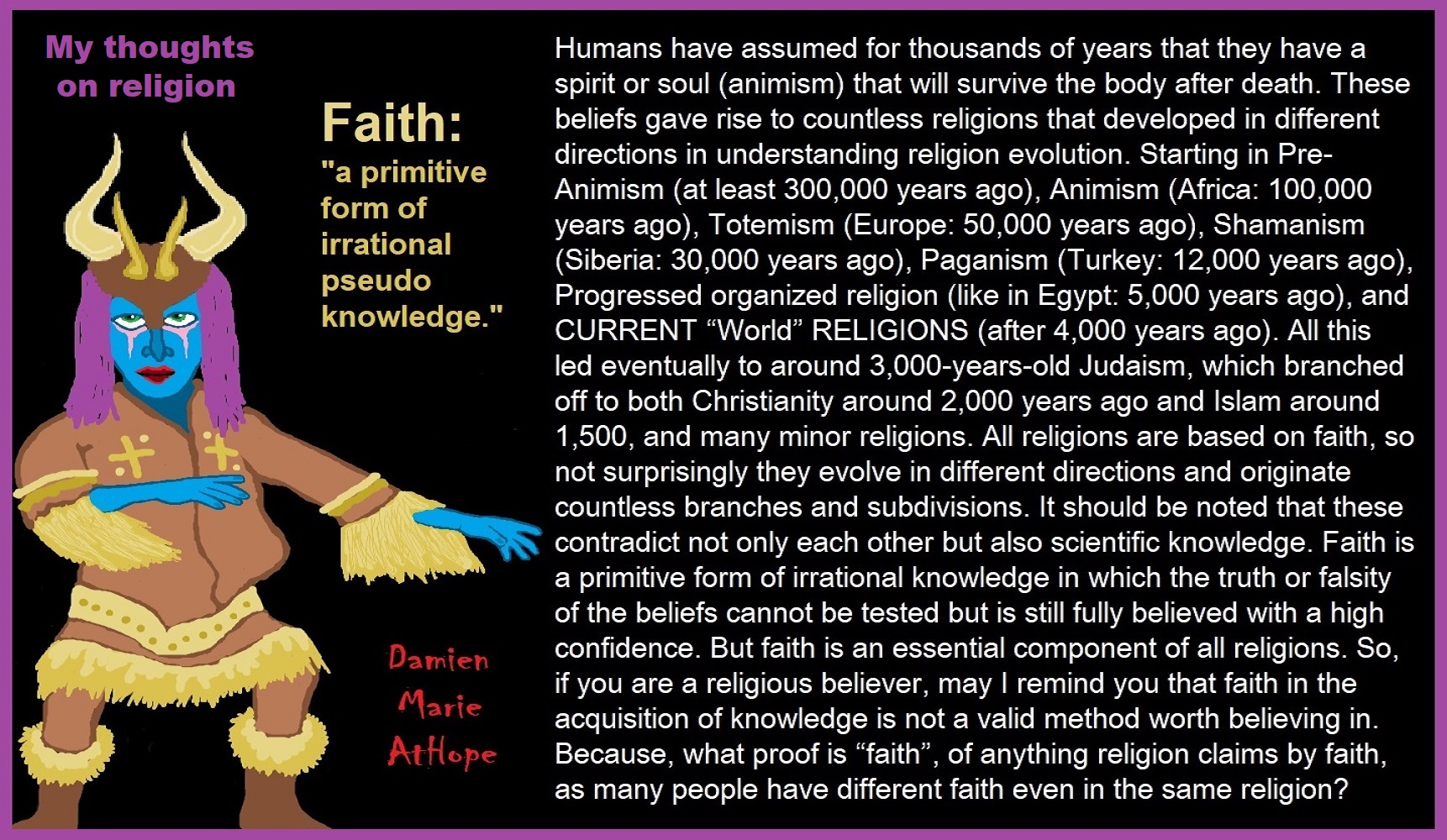
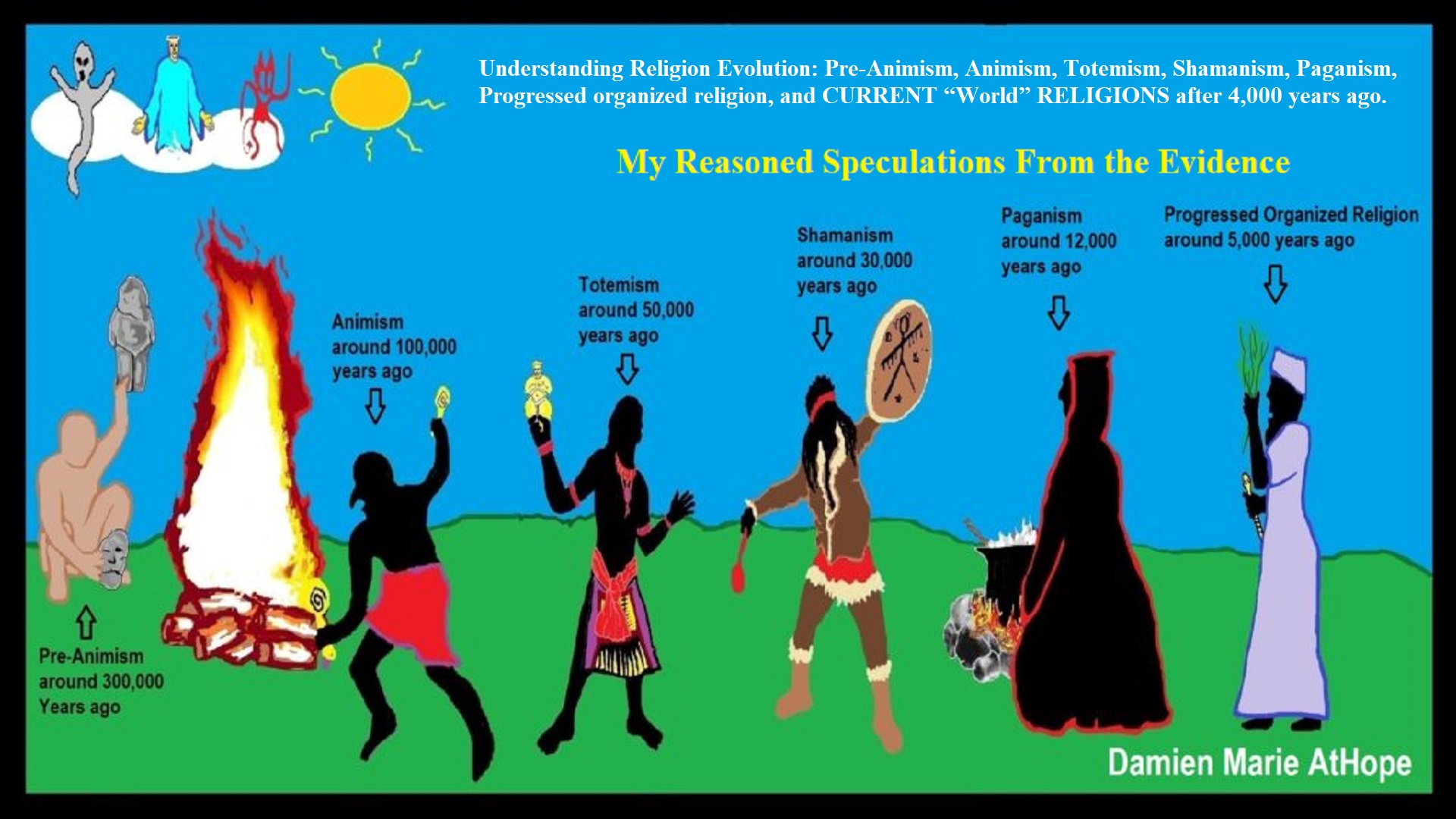
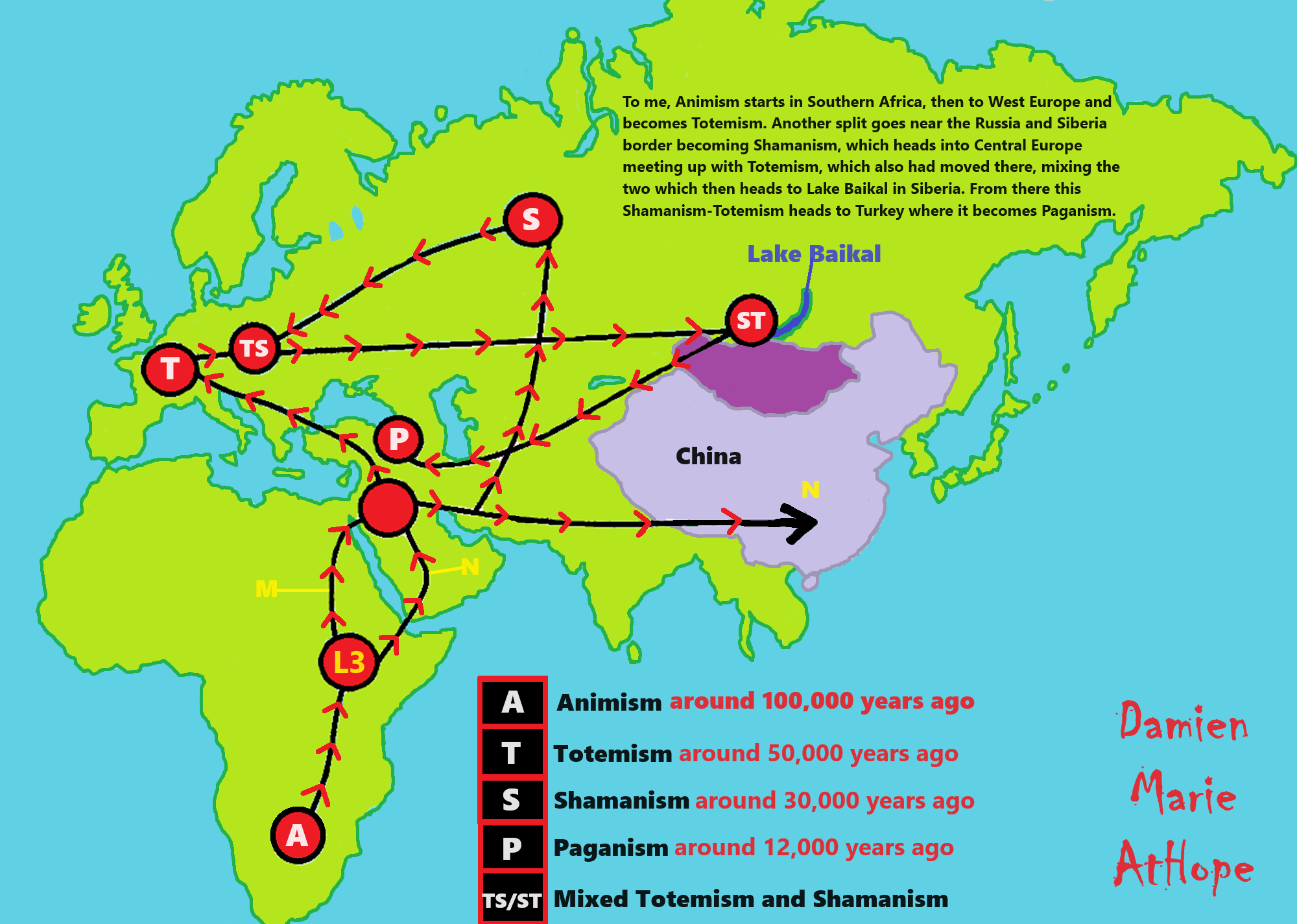
To me, Animism starts in Southern Africa, then to West Europe, and becomes Totemism. Another split goes near the Russia and Siberia border becoming Shamanism, which heads into Central Europe meeting up with Totemism, which also had moved there, mixing the two which then heads to Lake Baikal in Siberia. From there this Shamanism-Totemism heads to Turkey where it becomes Paganism.
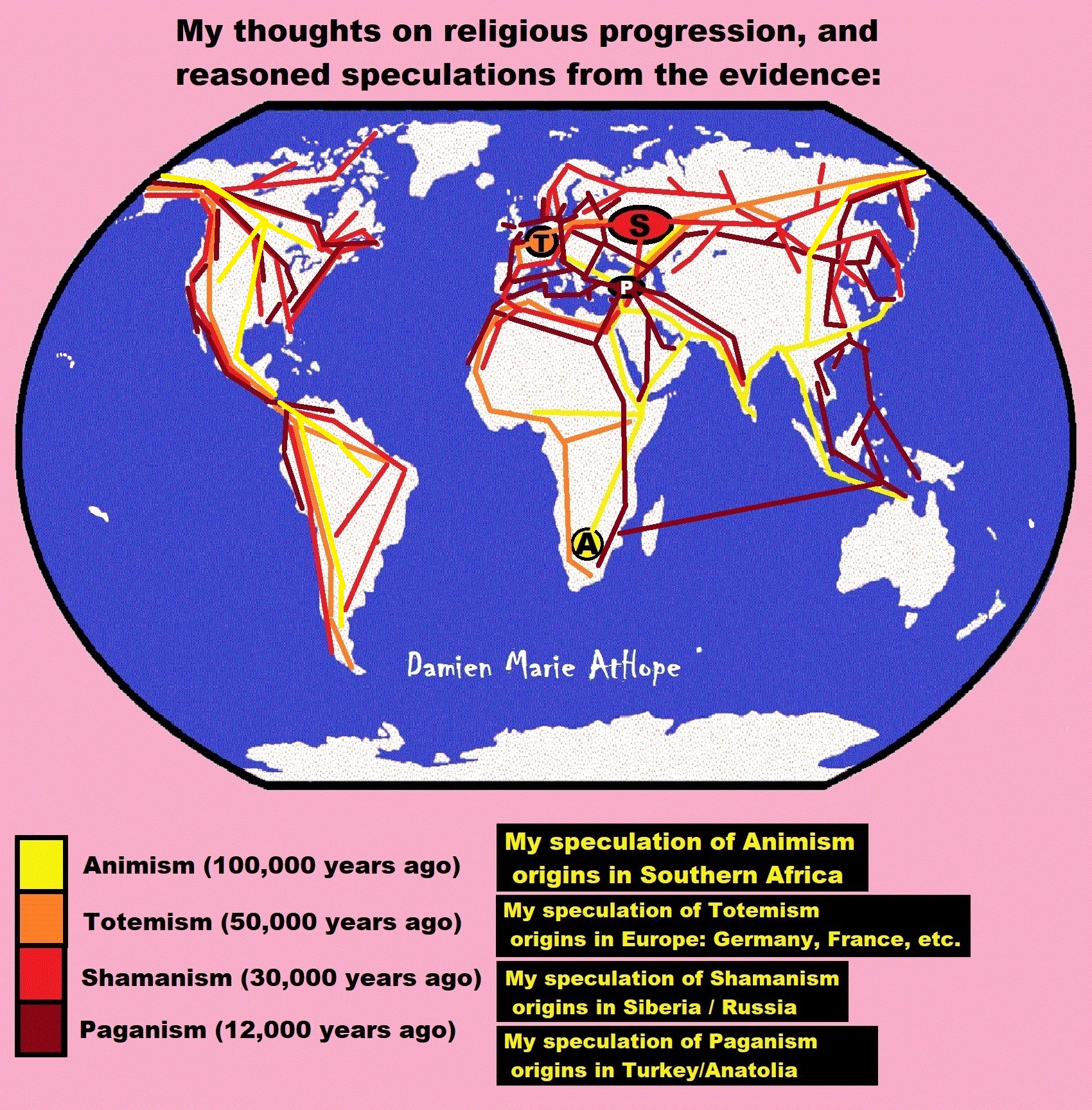
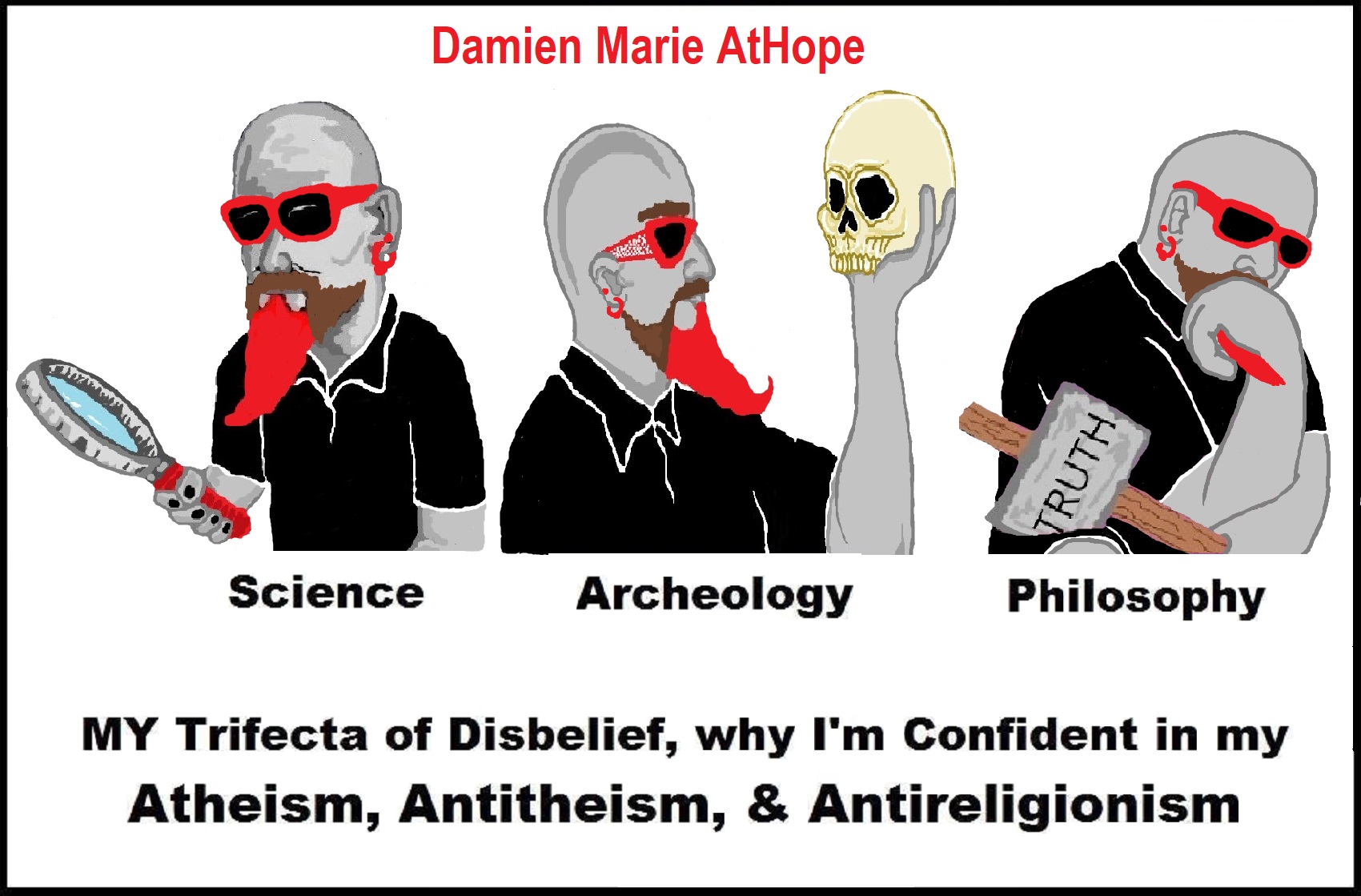
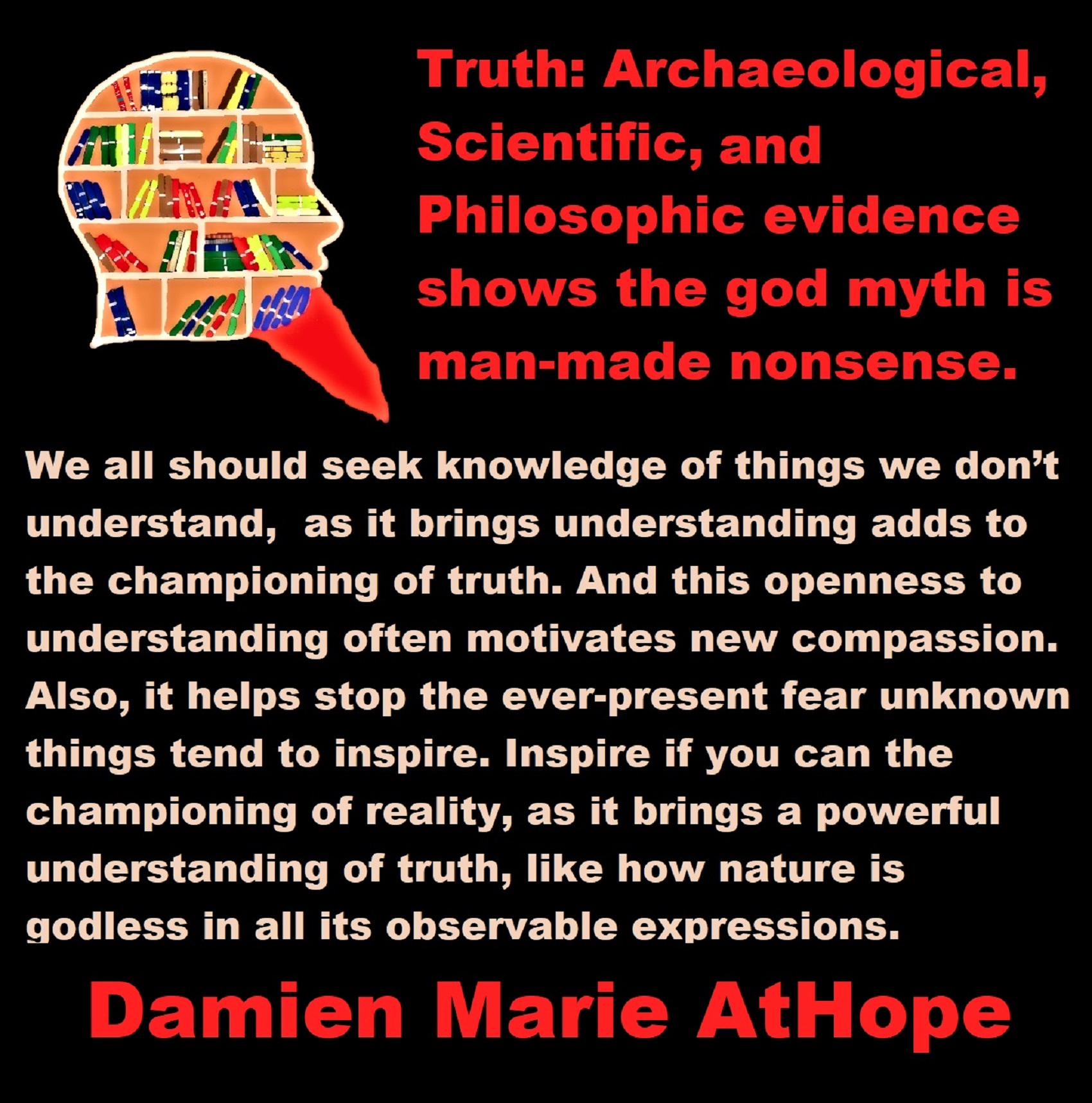
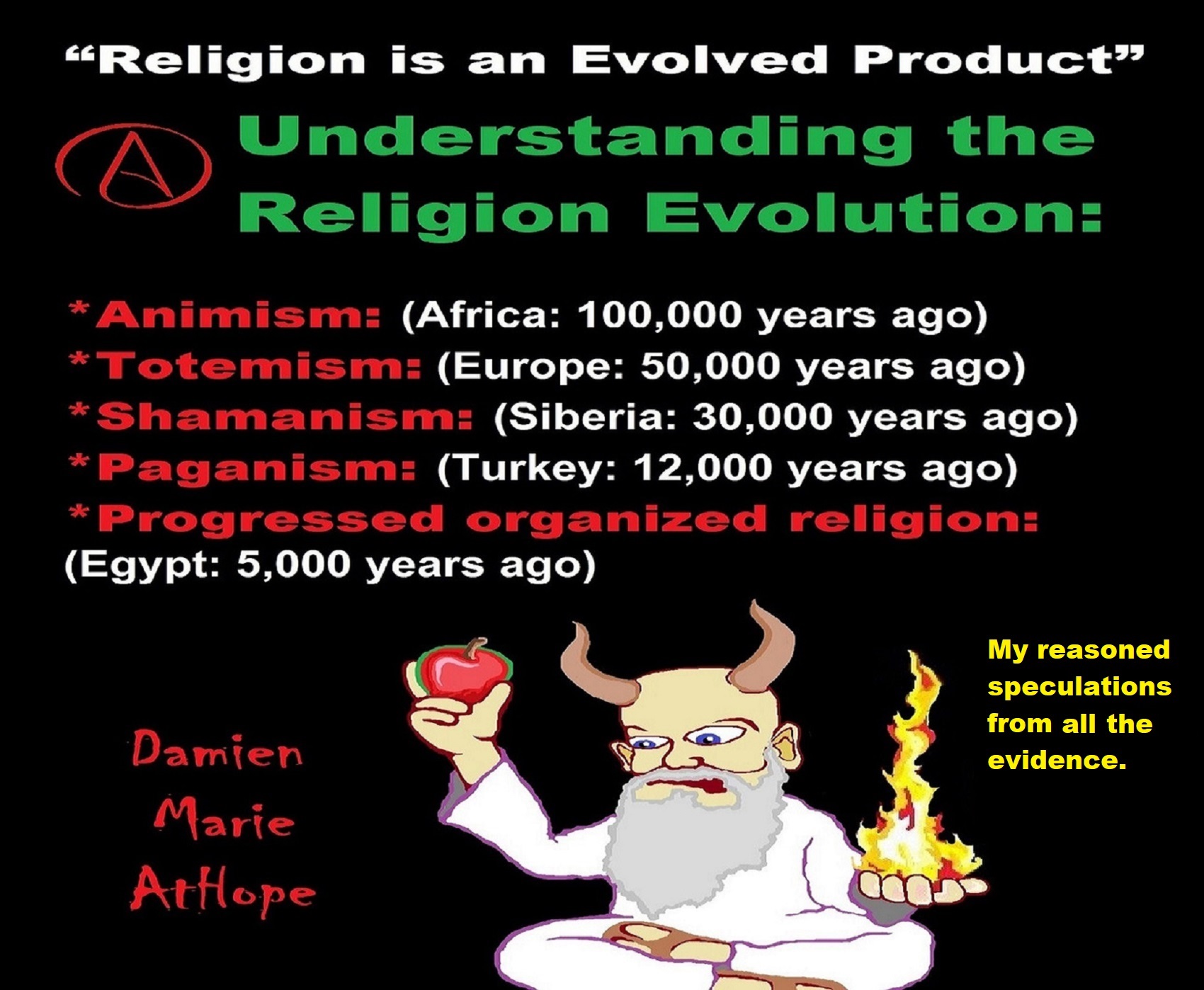
Not all “Religions” or “Religious Persuasions” have a god(s) but
All can be said to believe in some imaginary beings or imaginary things like spirits, afterlives, etc.
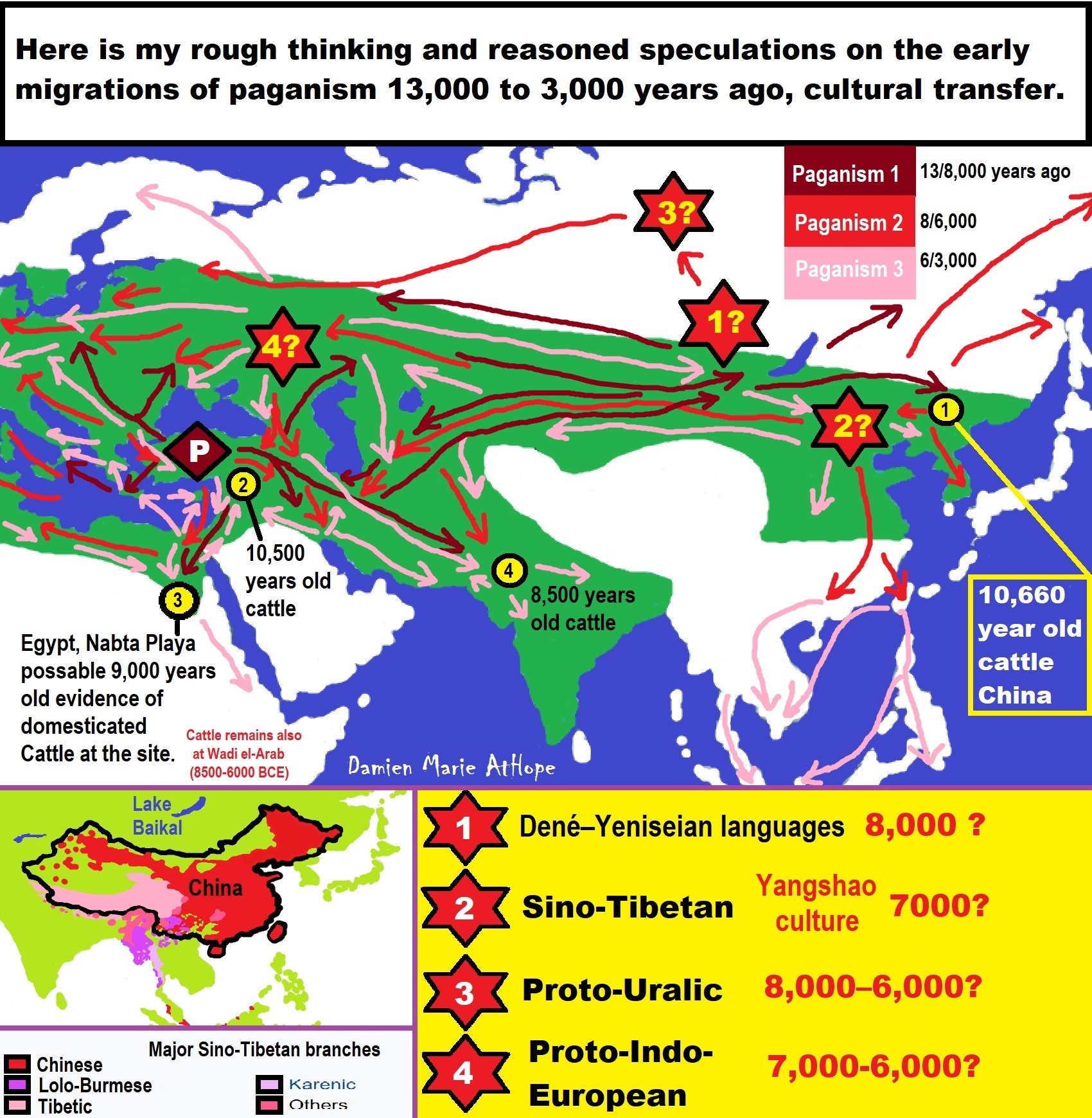
Paganism 12,000-4,000 years old
12,000-7,000 years old: related to (Pre-Capitalism)
7,000-5,000 years old: related to (Capitalism) (World War 0) Elite and their slaves!
5,000 years old: related to (Kings and the Rise of the State)
4,000 years old: related to (First Moralistic gods, then the Origin time of Monotheism)
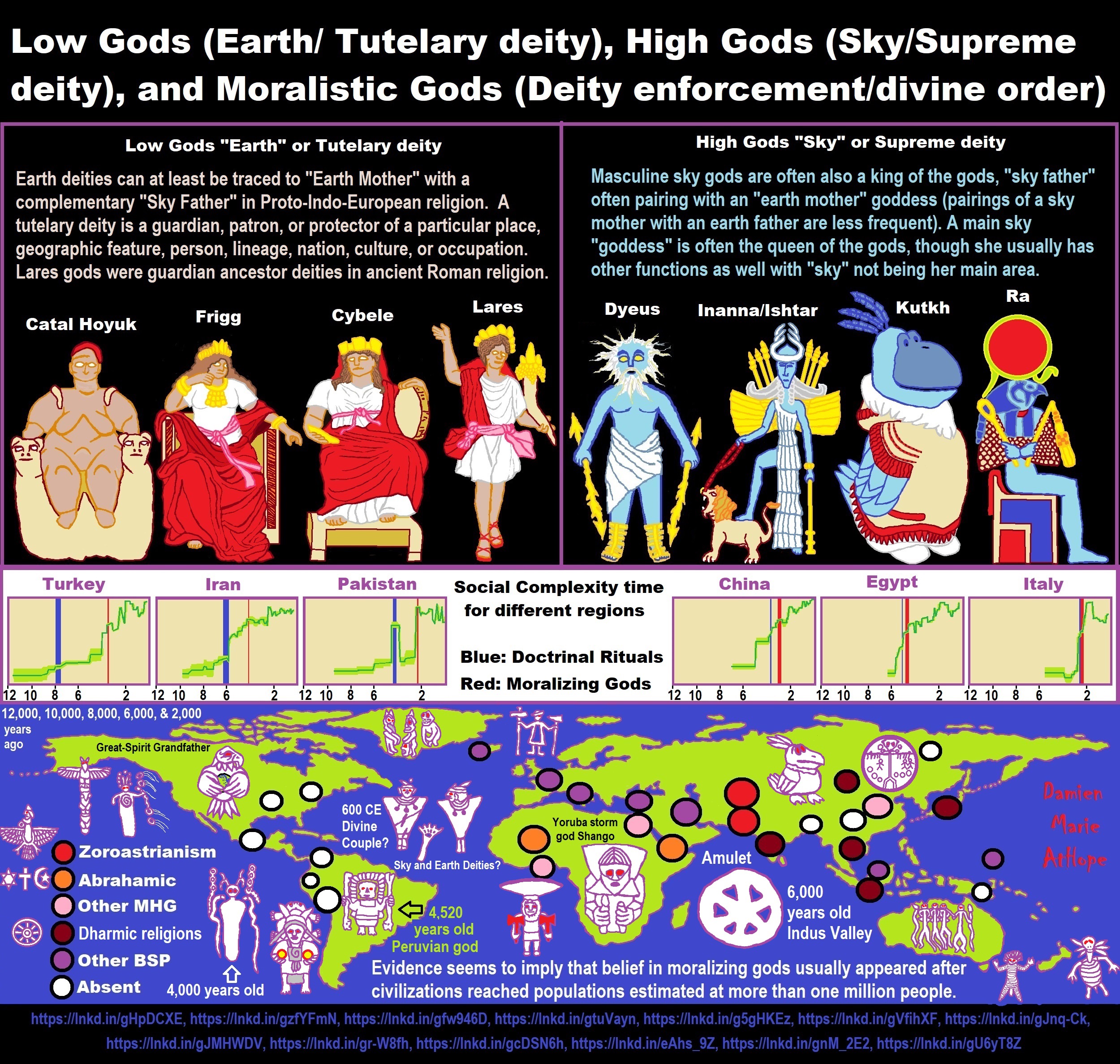
ref, ref, ref, ref, ref, ref, ref, ref, ref, ref, ref, ref, ref, ref, ref, ref, ref, ref, ref, ref, ref
Low Gods “Earth” or Tutelary deity and High Gods “Sky” or Supreme deity
“An Earth goddess is a deification of the Earth. Earth goddesses are often associated with the “chthonic” deities of the underworld. Ki and Ninhursag are Mesopotamian earth goddesses. In Greek mythology, the Earth is personified as Gaia, corresponding to Roman Terra, Indic Prithvi/Bhūmi, etc. traced to an “Earth Mother” complementary to the “Sky Father” in Proto-Indo-European religion. Egyptian mythology exceptionally has a sky goddess and an Earth god.” ref
“A mother goddess is a goddess who represents or is a personification of nature, motherhood, fertility, creation, destruction or who embodies the bounty of the Earth. When equated with the Earth or the natural world, such goddesses are sometimes referred to as Mother Earth or as the Earth Mother. In some religious traditions or movements, Heavenly Mother (also referred to as Mother in Heaven or Sky Mother) is the wife or feminine counterpart of the Sky father or God the Father.” ref
“Any masculine sky god is often also king of the gods, taking the position of patriarch within a pantheon. Such king gods are collectively categorized as “sky father” deities, with a polarity between sky and earth often being expressed by pairing a “sky father” god with an “earth mother” goddess (pairings of a sky mother with an earth father are less frequent). A main sky goddess is often the queen of the gods and may be an air/sky goddess in her own right, though she usually has other functions as well with “sky” not being her main. In antiquity, several sky goddesses in ancient Egypt, Mesopotamia, and the Near East were called Queen of Heaven. Neopagans often apply it with impunity to sky goddesses from other regions who were never associated with the term historically. The sky often has important religious significance. Many religions, both polytheistic and monotheistic, have deities associated with the sky.” ref
“In comparative mythology, sky father is a term for a recurring concept in polytheistic religions of a sky god who is addressed as a “father”, often the father of a pantheon and is often either a reigning or former King of the Gods. The concept of “sky father” may also be taken to include Sun gods with similar characteristics, such as Ra. The concept is complementary to an “earth mother“. “Sky Father” is a direct translation of the Vedic Dyaus Pita, etymologically descended from the same Proto-Indo-European deity name as the Greek Zeûs Pater and Roman Jupiter and Germanic Týr, Tir or Tiwaz, all of which are reflexes of the same Proto-Indo-European deity’s name, *Dyēus Ph₂tḗr. While there are numerous parallels adduced from outside of Indo-European mythology, there are exceptions (e.g. In Egyptian mythology, Nut is the sky mother and Geb is the earth father).” ref
Tutelary deity
“A tutelary (also tutelar) is a deity or spirit who is a guardian, patron, or protector of a particular place, geographic feature, person, lineage, nation, culture, or occupation. The etymology of “tutelary” expresses the concept of safety and thus of guardianship. In late Greek and Roman religion, one type of tutelary deity, the genius, functions as the personal deity or daimon of an individual from birth to death. Another form of personal tutelary spirit is the familiar spirit of European folklore.” ref
“A tutelary (also tutelar) in Korean shamanism, jangseung and sotdae were placed at the edge of villages to frighten off demons. They were also worshiped as deities. Seonangshin is the patron deity of the village in Korean tradition and was believed to embody the Seonangdang. In Philippine animism, Diwata or Lambana are deities or spirits that inhabit sacred places like mountains and mounds and serve as guardians. Such as: Maria Makiling is the deity who guards Mt. Makiling and Maria Cacao and Maria Sinukuan. In Shinto, the spirits, or kami, which give life to human bodies come from nature and return to it after death. Ancestors are therefore themselves tutelaries to be worshiped. And similarly, Native American beliefs such as Tonás, tutelary animal spirit among the Zapotec and Totems, familial or clan spirits among the Ojibwe, can be animals.” ref
“A tutelary (also tutelar) in Austronesian beliefs such as: Atua (gods and spirits of the Polynesian peoples such as the Māori or the Hawaiians), Hanitu (Bunun of Taiwan‘s term for spirit), Hyang (Kawi, Sundanese, Javanese, and Balinese Supreme Being, in ancient Java and Bali mythology and this spiritual entity, can be either divine or ancestral), Kaitiaki (New Zealand Māori term used for the concept of guardianship, for the sky, the sea, and the land), Kawas (mythology) (divided into 6 groups: gods, ancestors, souls of the living, spirits of living things, spirits of lifeless objects, and ghosts), Tiki (Māori mythology, Tiki is the first man created by either Tūmatauenga or Tāne and represents deified ancestors found in most Polynesian cultures). ” ref, ref, ref, ref, ref, ref, ref
Mesopotamian Tutelary Deities can be seen as ones related to City-States
“Historical city-states included Sumerian cities such as Uruk and Ur; Ancient Egyptian city-states, such as Thebes and Memphis; the Phoenician cities (such as Tyre and Sidon); the five Philistine city-states; the Berber city-states of the Garamantes; the city-states of ancient Greece (the poleis such as Athens, Sparta, Thebes, and Corinth); the Roman Republic (which grew from a city-state into a vast empire); the Italian city-states from the Middle Ages to the early modern period, such as Florence, Siena, Ferrara, Milan (which as they grew in power began to dominate neighboring cities) and Genoa and Venice, which became powerful thalassocracies; the Mayan and other cultures of pre-Columbian Mesoamerica (including cities such as Chichen Itza, Tikal, Copán and Monte Albán); the central Asian cities along the Silk Road; the city-states of the Swahili coast; Ragusa; states of the medieval Russian lands such as Novgorod and Pskov; and many others.” ref
“The Uruk period (ca. 4000 to 3100 BCE; also known as Protoliterate period) of Mesopotamia, named after the Sumerian city of Uruk, this period saw the emergence of urban life in Mesopotamia and the Sumerian civilization. City-States like Uruk and others had a patron tutelary City Deity along with a Priest-King.” ref
“Chinese folk religion, both past, and present, includes myriad tutelary deities. Exceptional individuals, highly cultivated sages, and prominent ancestors can be deified and honored after death. Lord Guan is the patron of military personnel and police, while Mazu is the patron of fishermen and sailors. Such as Tu Di Gong (Earth Deity) is the tutelary deity of a locality, and each individual locality has its own Earth Deity and Cheng Huang Gong (City God) is the guardian deity of an individual city, worshipped by local officials and locals since imperial times.” ref
“A tutelary (also tutelar) in Hinduism, personal tutelary deities are known as ishta-devata, while family tutelary deities are known as Kuladevata. Gramadevata are guardian deities of villages. Devas can also be seen as tutelary. Shiva is the patron of yogis and renunciants. City goddesses include: Mumbadevi (Mumbai), Sachchika (Osian); Kuladevis include: Ambika (Porwad), and Mahalakshmi. In NorthEast India Meitei mythology and religion (Sanamahism) of Manipur, there are various types of tutelary deities, among which Lam Lais are the most predominant ones. Tibetan Buddhism has Yidam as a tutelary deity. Dakini is the patron of those who seek knowledge.” ref
“A tutelary (also tutelar) The Greeks also thought deities guarded specific places: for instance, Athena was the patron goddess of the city of Athens. Socrates spoke of hearing the voice of his personal spirit or daimonion:
You have often heard me speak of an oracle or sign which comes to me … . This sign I have had ever since I was a child. The sign is a voice which comes to me and always forbids me to do something which I am going to do, but never commands me to do anything, and this is what stands in the way of my being a politician.” ref
“Tutelary deities who guard and preserve a place or a person are fundamental to ancient Roman religion. The tutelary deity of a man was his Genius, that of a woman her Juno. In the Imperial era, the Genius of the Emperor was a focus of Imperial cult. An emperor might also adopt a major deity as his personal patron or tutelary, as Augustus did Apollo. Precedents for claiming the personal protection of a deity were established in the Republican era, when for instance the Roman dictator Sulla advertised the goddess Victory as his tutelary by holding public games (ludi) in her honor.” ref
“Each town or city had one or more tutelary deities, whose protection was considered particularly vital in time of war and siege. Rome itself was protected by a goddess whose name was to be kept ritually secret on pain of death (for a supposed case, see Quintus Valerius Soranus). The Capitoline Triad of Juno, Jupiter, and Minerva were also tutelaries of Rome. The Italic towns had their own tutelary deities. Juno often had this function, as at the Latin town of Lanuvium and the Etruscan city of Veii, and was often housed in an especially grand temple on the arx (citadel) or other prominent or central location. The tutelary deity of Praeneste was Fortuna, whose oracle was renowned.” ref
“The Roman ritual of evocatio was premised on the belief that a town could be made vulnerable to military defeat if the power of its tutelary deity were diverted outside the city, perhaps by the offer of superior cult at Rome. The depiction of some goddesses such as the Magna Mater (Great Mother, or Cybele) as “tower-crowned” represents their capacity to preserve the city. A town in the provinces might adopt a deity from within the Roman religious sphere to serve as its guardian, or syncretize its own tutelary with such; for instance, a community within the civitas of the Remi in Gaul adopted Apollo as its tutelary, and at the capital of the Remi (present-day Rheims), the tutelary was Mars Camulus.” ref
Household deity (a kind of or related to a Tutelary deity)
“A household deity is a deity or spirit that protects the home, looking after the entire household or certain key members. It has been a common belief in paganism as well as in folklore across many parts of the world. Household deities fit into two types; firstly, a specific deity – typically a goddess – often referred to as a hearth goddess or domestic goddess who is associated with the home and hearth, such as the ancient Greek Hestia.” ref
“The second type of household deities are those that are not one singular deity, but a type, or species of animistic deity, who usually have lesser powers than major deities. This type was common in the religions of antiquity, such as the Lares of ancient Roman religion, the Gashin of Korean shamanism, and Cofgodas of Anglo-Saxon paganism. These survived Christianisation as fairy-like creatures existing in folklore, such as the Anglo-Scottish Brownie and Slavic Domovoy.” ref
“Household deities were usually worshipped not in temples but in the home, where they would be represented by small idols (such as the teraphim of the Bible, often translated as “household gods” in Genesis 31:19 for example), amulets, paintings, or reliefs. They could also be found on domestic objects, such as cosmetic articles in the case of Tawaret. The more prosperous houses might have a small shrine to the household god(s); the lararium served this purpose in the case of the Romans. The gods would be treated as members of the family and invited to join in meals, or be given offerings of food and drink.” ref
“In many religions, both ancient and modern, a god would preside over the home. Certain species, or types, of household deities, existed. An example of this was the Roman Lares. Many European cultures retained house spirits into the modern period. Some examples of these include:
- Brownie (Scotland and England) or Hob (England) / Kobold (Germany) / Goblin / Hobgoblin
- Domovoy (Slavic)
- Nisse (Norwegian or Danish) / Tomte (Swedish) / Tonttu (Finnish)
- Húsvættir (Norse)” ref
“Although the cosmic status of household deities was not as lofty as that of the Twelve Olympians or the Aesir, they were also jealous of their dignity and also had to be appeased with shrines and offerings, however humble. Because of their immediacy they had arguably more influence on the day-to-day affairs of men than the remote gods did. Vestiges of their worship persisted long after Christianity and other major religions extirpated nearly every trace of the major pagan pantheons. Elements of the practice can be seen even today, with Christian accretions, where statues to various saints (such as St. Francis) protect gardens and grottos. Even the gargoyles found on older churches, could be viewed as guardians partitioning a sacred space.” ref
“For centuries, Christianity fought a mop-up war against these lingering minor pagan deities, but they proved tenacious. For example, Martin Luther‘s Tischreden have numerous – quite serious – references to dealing with kobolds. Eventually, rationalism and the Industrial Revolution threatened to erase most of these minor deities, until the advent of romantic nationalism rehabilitated them and embellished them into objects of literary curiosity in the 19th century. Since the 20th century this literature has been mined for characters for role-playing games, video games, and other fantasy personae, not infrequently invested with invented traits and hierarchies somewhat different from their mythological and folkloric roots.” ref
“In contradistinction to both Herbert Spencer and Edward Burnett Tylor, who defended theories of animistic origins of ancestor worship, Émile Durkheim saw its origin in totemism. In reality, this distinction is somewhat academic, since totemism may be regarded as a particularized manifestation of animism, and something of a synthesis of the two positions was attempted by Sigmund Freud. In Freud’s Totem and Taboo, both totem and taboo are outward expressions or manifestations of the same psychological tendency, a concept which is complementary to, or which rather reconciles, the apparent conflict. Freud preferred to emphasize the psychoanalytic implications of the reification of metaphysical forces, but with particular emphasis on its familial nature. This emphasis underscores, rather than weakens, the ancestral component.” ref
“William Edward Hearn, a noted classicist, and jurist, traced the origin of domestic deities from the earliest stages as an expression of animism, a belief system thought to have existed also in the neolithic, and the forerunner of Indo-European religion. In his analysis of the Indo-European household, in Chapter II “The House Spirit”, Section 1, he states:
The belief which guided the conduct of our forefathers was … the spirit rule of dead ancestors.” ref
“In Section 2 he proceeds to elaborate:
It is thus certain that the worship of deceased ancestors is a vera causa, and not a mere hypothesis. …
In the other European nations, the Slavs, the Teutons, and the Kelts, the House Spirit appears with no less distinctness. … [T]he existence of that worship does not admit of doubt. … The House Spirits had a multitude of other names which it is needless here to enumerate, but all of which are more or less expressive of their friendly relations with man. … In [England] … [h]e is the Brownie. … In Scotland this same Brownie is well known. He is usually described as attached to particular families, with whom he has been known to reside for centuries, threshing the corn, cleaning the house, and performing similar household tasks. His favorite gratification was milk and honey.” ref
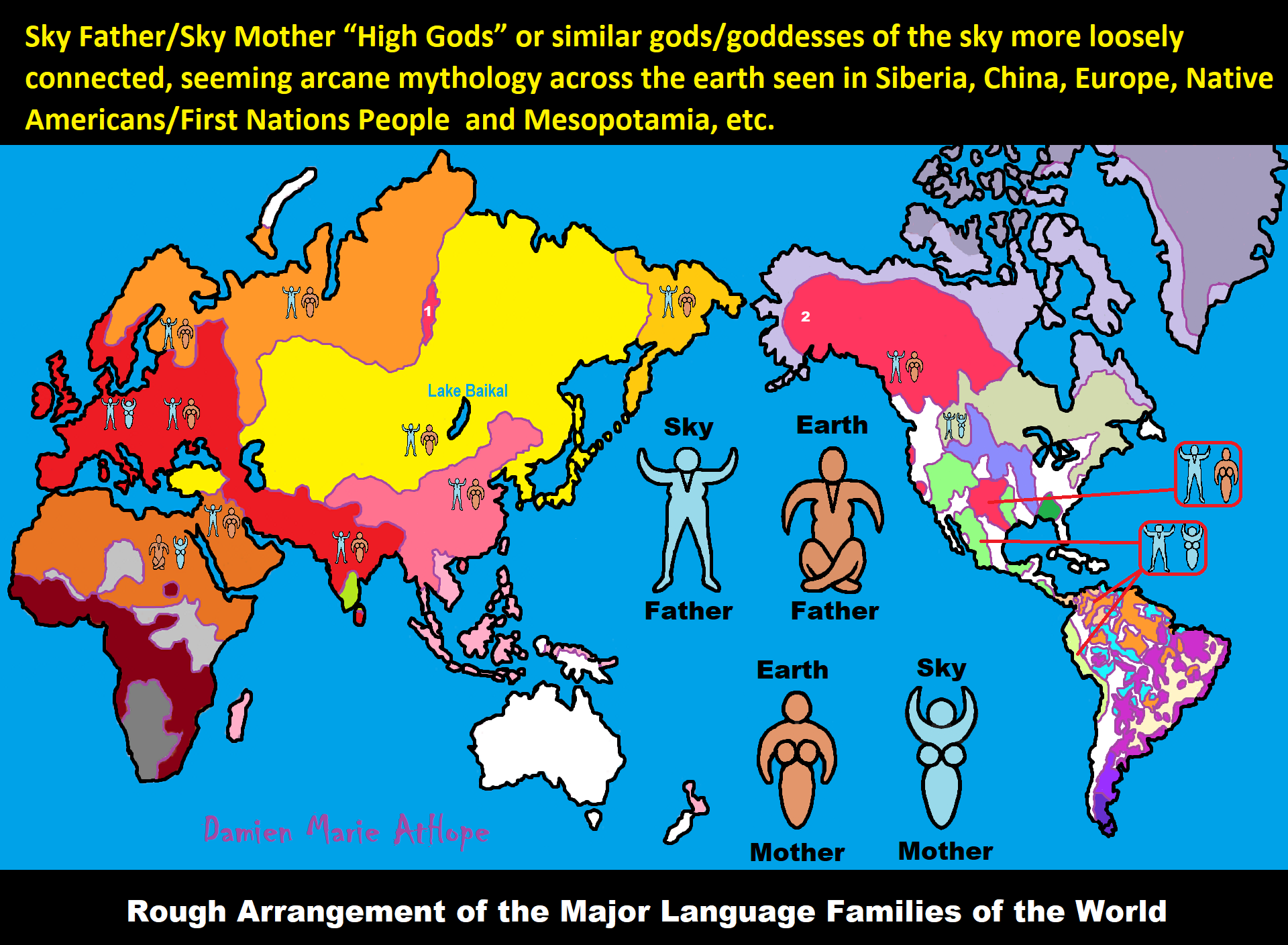
ref, ref, ref, ref, ref, ref, ref, ref, ref, ref, ref, ref, ref, ref, ref, ref, ref
“These ideas are my speculations from the evidence.”
I am still researching the “god‘s origins” all over the world. So you know, it is very complicated but I am smart and willing to look, DEEP, if necessary, which going very deep does seem to be needed here, when trying to actually understand the evolution of gods and goddesses. I am sure of a few things and less sure of others, but even in stuff I am not fully grasping I still am slowly figuring it out, to explain it to others. But as I research more I am understanding things a little better, though I am still working on understanding it all or something close and thus always figuring out more.
Sky Father/Sky God?
“Egyptian: (Nut) Sky Mother and (Geb) Earth Father” (Egypt is different but similar)
Turkic/Mongolic: (Tengri/Tenger Etseg) Sky Father and (Eje/Gazar Eej) Earth Mother *Transeurasian*
Hawaiian: (Wākea) Sky Father and (Papahānaumoku) Earth Mother *Austronesian*
New Zealand/ Māori: (Ranginui) Sky Father and (Papatūānuku) Earth Mother *Austronesian*
Proto-Indo-European: (Dyḗus/Dyḗus ph₂tḗr) Sky Father and (Dʰéǵʰōm/Pleth₂wih₁) Earth Mother
Indo-Aryan: (Dyaus Pita) Sky Father and (Prithvi Mata) Earth Mother *Indo-European*
Italic: (Jupiter) Sky Father and (Juno) Sky Mother *Indo-European*
Etruscan: (Tinia) Sky Father and (Uni) Sky Mother *Tyrsenian/Italy Pre–Indo-European*
Hellenic/Greek: (Zeus) Sky Father and (Hera) Sky Mother who started as an “Earth Goddess” *Indo-European*
Nordic: (Dagr) Sky Father and (Nótt) Sky Mother *Indo-European*
Slavic: (Perun) Sky Father and (Mokosh) Earth Mother *Indo-European*
Illyrian: (Deipaturos) Sky Father and (Messapic Damatura’s “earth-mother” maybe) Earth Mother *Indo-European*
Albanian: (Zojz) Sky Father and (?) *Indo-European*
Baltic: (Perkūnas) Sky Father and (Saulė) Sky Mother *Indo-European*
Germanic: (Týr) Sky Father and (?) *Indo-European*
Colombian-Muisca: (Bochica) Sky Father and (Huythaca) Sky Mother *Chibchan*
Aztec: (Quetzalcoatl) Sky Father and (Xochiquetzal) Sky Mother *Uto-Aztecan*
Incan: (Viracocha) Sky Father and (Mama Runtucaya) Sky Mother *Quechuan*
China: (Tian/Shangdi) Sky Father and (Dì) Earth Mother *Sino-Tibetan*
Sumerian, Assyrian and Babylonian: (An/Anu) Sky Father and (Ki) Earth Mother
Finnish: (Ukko) Sky Father and (Akka) Earth Mother *Finno-Ugric*
Sami: (Horagalles) Sky Father and (Ravdna) Earth Mother *Finno-Ugric*
Puebloan-Zuni: (Ápoyan Ta’chu) Sky Father and (Áwitelin Tsíta) Earth Mother
Puebloan-Hopi: (Tawa) Sky Father and (Kokyangwuti/Spider Woman/Grandmother) Earth Mother *Uto-Aztecan*
Puebloan-Navajo: (Tsohanoai) Sky Father and (Estsanatlehi) Earth Mother *Na-Dene*
ref, ref, ref, ref, ref, ref, ref, ref, ref, ref, ref, ref, ref, ref, ref, ref, ref, ref, ref, ref, ref, ref, ref, ref, ref, ref, ref
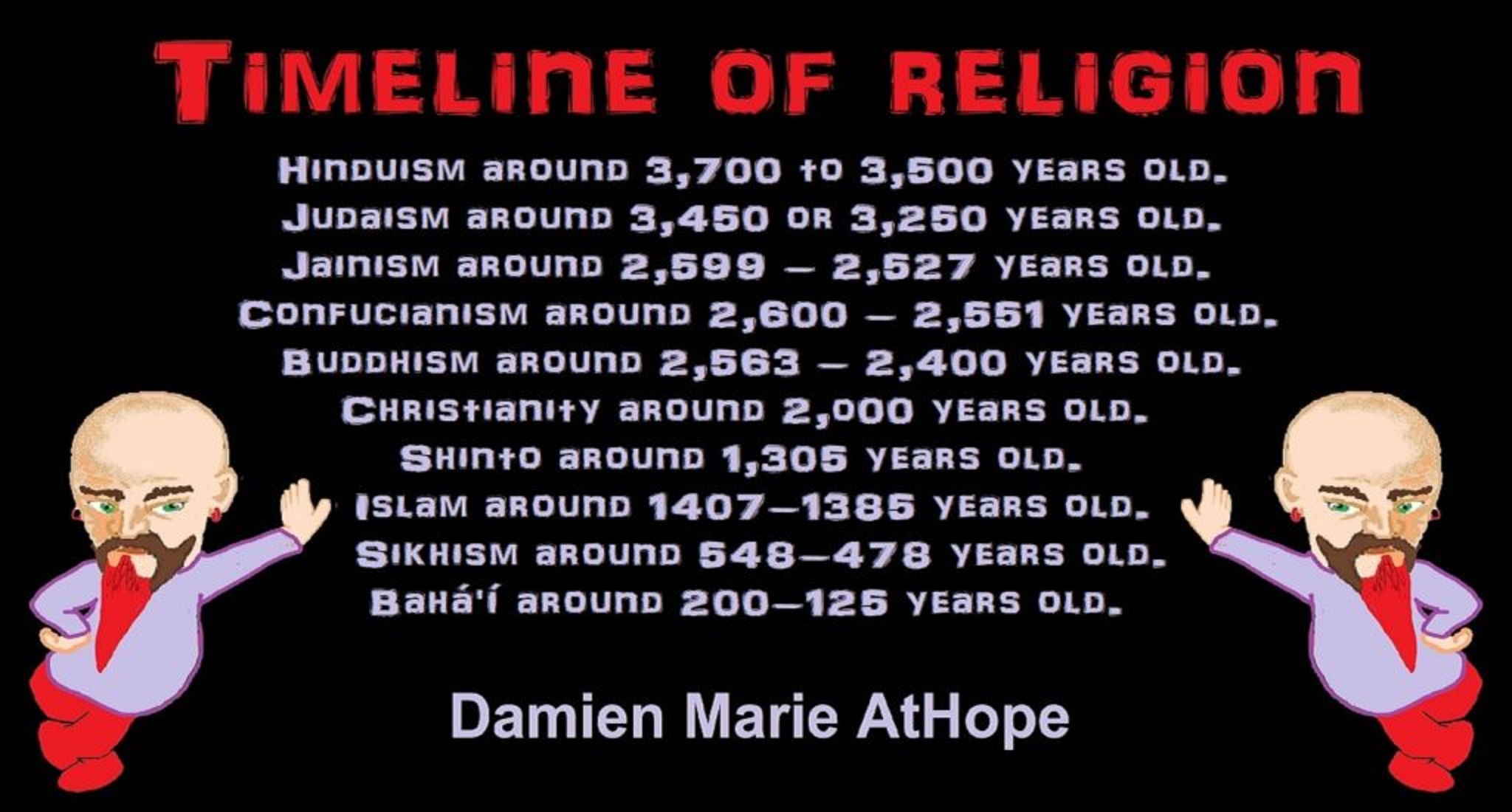
Hinduism around 3,700 to 3,500 years old. ref
Judaism around 3,450 or 3,250 years old. (The first writing in the bible was “Paleo-Hebrew” dated to around 3,000 years ago Khirbet Qeiyafa is the site of an ancient fortress city overlooking the Elah Valley. And many believe the religious Jewish texts were completed around 2,500) ref, ref
Judaism is around 3,450 or 3,250 years old. (“Paleo-Hebrew” 3,000 years ago and Torah 2,500 years ago)
“Judaism is an Abrahamic, its roots as an organized religion in the Middle East during the Bronze Age. Some scholars argue that modern Judaism evolved from Yahwism, the religion of ancient Israel and Judah, by the late 6th century BCE, and is thus considered to be one of the oldest monotheistic religions.” ref
“Yahwism is the name given by modern scholars to the religion of ancient Israel, essentially polytheistic, with a plethora of gods and goddesses. Heading the pantheon was Yahweh, the national god of the Israelite kingdoms of Israel and Judah, with his consort, the goddess Asherah; below them were second-tier gods and goddesses such as Baal, Shamash, Yarikh, Mot, and Astarte, all of whom had their own priests and prophets and numbered royalty among their devotees, and a third and fourth tier of minor divine beings, including the mal’ak, the messengers of the higher gods, who in later times became the angels of Judaism, Christianity and Islam. Yahweh, however, was not the ‘original’ god of Israel “Isra-El”; it is El, the head of the Canaanite pantheon, whose name forms the basis of the name “Israel”, and none of the Old Testament patriarchs, the tribes of Israel, the Judges, or the earliest monarchs, have a Yahwistic theophoric name (i.e., one incorporating the name of Yahweh).” ref
“El is a Northwest Semitic word meaning “god” or “deity“, or referring (as a proper name) to any one of multiple major ancient Near Eastern deities. A rarer form, ‘ila, represents the predicate form in Old Akkadian and in Amorite. The word is derived from the Proto-Semitic *ʔil-, meaning “god”. Specific deities known as ‘El or ‘Il include the supreme god of the ancient Canaanite religion and the supreme god of East Semitic speakers in Mesopotamia’s Early Dynastic Period. ʼĒl is listed at the head of many pantheons. In some Canaanite and Ugaritic sources, ʼĒl played a role as father of the gods, of creation, or both. For example, in the Ugaritic texts, ʾil mlk is understood to mean “ʼĒl the King” but ʾil hd as “the god Hadad“. The Semitic root ʾlh (Arabic ʾilāh, Aramaic ʾAlāh, ʾElāh, Hebrew ʾelōah) may be ʾl with a parasitic h, and ʾl may be an abbreviated form of ʾlh. In Ugaritic the plural form meaning “gods” is ʾilhm, equivalent to Hebrew ʾelōhîm “powers”. In the Hebrew texts this word is interpreted as being semantically singular for “god” by biblical commentators. However the documentary hypothesis for the Old Testament (corresponds to the Jewish Torah) developed originally in the 1870s, identifies these that different authors – the Jahwist, Elohist, Deuteronomist, and the Priestly source – were responsible for editing stories from a polytheistic religion into those of a monotheistic religion. Inconsistencies that arise between monotheism and polytheism in the texts are reflective of this hypothesis.” ref
Jainism around 2,599 – 2,527 years old. ref
Confucianism around 2,600 – 2,551 years old. ref
Buddhism around 2,563/2,480 – 2,483/2,400 years old. ref
Christianity around 2,o00 years old. ref
Shinto around 1,305 years old. ref
Islam around 1407–1385 years old. ref
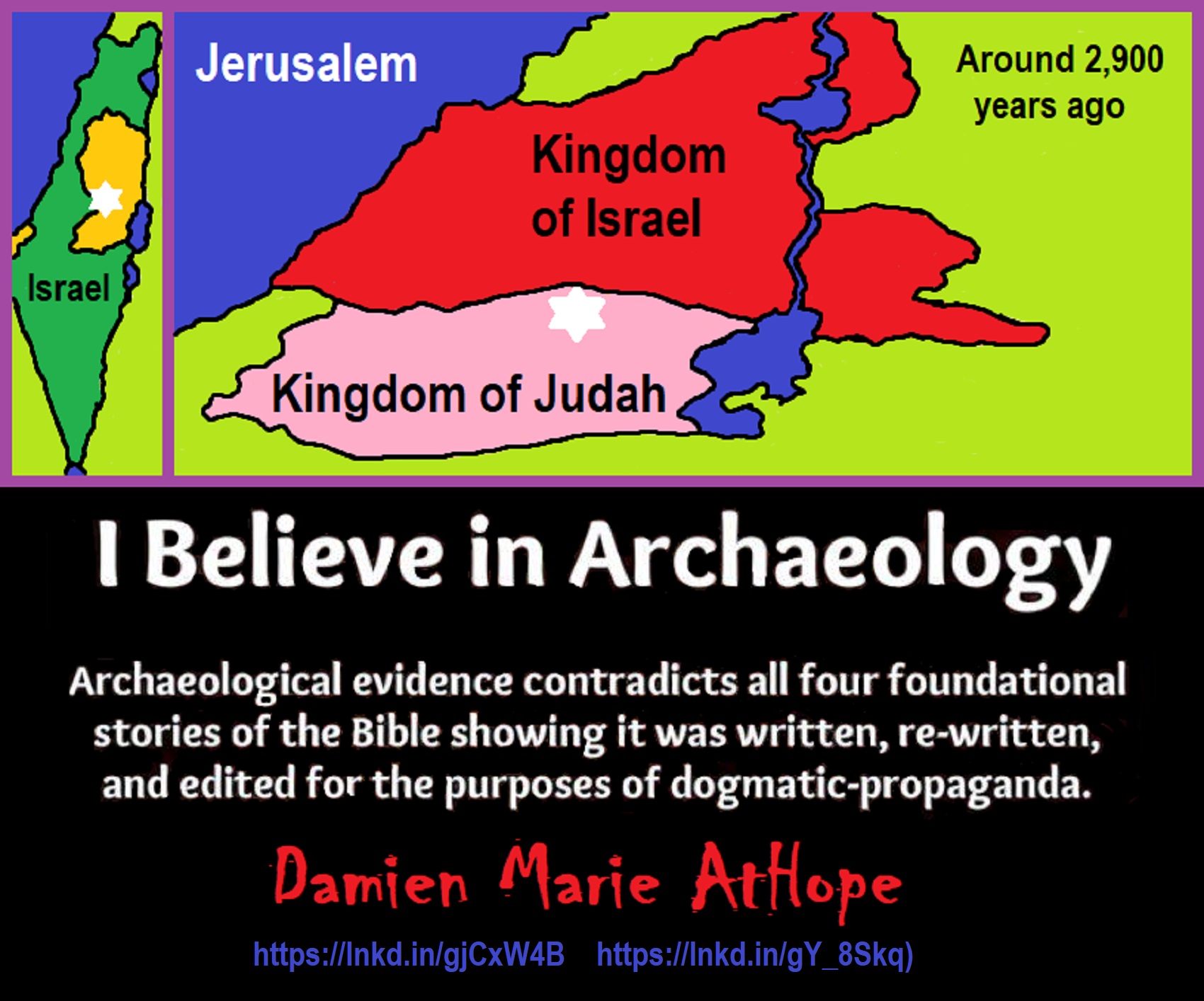
Knowledge to Ponder:
Stars/Astrology:
- Possibly, around 30,000 years ago (in simpler form) to 6,000 years ago, Stars/Astrology are connected to Ancestors, Spirit Animals, and Deities.
- The star also seems to be a possible proto-star for Star of Ishtar, Star of Inanna, or Star of Venus.
- Around 7,000 to 6,000 years ago, Star Constellations/Astrology have connections to the “Kurgan phenomenon” of below-ground “mound” stone/wood burial structures and “Dolmen phenomenon” of above-ground stone burial structures.
- Around 6,500–5,800 years ago, The Northern Levant migrations into Jordon and Israel in the Southern Levant brought new cultural and religious transfer from Turkey and Iran.
- “The Ghassulian Star,” a mysterious 6,000-year-old mural from Jordan may have connections to the European paganstic kurgan/dolmens phenomenon.
“Astrology is a range of divinatory practices, recognized as pseudoscientific since the 18th century, that claim to discern information about human affairs and terrestrial events by studying the apparent positions of celestial objects. Different cultures have employed forms of astrology since at least the 2nd millennium BCE, these practices having originated in calendrical systems used to predict seasonal shifts and to interpret celestial cycles as signs of divine communications. Most, if not all, cultures have attached importance to what they observed in the sky, and some—such as the Hindus, Chinese, and the Maya—developed elaborate systems for predicting terrestrial events from celestial observations. Western astrology, one of the oldest astrological systems still in use, can trace its roots to 19th–17th century BCE Mesopotamia, from where it spread to Ancient Greece, Rome, the Islamicate world and eventually Central and Western Europe. Contemporary Western astrology is often associated with systems of horoscopes that purport to explain aspects of a person’s personality and predict significant events in their lives based on the positions of celestial objects; the majority of professional astrologers rely on such systems.” ref
Around 5,500 years ago, Science evolves, The first evidence of science was 5,500 years ago and was demonstrated by a body of empirical, theoretical, and practical knowledge about the natural world. ref
Around 5,000 years ago, Origin of Logics is a Naturalistic Observation (principles of valid reasoning, inference, & demonstration) ref
Around 4,150 to 4,000 years ago: The earliest surviving versions of the Sumerian Epic of Gilgamesh, which was originally titled “He who Saw the Deep” (Sha naqba īmuru) or “Surpassing All Other Kings” (Shūtur eli sharrī) were written. ref
Hinduism:
- 3,700 years ago or so, the oldest of the Hindu Vedas (scriptures), the Rig Veda was composed.
- 3,500 years ago or so, the Vedic Age began in India after the collapse of the Indus Valley Civilization.
Judaism:
- around 3,000 years ago, the first writing in the bible was “Paleo-Hebrew”
- around 2,500 years ago, many believe the religious Jewish texts were completed
Myths: The bible inspired religion is not just one religion or one myth but a grouping of several religions and myths
- Around 3,450 or 3,250 years ago, according to legend, is the traditionally accepted period in which the Israelite lawgiver, Moses, provided the Ten Commandments.
- Around 2,500 to 2,400 years ago, a collection of ancient religious writings by the Israelites based primarily upon the Hebrew Bible, Tanakh, or Old Testament is the first part of Christianity’s bible.
- Around 2,400 years ago, the most accepted hypothesis is that the canon was formed in stages, first the Pentateuch (Torah).
- Around 2,140 to 2,116 years ago, the Prophets was written during the Hasmonean dynasty, and finally the remaining books.
- Christians traditionally divide the Old Testament into four sections:
- The first five books or Pentateuch (Torah).
- The proposed history books telling the history of the Israelites from their conquest of Canaan to their defeat and exile in Babylon.
- The poetic and proposed “Wisdom books” dealing, in various forms, with questions of good and evil in the world.
- The books of the biblical prophets, warning of the consequences of turning away from God:
- Henotheism:
- Exodus 20:23 “You shall not make other gods besides Me (not saying there are no other gods just not to worship them); gods of silver or gods of gold, you shall not make for yourselves.”
- Polytheism:
- Judges 10:6 “Then the sons of Israel again did evil in the sight of the LORD, served the Baals and the Ashtaroth, the gods of Aram, the gods of Sidon, the gods of Moab, the gods of the sons of Ammon, and the gods of the Philistines; thus they forsook the LORD and did not serve Him.”
- 1 Corinthians 8:5 “For even if there are so-called gods whether in heaven or on earth, as indeed there are many gods and many lords.”
- Monotheism:
- Isaiah 43:10 “You are my witnesses,” declares the LORD, “and my servant whom I have chosen, so that you may know and believe me and understand that I am he. Before me no god was formed, nor will there be one after me.
Around 2,570 to 2,270 Years Ago, there is a confirmation of atheistic doubting as well as atheistic thinking, mainly by Greek philosophers. However, doubting gods is likely as old as the invention of gods and should destroy the thinking that belief in god(s) is the “default belief”. The Greek word is apistos (a “not” and pistos “faithful,”), thus not faithful or faithless because one is unpersuaded and unconvinced by a god(s) claim. Short Definition: unbelieving, unbeliever, or unbelief.
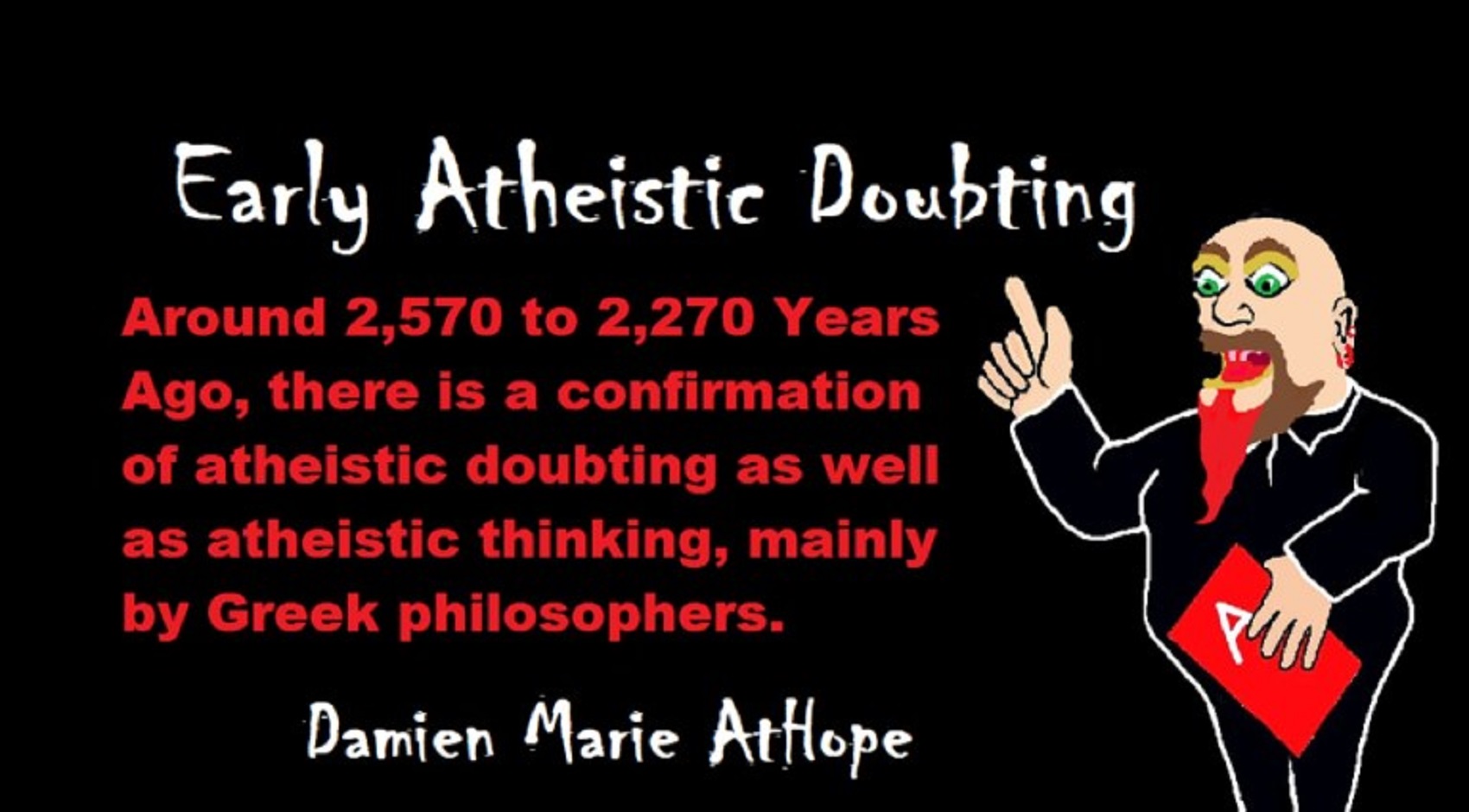
Expressions of Atheistic Thinking:
- Around 2,600 years ago, Ajita Kesakambali, ancient Indian philosopher, who is the first known proponent of Indian materialism. ref
- Around 2,535 to 2,475 years ago, Heraclitus, Greek pre-Socratic philosopher, a native of the Greek city Ephesus, Ionia, on the coast of Anatolia, also known as Asia Minor or modern Turkey. ref
- Around 2,500 to 2,400 years ago, according to The Story of Civilization book series certain African pygmy tribes have no identifiable gods, spirits, or religious beliefs or rituals, and even what burials accrue are without ceremony. ref
- Around 2,490 to 2,430 years ago, Empedocles, Greek pre-Socratic philosopher and a citizen of Agrigentum, a Greek city in Sicily. ref
- Around 2,460 to 2,370 years ago, Democritus, Greek pre-Socratic philosopher considered to be the “father of modern science” possibly had some disbelief amounting to atheism. ref
- Around 2,399 years ago or so, Socrates, a famous Greek philosopher was tried for sinfulness by teaching doubt of state gods. ref
- Around 2,341 to 2,270 years ago, Epicurus, a Greek philosopher known for composing atheistic critics and famously stated, “Is God willing to prevent evil, but not able? Then he is not omnipotent. Is he able, but not willing? Then he is malevolent. Is he both able and willing? Then whence cometh evil? Is he neither able nor willing? Then why call him god?” ref
This last expression by Epicurus, seems to be an expression of Axiological Atheism. To understand and utilize value or actually possess “Value Conscious/Consciousness” to both give a strong moral “axiological” argument (the problem of evil) as well as use it to fortify humanism and positive ethical persuasion of human helping and care responsibilities. Because value-blindness gives rise to sociopathic/psychopathic evil.
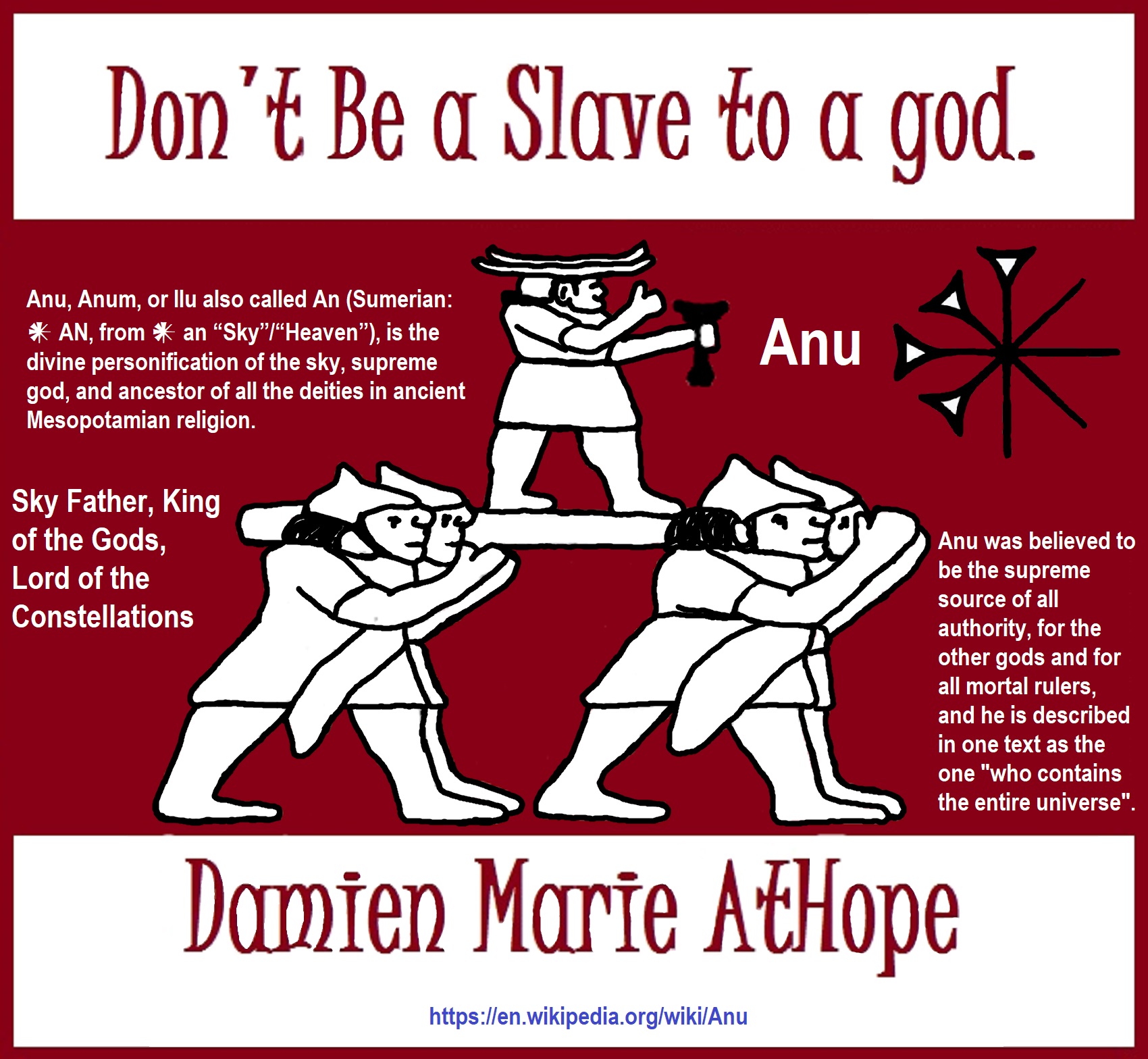
“Theists, there has to be a god, as something can not come from nothing.”
Well, thus something (unknown) happened and then there was something. This does not tell us what the something that may have been involved with something coming from nothing. A supposed first cause, thus something (unknown) happened and then there was something is not an open invitation to claim it as known, neither is it justified to call or label such an unknown as anything, especially an unsubstantiated magical thinking belief born of mythology and religious storytelling.
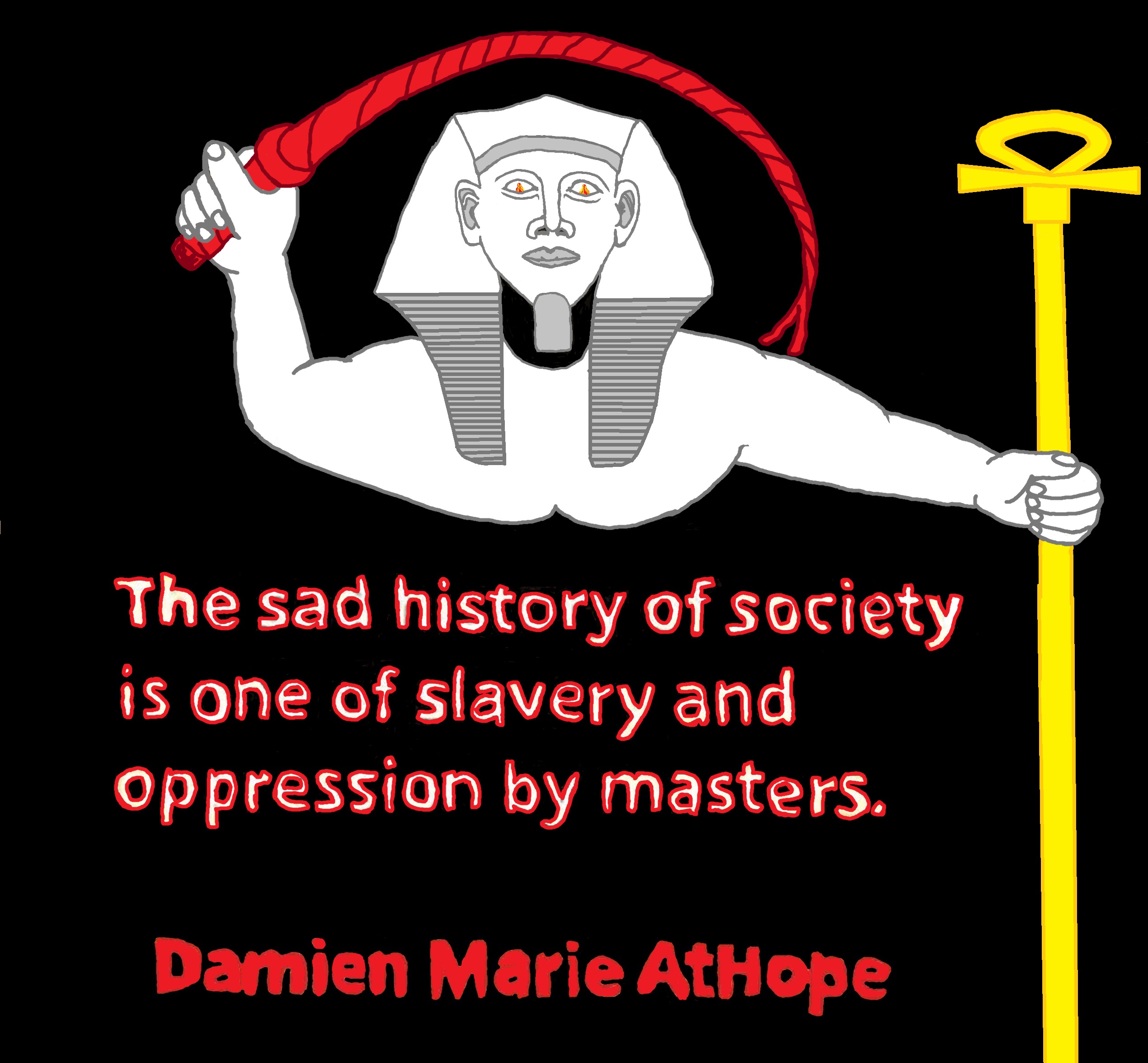
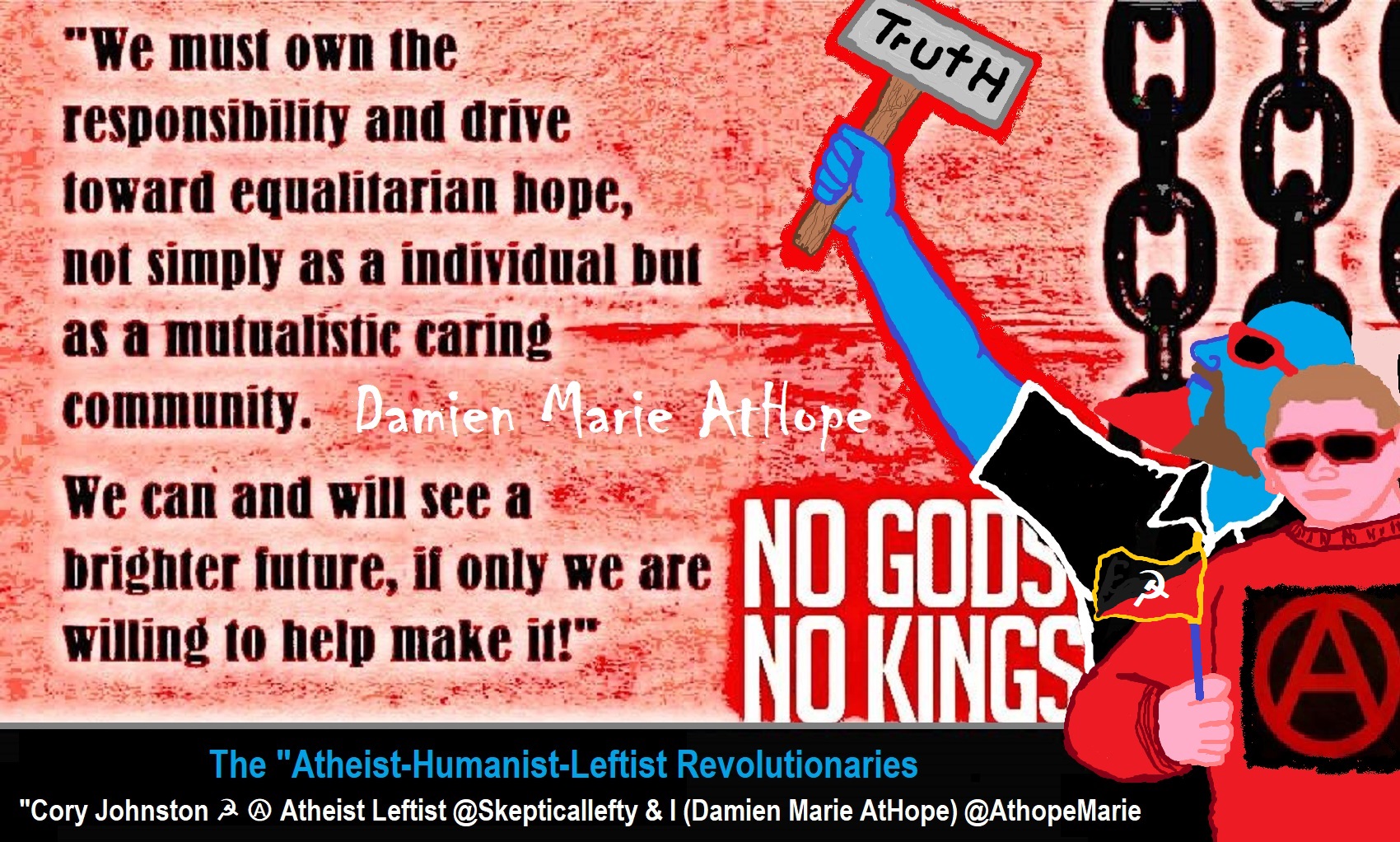
While hallucinogens are associated with shamanism, it is alcohol that is associated with paganism.
The Atheist-Humanist-Leftist Revolutionaries Shows in the prehistory series:
Show two: Pre-animism 300,000 years old and animism 100,000 years old: related to “Anarchism and Socialism”
Show tree: Totemism 50,000 years old: related to “Anarchism and Socialism”
Show four: Shamanism 30,000 years old: related to “Anarchism and Socialism”
Show five: Paganism 12,000 years old: related to “Anarchism and Socialism”
Show six: Emergence of hierarchy, sexism, slavery, and the new male god dominance: Paganism 7,000-5,000 years old: related to “Anarchism and Socialism” (Capitalism) (World War 0) Elite and their slaves!
Prehistory: related to “Anarchism and Socialism” the division of labor, power, rights, and recourses: VIDEO
Pre-animism 300,000 years old and animism 100,000 years old: related to “Anarchism and Socialism”: VIDEO
Totemism 50,000 years old: related to “Anarchism and Socialism”: VIDEO
Shamanism 30,000 years old: related to “Anarchism and Socialism”: VIDEO
Paganism 12,000 years old: related to “Anarchism and Socialism” (Pre-Capitalism): VIDEO
Paganism 7,000-5,000 years old: related to “Anarchism and Socialism” (Capitalism) (World War 0) Elite and their slaves: VIEDO
Paganism 5,000 years old: progressed organized religion and the state: related to “Anarchism and Socialism” (Kings and the Rise of the State): VIEDO
Paganism 4,000 years old: related to “Anarchism and Socialism” (First Moralistic gods, then the Origin time of Monotheism): VIEDO
I do not hate simply because I challenge and expose myths or lies any more than others being thought of as loving simply because of the protection and hiding from challenge their favored myths or lies.
The truth is best championed in the sunlight of challenge.
An archaeologist once said to me “Damien religion and culture are very different”
My response, So are you saying that was always that way, such as would you say Native Americans’ cultures are separate from their religions? And do you think it always was the way you believe?
I had said that religion was a cultural product. That is still how I see it and there are other archaeologists that think close to me as well. Gods too are the myths of cultures that did not understand science or the world around them, seeing magic/supernatural everywhere.
I personally think there is a goddess and not enough evidence to support a male god at Çatalhöyük but if there was both a male and female god and goddess then I know the kind of gods they were like Proto-Indo-European mythology.
This series idea was addressed in, Anarchist Teaching as Free Public Education or Free Education in the Public: VIDEO
Our 12 video series: Organized Oppression: Mesopotamian State Force and the Politics of power (9,000-4,000 years ago), is adapted from: The Complete and Concise History of the Sumerians and Early Bronze Age Mesopotamia (7000-2000 BC): https://www.youtube.com/watch?v=szFjxmY7jQA by “History with Cy“
Show #1: Mesopotamian State Force and the Politics of Power (Samarra, Halaf, Ubaid)
Show #2: Mesopotamian State Force and the Politics of Power
Show #3: Mesopotamian State Force and the Politics of Power (Uruk and the First Cities)
Show #4: Mesopotamian State Force and the Politics of Power (First Kings)
Show #5: Mesopotamian State Force and the Politics of Power (Early Dynastic Period)
Show #6: Mesopotamian State Force and the Politics of Power
Show #7: Mesopotamian State Force and the Politics of Power (Sargon and Akkadian Rule)
Show #9: Mesopotamian State Force and the Politics of Power (Gudea of Lagash and Utu-hegal)
Show #12: Mesopotamian State Force and the Politics of Power (Aftermath and Legacy of Sumer)
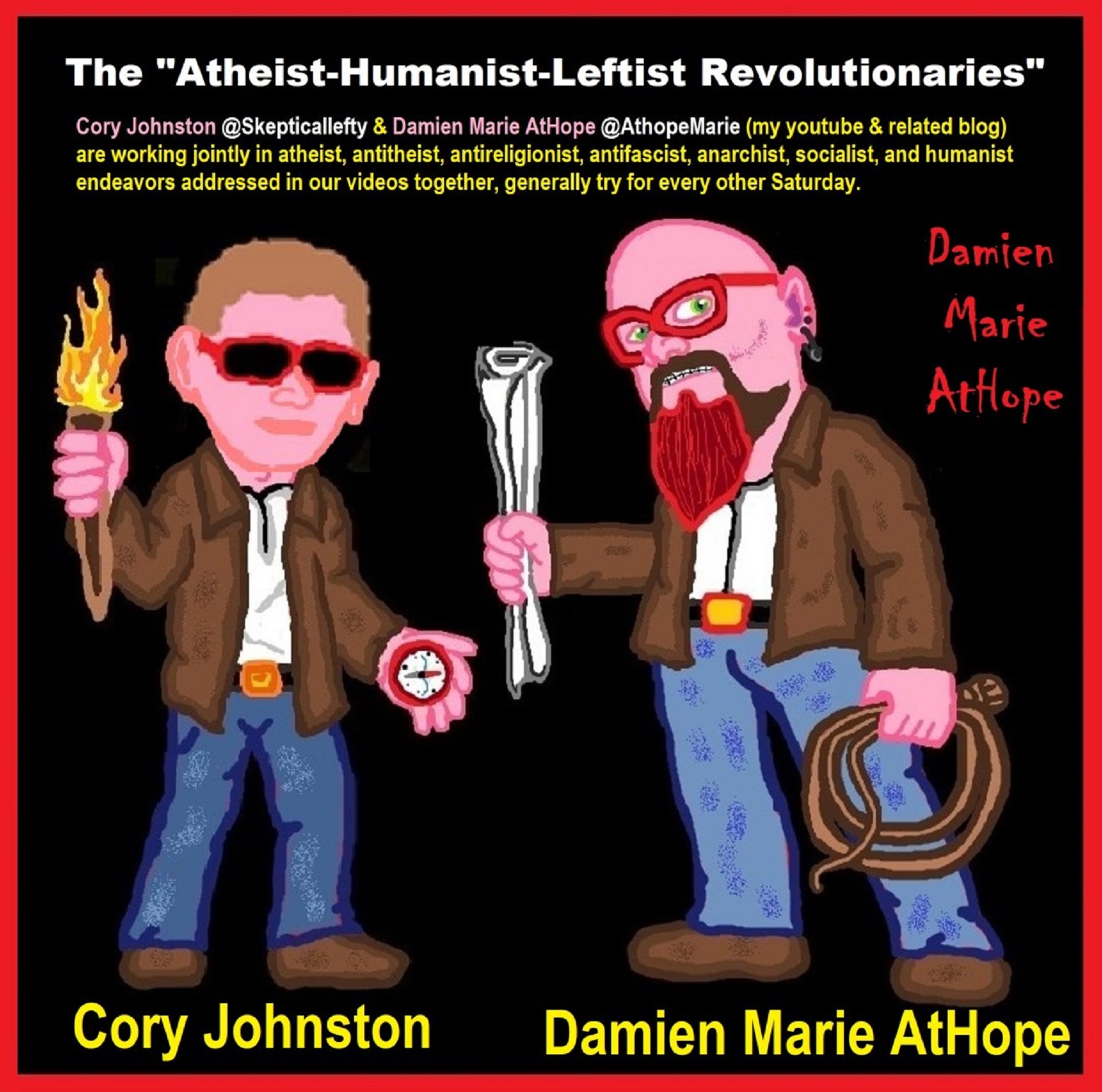
The “Atheist-Humanist-Leftist Revolutionaries”
Cory Johnston ☭ Ⓐ Atheist Leftist @Skepticallefty & I (Damien Marie AtHope) @AthopeMarie (my YouTube & related blog) are working jointly in atheist, antitheist, antireligionist, antifascist, anarchist, socialist, and humanist endeavors in our videos together, generally, every other Saturday.
Why Does Power Bring Responsibility?
Think, how often is it the powerless that start wars, oppress others, or commit genocide? So, I guess the question is to us all, to ask, how can power not carry responsibility in a humanity concept? I know I see the deep ethical responsibility that if there is power their must be a humanistic responsibility of ethical and empathic stewardship of that power. Will I be brave enough to be kind? Will I possess enough courage to be compassionate? Will my valor reach its height of empathy? I as everyone, earns our justified respect by our actions, that are good, ethical, just, protecting, and kind. Do I have enough self-respect to put my love for humanity’s flushing, over being brought down by some of its bad actors? May we all be the ones doing good actions in the world, to help human flourishing.
I create the world I want to live in, striving for flourishing. Which is not a place but a positive potential involvement and promotion; a life of humanist goal precision. To master oneself, also means mastering positive prosocial behaviors needed for human flourishing. I may have lost a god myth as an atheist, but I am happy to tell you, my friend, it is exactly because of that, leaving the mental terrorizer, god belief, that I truly regained my connected ethical as well as kind humanity.
Cory and I will talk about prehistory and theism, addressing the relevance to atheism, anarchism, and socialism.
At the same time as the rise of the male god, 7,000 years ago, there was also the very time there was the rise of violence, war, and clans to kingdoms, then empires, then states. It is all connected back to 7,000 years ago, and it moved across the world.
Cory Johnston: https://damienmarieathope.com/2021/04/cory-johnston-mind-of-a-skeptical-leftist/?v=32aec8db952d
The Mind of a Skeptical Leftist (YouTube)
Cory Johnston: Mind of a Skeptical Leftist @Skepticallefty
The Mind of a Skeptical Leftist By Cory Johnston: “Promoting critical thinking, social justice, and left-wing politics by covering current events and talking to a variety of people. Cory Johnston has been thoughtfully talking to people and attempting to promote critical thinking, social justice, and left-wing politics.” http://anchor.fm/skepticalleft
Cory needs our support. We rise by helping each other.
Cory Johnston ☭ Ⓐ @Skepticallefty Evidence-based atheist leftist (he/him) Producer, host, and co-host of 4 podcasts @skeptarchy @skpoliticspod and @AthopeMarie
Damien Marie AtHope (“At Hope”) Axiological Atheist, Anti-theist, Anti-religionist, Secular Humanist. Rationalist, Writer, Artist, Poet, Philosopher, Advocate, Activist, Psychology, and Armchair Archaeology/Anthropology/Historian.
Damien is interested in: Freedom, Liberty, Justice, Equality, Ethics, Humanism, Science, Atheism, Antiteism, Antireligionism, Ignosticism, Left-Libertarianism, Anarchism, Socialism, Mutualism, Axiology, Metaphysics, LGBTQI, Philosophy, Advocacy, Activism, Mental Health, Psychology, Archaeology, Social Work, Sexual Rights, Marriage Rights, Woman’s Rights, Gender Rights, Child Rights, Secular Rights, Race Equality, Ageism/Disability Equality, Etc. And a far-leftist, “Anarcho-Humanist.”
I am not a good fit in the atheist movement that is mostly pro-capitalist, I am anti-capitalist. Mostly pro-skeptic, I am a rationalist not valuing skepticism. Mostly pro-agnostic, I am anti-agnostic. Mostly limited to anti-Abrahamic religions, I am an anti-religionist.
To me, the “male god” seems to have either emerged or become prominent around 7,000 years ago, whereas the now favored monotheism “male god” is more like 4,000 years ago or so. To me, the “female goddess” seems to have either emerged or become prominent around 11,000-10,000 years ago or so, losing the majority of its once prominence around 2,000 years ago due largely to the now favored monotheism “male god” that grow in prominence after 4,000 years ago or so.
My Thought on the Evolution of Gods?
Animal protector deities from old totems/spirit animal beliefs come first to me, 13,000/12,000 years ago, then women as deities 11,000/10,000 years ago, then male gods around 7,000/8,000 years ago. Moralistic gods around 5,000/4,000 years ago, and monotheistic gods around 4,000/3,000 years ago.
To me, animal gods were likely first related to totemism animals around 13,000 to 12,000 years ago or older. Female as goddesses was next to me, 11,000 to 10,000 years ago or so with the emergence of agriculture. Then male gods come about 8,000 to 7,000 years ago with clan wars. Many monotheism-themed religions started in henotheism, emerging out of polytheism/paganism.
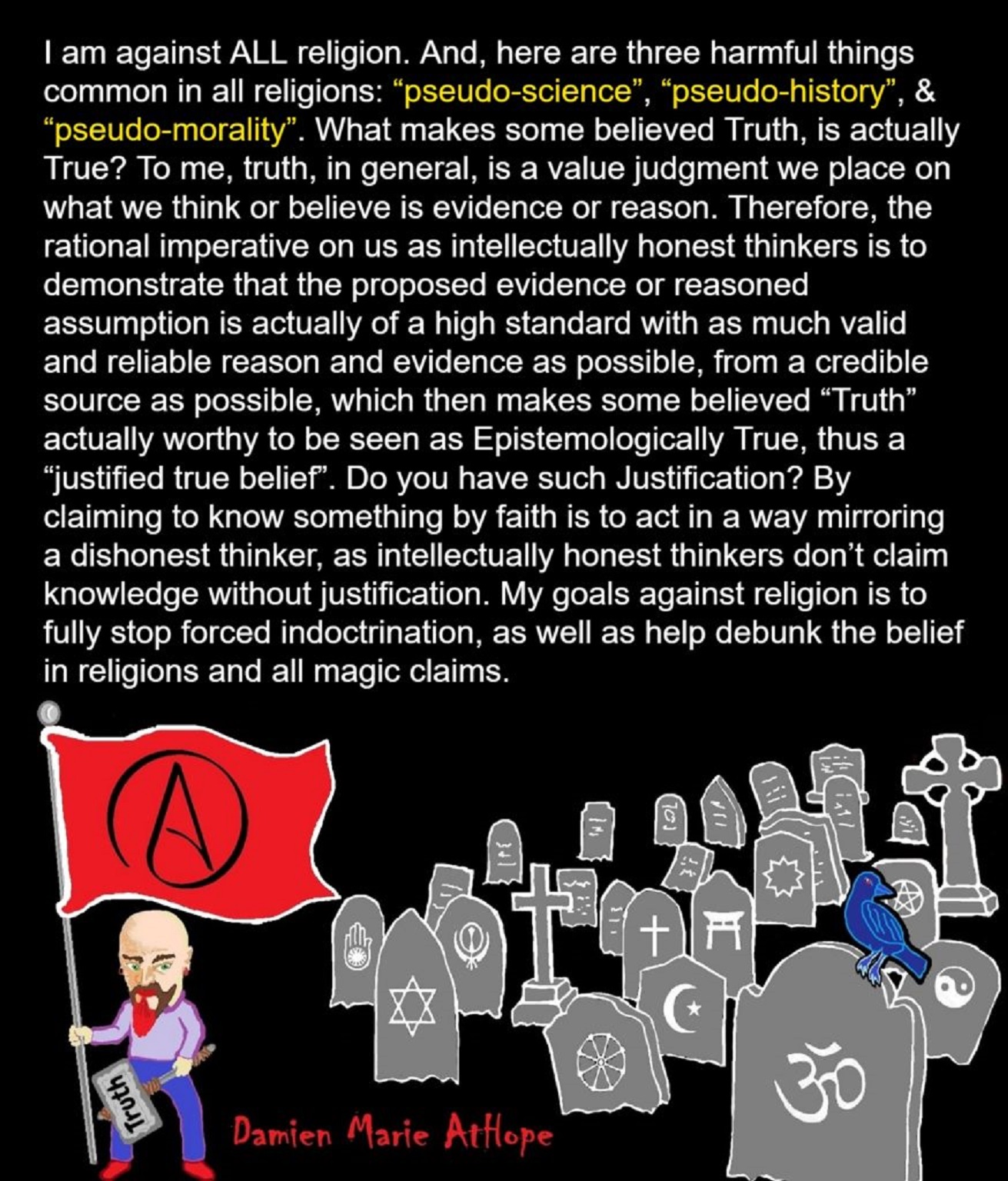
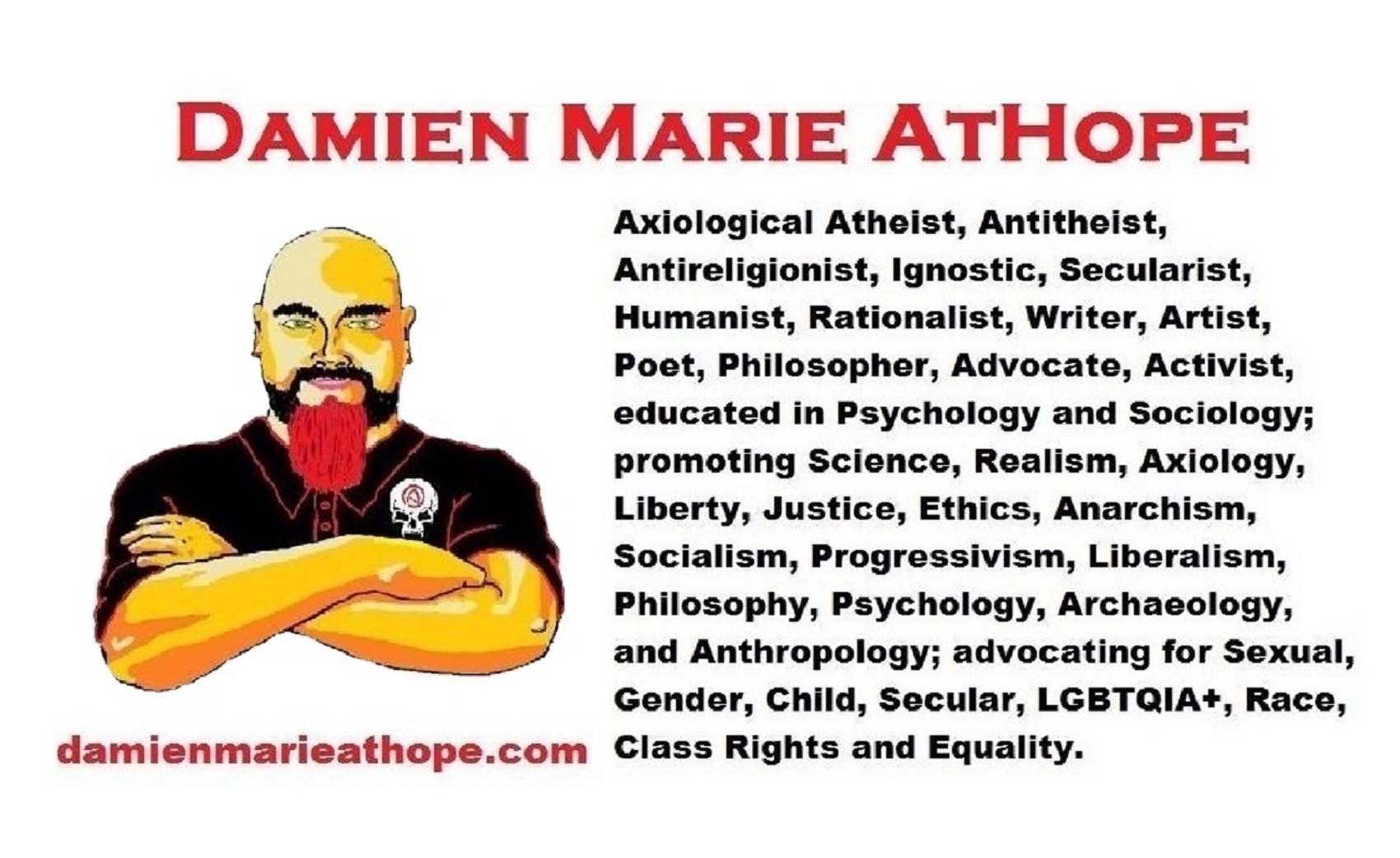
Damien Marie AtHope (Said as “At” “Hope”)/(Autodidact Polymath but not good at math):
Axiological Atheist, Anti-theist, Anti-religionist, Secular Humanist, Rationalist, Writer, Artist, Jeweler, Poet, “autodidact” Philosopher, schooled in Psychology, and “autodidact” Armchair Archaeology/Anthropology/Pre-Historian (Knowledgeable in the range of: 1 million to 5,000/4,000 years ago). I am an anarchist socialist politically. Reasons for or Types of Atheism
My Website, My Blog, & Short-writing or Quotes, My YouTube, Twitter: @AthopeMarie, and My Email: damien.marie.athope@gmail.com
